



Lockheed Martin concept for a sixth-generation conceptaircraft
to replace the F-22 Raptor.
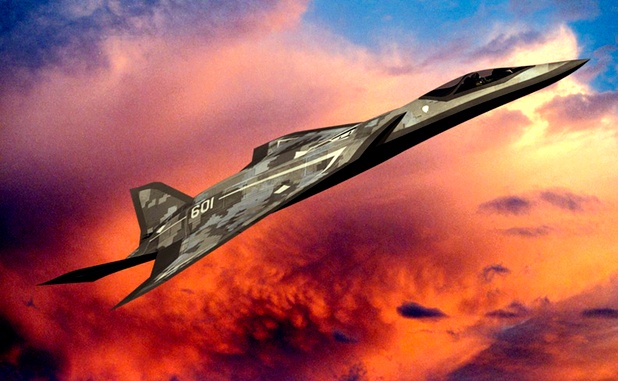
Boeing just unveiled an updated version of its F/A-XX sixth-
generation fighter concept






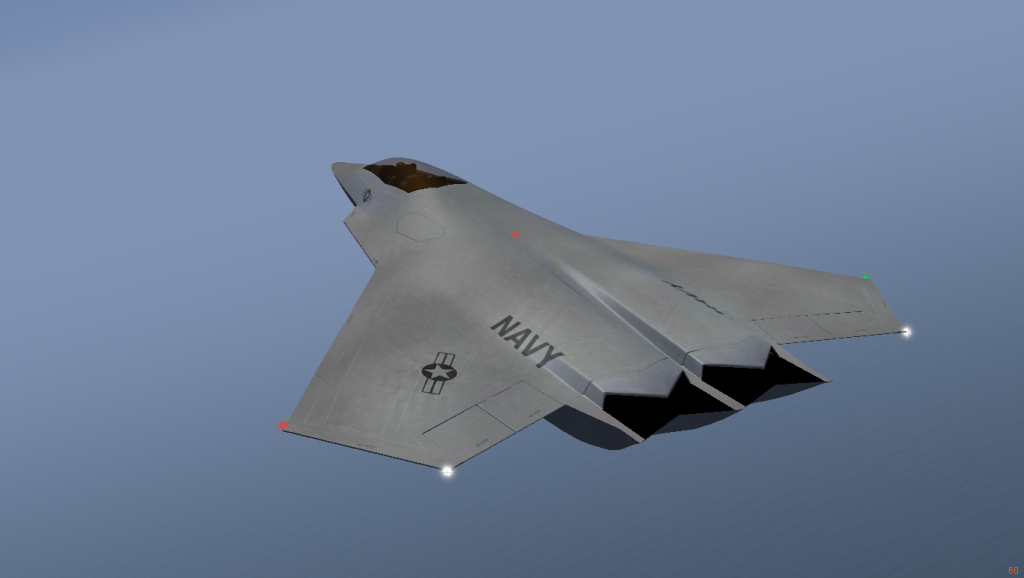
















Propulsion is key to the US Navy's next-generation F/A-XX fighter to replace the service's Boeing F/A-18E/F Super Hornet fleet in the 2030s.
"That's the long-lead item, frankly," says Rear Admiral William Moran, director of the N98 air warfare office at USN headquarters. "In terms of technology it takes you to another place."
The USN will have to engage with industry to determine where the "art
of the possible" might lead the service. "Propulsion has a lot of
benefits, and we know its kind of the critical path to new
developments," he says.
What is clear is that for a next-generation fighter to fly faster,
over greater distances and then persist over a target area, all the
while carrying a greater payload, means that the aircraft will require a
new type of propulsion system, Moran says. That means such a fighter
must be able conserve fuel while it is not operating at peak combat
performance levels.
Next-generation propulsion systems should also be scalable to different applications, Moran says. That would afford the USN some level of commonality on the carrier deck of the future if parts of the air wing could share the same logistical train and skill sets for maintenance crews.
Moran reiterates his Naval Air System Command counterpart's--Rear Admiral Donald Gaddis--comments that the next-generation fighter must have far better kinematic performance and range than existing fighters. That is particularly true in an anti-access/area denial (A2/AD) environment.
"If you look at the A2/AD environment, and that arc, overtime, is going to grow larger. We have to stay ahead of that," Moran says. "So the weapons have to be able fill that. And the only way you're going to do it is have greater kinematics."
That would have to be balanced with stealth and other factors.
The US Air Force and USN are both working on new fighter technologies and may find some benefit from each other's developmental efforts. It is possible that the two services might develop common subsystems but build different airframes based on their divergent needs, he says. But that has yet to be determined.
The USN issued a Request for Information (RfI) for a new fighter to replace the Boeing F/A-18E/F Super Hornet and EA-18G Growler in the 2030s on 13 April.
Next-generation propulsion systems should also be scalable to different applications, Moran says. That would afford the USN some level of commonality on the carrier deck of the future if parts of the air wing could share the same logistical train and skill sets for maintenance crews.
Moran reiterates his Naval Air System Command counterpart's--Rear Admiral Donald Gaddis--comments that the next-generation fighter must have far better kinematic performance and range than existing fighters. That is particularly true in an anti-access/area denial (A2/AD) environment.
"If you look at the A2/AD environment, and that arc, overtime, is going to grow larger. We have to stay ahead of that," Moran says. "So the weapons have to be able fill that. And the only way you're going to do it is have greater kinematics."
That would have to be balanced with stealth and other factors.
The US Air Force and USN are both working on new fighter technologies and may find some benefit from each other's developmental efforts. It is possible that the two services might develop common subsystems but build different airframes based on their divergent needs, he says. But that has yet to be determined.
The USN issued a Request for Information (RfI) for a new fighter to replace the Boeing F/A-18E/F Super Hornet and EA-18G Growler in the 2030s on 13 April.
©Boeing

Here’s Russia’s Badass Next-Generation Stealth Strategic Bomber

http://aviationclub.aero/group/military/
In a meeting with Russian lawmakers, Air Force Commander Lt. Gen. Viktor Bondarev said that all the relevant documents were signed allowing the industry to begin the development of systems for the plane.
With its flying wing shape and radar-evading capabilities, the subsonic PAK-DA is destined to replace Moscow’s aging fleet of 63 Tu-95 Bear and 13 .
According to the RIA Novosti, Russian Air Force commanders insisted that the aircraft will be equipped with advanced electronic warfare systems and armed with new nuclear-capable long-range cruise missiles, and will be able to carry a wide array of conventional precision guided weapons.
The new plane will enter production stage by 2020 with the first bomber in active service by 2025-2030 timeframe.
The PAK-DA will not be hypersonic (even if it will probably carry hypersonic missiles) as opposed to the American X-51, Falcon HTV-2 and other hypersonic development programs on which the U.S.’s perspective strike capability will be based.
A “sixth-generation” pilotless strategic bomber based on the PAK-DA could come around 2040-2050.
Other Concepts



Conceptual drawings of futuristic unmanned fighter jets adorned glossy posters at the Sea-Air-Space Exposition sponsored by the Navy League in early May. And many Navy leaders talk about 2025 or earlier as the target year for those aircraft to join the fleet.
But
the Navy is preparing to keep today’s manned aircraft on carrier decks
well beyond that timeline. Plans are underway to extend the lives of
today’s F/A-18 Super Hornets by 50 percent — from 6,000 flight hours to
9,000.
Considering that most Super
Hornets fly about 350 hours a year under today’s high operational
tempo, the 3,000-hour extension would keep the newest aircraft flying
for at least another 25 years.
And
if the Navy buys another batch of Super Hornets, as senior officials
are suggesting, that means Boeing’s fourth-generation fighter/attack
jet will be deploying on carriers until nearly 2040.
Unmanned Fighters
The
Navy is pressing ahead with the lengthy acquisition process for an
unmanned fighter by issuing a call for private-sector industry to
submit information about a possible “unmanned carrier-launched airborne
surveillance and strike” aircraft.
That
request calls for “limited fleet operational use” by 2018. The Navy’s
defense contractors have responded. At the expo, aviation companies
displayed possibilities beyond the current Navy-funded demonstration
project, the Northrop Grumman X-47B unmanned combat air system. General
Atomics Aeronautical Systems was pushing a carrier version of the
Predator C Avenger. The “Sea Avenger” uses many systems similar to the
Predator and Reapers already in use by the Air Force.
And
Boeing displayed images of its F/A-XX “sixth-generation fighter,”
which the company’s drawings show in both two-seat and unmanned
variants. But those aircraft are still pretty far away. The Navy has
yet to land a large, low-observable unmanned aircraft on a carrier.
Mitsubishi "MEIJI" (明治) Stealth Sixth-Generation Unmanned Combat Aerial Vehicle Advanced Air Supremacy Fighter Drone (OOC: WIP)

"I
am MEIJI, successor to the Anjian (Dark Sword) programme, moreover I am
therein a force to reckon with. Fear me as my artificial intelligence
dominates the skies."
Boeing Bird of Prey
The Bird of Prey was a black project aircraft, intended to demonstrate
stealth technology. It was developed by McDonnell Douglas and Boeing in
the 1990s.[1] Funded by the company at a price of $67 million,[1] it was
a low cost program compared to many other programs of similar scale. It
developed technology and materials which would later be used on
Boeing's X-45 unmanned combat air vehicle. As an internal project, this
aircraft was not given an X-plane designation. There are no public plans
to make this a production aircraft. It is characterized as a technology
demonstrator.
Development of the Bird of Prey began in 1992 by McDonnell Douglas's
Phantom Works division for special projects. The aircraft's name is a
reference to the Klingon Bird of Prey warship from the Star Trek
television series.[2] Phantom Works later became part of Boeing
Integrated Defense Systems
The first flight was in 1996, and 39 more were performed through the
program's conclusion in 1999.[1] The Bird of Prey is designed to prevent
shadows and is believed to have been used to test active camouflage,
which would involve its surfaces changing color or luminosity to match
the surroundings.[3]
Because it was a demonstration aircraft, the Bird of Prey used a
commercial off-the-shelf turbofan engine and manual hydraulic controls
rather than fly-by-wire. This shortened the development time and reduced
the cost significantly (a production aircraft would have computerized
controls).
The shape is aerodynamically stable enough to be flown without computer
correction. Its aerodynamic stability is due to the same mechanisms
found in canard aircraft such as the VariEze, the lift normally
generated by the canards being provided by the chines (which therefore
keeps the nose from sinking). This configuration, which can be stable
without a horizontal tailplane and a conventional vertical rudder, is
now a standard in modern stealth unmanned aerial vehicles such as the
X-45 and X-47, tailless aircraft which use drag rudders
(asymmetrically-used wingtip airbrakes) for rudder control.
The aircraft was made public on October 18, 2002,[1] and was put on
display at the National Museum of the United States Air Force at
Wright-Patterson Air Force Base near Dayton, Ohio on July 16, 2003. It
is on display in the Museum's Modern Flight Gallery. Along with the
XF-85 Goblin, it is the only experimental aircraft that has not been
moved to the Museum's Research & Development Gallery.
General characteristics
Crew: 1
Length: approximately 47 ft (14.30 m)
Wingspan: approximately 23 ft (7.00 m)
Height: 6 ()
Max takeoff weight: 7,380 lb (3,350 kg)
Powerplant: 1� Pratt & Whitney Canada JT15D-5C , 2,900 lbf (12.9 kN)
Performance
Maximum speed: 260 knots (482 km/h)
Service ceiling: 20,000 ft (6,100 m)
US Air Force: The Quest for a Sixth Generation Fighter
Published: January 10, 2012Posted in: Aviation, Featured, Military, Technology

President Obama recently requested from Congress a 2012 defense budget
of $671 billion vs the $683 billion granted in 2011. The budget calls
for $553 billion in the “base budget” and $117.8 billion for the wars in
Iraq and Afghanistan. The Army portion of the base budget is $144.9
billion, the Navy and Marine Corps portion is $161.4 billion, and the
Air Force share is set at $150 billion. In 2011 the Air Force budget was
higher, at $170.6 billion. Under the bipartisan budget agreement
reached last August, the 2013 defense budget will average the same level
as in 2008. For the rest of the decade, the budget will only grow with
inflation resulting in a $487 billion reduction from the growth the administration had planned over the next 10 years.
In the 2011 defense budget, the F-35 Joint Strike Fighter, a 5th generation fighter, was one of the most costly program with a budget of $11.5 billion. The fiscal 2012 budget requests a reorganization of the F-35 joint strike fighter program with more funds for research and development for the fifth-generation fighter and defers procurement to the out years. Still, DOD will receive 32 of the planes in fiscal 2012. The United States intends to buy a total of 2,443 F-35 aircraft for an estimated US$323 billion, making it the most expensive defense program ever.
As a reminder, the F-35 Lightning II replaced De Facto the F-22 Raptor, both from Lockheed Martin, when the DOD ceased F-22 orders in April 2009. The high cost of the aircraft (US$150 million a unit vs US$122 million for an F-35A ), delays in the Russian and Chinese fifth-generation fighter programs (Respectively the Russian Sukhoi PAK FA (T-50) which will replace by 2016 MiG-29 and Su-27 , and the Chinese Chengdu J-20 by 2017 which will probably replace their J-10 and JF-17), a US ban on Raptor exports, and the ongoing development of the planned cheaper and more versatile F-35 resulted in calls to end F-22 production.
In this context, the announcement of Lockheed Martin’s Skunk Works division of next-generation fighter to be delivered by 2030, sounds intriguing. Before the announcement, the USAF considers the F-22 aircraft as unmatched by any known or projected fighter. A zoom on the F22 vs F35 characteristics and capabilities can be used as a reference to foresee the capabilities of the next generation of fighters (Source Air Force Association – AFA).
 Besides the budget considerations and the pros and cons that led to
halt the F22 production and focus on the F-35, probably one of the very
interesting points to analyze in this announcement, is the technological
trends and features of the next generation of fighters, the sixth one.
Besides the budget considerations and the pros and cons that led to
halt the F22 production and focus on the F-35, probably one of the very
interesting points to analyze in this announcement, is the technological
trends and features of the next generation of fighters, the sixth one.
According to Flight Global, Lockheed stated that its “next-generation fighter should include “greatly increased speed”, more range and new features like self-healing structures and multi-spectral stealth”. Such capabilities must be supported by new breakthroughs in propulsion, materials, power generation and weapons, Lockheed said, adding some of these are “yet to be fully imagined”.
Air Force magazine provides an interesting classification of the different fighter generation with their capabilities which may hint to some of the possible technologies that the 6th generation will embed.
Generation 1: Jet propulsion (F-80, German Me 262).
Generation 2: Swept wings; range-only radar; infrared missiles (F-86, MiG-15).
Generation 3: Supersonic speed; pulse radar; able to shoot at targets beyond visual range (“Century Series” fighters such as F-105; F-4; MiG-17; MiG-21).
Generation 4: Pulse-doppler radar; high maneuverability; look-down, shoot-down missiles (F-15, F-16, Mirage 2000, MiG-29).
Generation 4+: High agility; sensor fusion; reduced signatures (Eurofighter Typhoon, Su-30, advanced versions of F-16 and F/A-18, Rafale).
Generation 4++: Active electronically scanned arrays; continued reduced signatures or some “active” (waveform canceling) stealth; some supercruise (Su-35, F-15SE).
Generation 5: All-aspect stealth with internal weapons, extreme agility, full-sensor fusion, integrated avionics, some or full supercruise (F-22, F-35).
One of the most interesting aspects in the Lockheed Martin’s Skunk Works division announcement, is the concept of self-healing structures. Self-healing materials are a class of smart materials that have the structurally incorporated ability to repair damage caused by mechanical. In case of fighters, a Structural Health Monitoring (SHM) may, for example, be coupled with a self-healing composite structure to repair damages and adapt the flight envelope.
The future is definitely very interesting.
Sources: Flight Global, USAF, Air Force Magazine, Wikipedia, Air Force Association (AFA) Adaptive structures: engineering applications By David Wagg.
Photo Credits: Lockheed Martin, Flight Global.
- See more at: http://www.capfalcon.net/2012/01/10/us-air-force-the-quest-for-a-sixth-generation-fighter/#sthash.cAfNObXP.dpufIn the 2011 defense budget, the F-35 Joint Strike Fighter, a 5th generation fighter, was one of the most costly program with a budget of $11.5 billion. The fiscal 2012 budget requests a reorganization of the F-35 joint strike fighter program with more funds for research and development for the fifth-generation fighter and defers procurement to the out years. Still, DOD will receive 32 of the planes in fiscal 2012. The United States intends to buy a total of 2,443 F-35 aircraft for an estimated US$323 billion, making it the most expensive defense program ever.
As a reminder, the F-35 Lightning II replaced De Facto the F-22 Raptor, both from Lockheed Martin, when the DOD ceased F-22 orders in April 2009. The high cost of the aircraft (US$150 million a unit vs US$122 million for an F-35A ), delays in the Russian and Chinese fifth-generation fighter programs (Respectively the Russian Sukhoi PAK FA (T-50) which will replace by 2016 MiG-29 and Su-27 , and the Chinese Chengdu J-20 by 2017 which will probably replace their J-10 and JF-17), a US ban on Raptor exports, and the ongoing development of the planned cheaper and more versatile F-35 resulted in calls to end F-22 production.
In this context, the announcement of Lockheed Martin’s Skunk Works division of next-generation fighter to be delivered by 2030, sounds intriguing. Before the announcement, the USAF considers the F-22 aircraft as unmatched by any known or projected fighter. A zoom on the F22 vs F35 characteristics and capabilities can be used as a reference to foresee the capabilities of the next generation of fighters (Source Air Force Association – AFA).

According to Flight Global, Lockheed stated that its “next-generation fighter should include “greatly increased speed”, more range and new features like self-healing structures and multi-spectral stealth”. Such capabilities must be supported by new breakthroughs in propulsion, materials, power generation and weapons, Lockheed said, adding some of these are “yet to be fully imagined”.
Air Force magazine provides an interesting classification of the different fighter generation with their capabilities which may hint to some of the possible technologies that the 6th generation will embed.
Air Force Magazine – Different Generation of Fighters
Fighter Generations
The definition of fighter generations has long been subject to
debate. However, most agree that the generations break down along these
broad lines:Generation 1: Jet propulsion (F-80, German Me 262).
Generation 2: Swept wings; range-only radar; infrared missiles (F-86, MiG-15).
Generation 3: Supersonic speed; pulse radar; able to shoot at targets beyond visual range (“Century Series” fighters such as F-105; F-4; MiG-17; MiG-21).
Generation 4: Pulse-doppler radar; high maneuverability; look-down, shoot-down missiles (F-15, F-16, Mirage 2000, MiG-29).
Generation 4+: High agility; sensor fusion; reduced signatures (Eurofighter Typhoon, Su-30, advanced versions of F-16 and F/A-18, Rafale).
Generation 4++: Active electronically scanned arrays; continued reduced signatures or some “active” (waveform canceling) stealth; some supercruise (Su-35, F-15SE).
Generation 5: All-aspect stealth with internal weapons, extreme agility, full-sensor fusion, integrated avionics, some or full supercruise (F-22, F-35).
Potential Generation 6: extreme
stealth; efficient in all flight regimes (subsonic to multi-Mach);
possible “morphing” capability; smart skins; highly networked; extremely
sensitive sensors; optionally manned; directed energy weapons.
F22 Raptor on Discovery Channel’s “Ultimate Strike Planes” documentary.
In a presolicitation notice
states, from November 4, 2010, the USAF states that: “The envisioned
system may possess enhanced capabilities in areas such as reach,
persistence, survivability, net-centricity, situational awareness,
human-system integration, and weapons effects. The primary mission in
the future Next Gen TACAIR (Next Generation Tactical Aircraft)
definition is Offensive and Defensive Counterair to include subset
missions including Integrated Air and Missile Defense (IAMD), Close Air
Support (CAS) and Air Interdiction (AI). It may also fulfill airborne
electronic attack and intelligence-surveillance-reconnaissance
capabilities. This is not an all-inclusive list and the Next Gen TACAIR
definition will mature and sharpen as the market research and
Capabilities Based Assessment (CBA) unfold. The ongoing CBA is
assessing potential capability gaps, while this CRFI will support a
concurrent market research assessment. The future system will have to
counter adversaries equipped with next generation advanced electronic
attack, sophisticated integrated air defense systems, passive detection,
integrated self-protection, directed energy weapons, and cyber attack
capabilities. It must be able to operate in the anti-access/area-denial
environment that will exist in the 2030-2050 time-frame.”One of the most interesting aspects in the Lockheed Martin’s Skunk Works division announcement, is the concept of self-healing structures. Self-healing materials are a class of smart materials that have the structurally incorporated ability to repair damage caused by mechanical. In case of fighters, a Structural Health Monitoring (SHM) may, for example, be coupled with a self-healing composite structure to repair damages and adapt the flight envelope.
The future is definitely very interesting.
Sources: Flight Global, USAF, Air Force Magazine, Wikipedia, Air Force Association (AFA) Adaptive structures: engineering applications By David Wagg.
Photo Credits: Lockheed Martin, Flight Global.
US Air Force: The Quest for a Sixth Generation Fighter
Published: January 10, 2012Posted in: Aviation, Featured, Military, Technology

President Obama recently requested from Congress a 2012 defense budget
of $671 billion vs the $683 billion granted in 2011. The budget calls
for $553 billion in the “base budget” and $117.8 billion for the wars in
Iraq and Afghanistan. The Army portion of the base budget is $144.9
billion, the Navy and Marine Corps portion is $161.4 billion, and the
Air Force share is set at $150 billion. In 2011 the Air Force budget was
higher, at $170.6 billion. Under the bipartisan budget agreement
reached last August, the 2013 defense budget will average the same level
as in 2008. For the rest of the decade, the budget will only grow with
inflation resulting in a $487 billion reduction from the growth the administration had planned over the next 10 years.
In the 2011 defense budget, the F-35 Joint Strike Fighter, a 5th generation fighter, was one of the most costly program with a budget of $11.5 billion. The fiscal 2012 budget requests a reorganization of the F-35 joint strike fighter program with more funds for research and development for the fifth-generation fighter and defers procurement to the out years. Still, DOD will receive 32 of the planes in fiscal 2012. The United States intends to buy a total of 2,443 F-35 aircraft for an estimated US$323 billion, making it the most expensive defense program ever.
As a reminder, the F-35 Lightning II replaced De Facto the F-22 Raptor, both from Lockheed Martin, when the DOD ceased F-22 orders in April 2009. The high cost of the aircraft (US$150 million a unit vs US$122 million for an F-35A ), delays in the Russian and Chinese fifth-generation fighter programs (Respectively the Russian Sukhoi PAK FA (T-50) which will replace by 2016 MiG-29 and Su-27 , and the Chinese Chengdu J-20 by 2017 which will probably replace their J-10 and JF-17), a US ban on Raptor exports, and the ongoing development of the planned cheaper and more versatile F-35 resulted in calls to end F-22 production.
In this context, the announcement of Lockheed Martin’s Skunk Works division of next-generation fighter to be delivered by 2030, sounds intriguing. Before the announcement, the USAF considers the F-22 aircraft as unmatched by any known or projected fighter. A zoom on the F22 vs F35 characteristics and capabilities can be used as a reference to foresee the capabilities of the next generation of fighters (Source Air Force Association – AFA).
 Besides the budget considerations and the pros and cons that led to
halt the F22 production and focus on the F-35, probably one of the very
interesting points to analyze in this announcement, is the technological
trends and features of the next generation of fighters, the sixth one.
Besides the budget considerations and the pros and cons that led to
halt the F22 production and focus on the F-35, probably one of the very
interesting points to analyze in this announcement, is the technological
trends and features of the next generation of fighters, the sixth one.
According to Flight Global, Lockheed stated that its “next-generation fighter should include “greatly increased speed”, more range and new features like self-healing structures and multi-spectral stealth”. Such capabilities must be supported by new breakthroughs in propulsion, materials, power generation and weapons, Lockheed said, adding some of these are “yet to be fully imagined”.
Air Force magazine provides an interesting classification of the different fighter generation with their capabilities which may hint to some of the possible technologies that the 6th generation will embed.
Generation 1: Jet propulsion (F-80, German Me 262).
Generation 2: Swept wings; range-only radar; infrared missiles (F-86, MiG-15).
Generation 3: Supersonic speed; pulse radar; able to shoot at targets beyond visual range (“Century Series” fighters such as F-105; F-4; MiG-17; MiG-21).
Generation 4: Pulse-doppler radar; high maneuverability; look-down, shoot-down missiles (F-15, F-16, Mirage 2000, MiG-29).
Generation 4+: High agility; sensor fusion; reduced signatures (Eurofighter Typhoon, Su-30, advanced versions of F-16 and F/A-18, Rafale).
Generation 4++: Active electronically scanned arrays; continued reduced signatures or some “active” (waveform canceling) stealth; some supercruise (Su-35, F-15SE).
Generation 5: All-aspect stealth with internal weapons, extreme agility, full-sensor fusion, integrated avionics, some or full supercruise (F-22, F-35).
One of the most interesting aspects in the Lockheed Martin’s Skunk Works division announcement, is the concept of self-healing structures. Self-healing materials are a class of smart materials that have the structurally incorporated ability to repair damage caused by mechanical. In case of fighters, a Structural Health Monitoring (SHM) may, for example, be coupled with a self-healing composite structure to repair damages and adapt the flight envelope.
The future is definitely very interesting.
Sources: Flight Global, USAF, Air Force Magazine, Wikipedia, Air Force Association (AFA) Adaptive structures: engineering applications By David Wagg.
Photo Credits: Lockheed Martin, Flight Global.
- See more at: http://www.capfalcon.net/2012/01/10/us-air-force-the-quest-for-a-sixth-generation-fighter/#sthash.cAfNObXP.dpufIn the 2011 defense budget, the F-35 Joint Strike Fighter, a 5th generation fighter, was one of the most costly program with a budget of $11.5 billion. The fiscal 2012 budget requests a reorganization of the F-35 joint strike fighter program with more funds for research and development for the fifth-generation fighter and defers procurement to the out years. Still, DOD will receive 32 of the planes in fiscal 2012. The United States intends to buy a total of 2,443 F-35 aircraft for an estimated US$323 billion, making it the most expensive defense program ever.
As a reminder, the F-35 Lightning II replaced De Facto the F-22 Raptor, both from Lockheed Martin, when the DOD ceased F-22 orders in April 2009. The high cost of the aircraft (US$150 million a unit vs US$122 million for an F-35A ), delays in the Russian and Chinese fifth-generation fighter programs (Respectively the Russian Sukhoi PAK FA (T-50) which will replace by 2016 MiG-29 and Su-27 , and the Chinese Chengdu J-20 by 2017 which will probably replace their J-10 and JF-17), a US ban on Raptor exports, and the ongoing development of the planned cheaper and more versatile F-35 resulted in calls to end F-22 production.
In this context, the announcement of Lockheed Martin’s Skunk Works division of next-generation fighter to be delivered by 2030, sounds intriguing. Before the announcement, the USAF considers the F-22 aircraft as unmatched by any known or projected fighter. A zoom on the F22 vs F35 characteristics and capabilities can be used as a reference to foresee the capabilities of the next generation of fighters (Source Air Force Association – AFA).

According to Flight Global, Lockheed stated that its “next-generation fighter should include “greatly increased speed”, more range and new features like self-healing structures and multi-spectral stealth”. Such capabilities must be supported by new breakthroughs in propulsion, materials, power generation and weapons, Lockheed said, adding some of these are “yet to be fully imagined”.
Air Force magazine provides an interesting classification of the different fighter generation with their capabilities which may hint to some of the possible technologies that the 6th generation will embed.
Air Force Magazine – Different Generation of Fighters
Fighter Generations
The definition of fighter generations has long been subject to
debate. However, most agree that the generations break down along these
broad lines:Generation 1: Jet propulsion (F-80, German Me 262).
Generation 2: Swept wings; range-only radar; infrared missiles (F-86, MiG-15).
Generation 3: Supersonic speed; pulse radar; able to shoot at targets beyond visual range (“Century Series” fighters such as F-105; F-4; MiG-17; MiG-21).
Generation 4: Pulse-doppler radar; high maneuverability; look-down, shoot-down missiles (F-15, F-16, Mirage 2000, MiG-29).
Generation 4+: High agility; sensor fusion; reduced signatures (Eurofighter Typhoon, Su-30, advanced versions of F-16 and F/A-18, Rafale).
Generation 4++: Active electronically scanned arrays; continued reduced signatures or some “active” (waveform canceling) stealth; some supercruise (Su-35, F-15SE).
Generation 5: All-aspect stealth with internal weapons, extreme agility, full-sensor fusion, integrated avionics, some or full supercruise (F-22, F-35).
Potential Generation 6: extreme
stealth; efficient in all flight regimes (subsonic to multi-Mach);
possible “morphing” capability; smart skins; highly networked; extremely
sensitive sensors; optionally manned; directed energy weapons.
F22 Raptor on Discovery Channel’s “Ultimate Strike Planes” documentary.
In a presolicitation notice
states, from November 4, 2010, the USAF states that: “The envisioned
system may possess enhanced capabilities in areas such as reach,
persistence, survivability, net-centricity, situational awareness,
human-system integration, and weapons effects. The primary mission in
the future Next Gen TACAIR (Next Generation Tactical Aircraft)
definition is Offensive and Defensive Counterair to include subset
missions including Integrated Air and Missile Defense (IAMD), Close Air
Support (CAS) and Air Interdiction (AI). It may also fulfill airborne
electronic attack and intelligence-surveillance-reconnaissance
capabilities. This is not an all-inclusive list and the Next Gen TACAIR
definition will mature and sharpen as the market research and
Capabilities Based Assessment (CBA) unfold. The ongoing CBA is
assessing potential capability gaps, while this CRFI will support a
concurrent market research assessment. The future system will have to
counter adversaries equipped with next generation advanced electronic
attack, sophisticated integrated air defense systems, passive detection,
integrated self-protection, directed energy weapons, and cyber attack
capabilities. It must be able to operate in the anti-access/area-denial
environment that will exist in the 2030-2050 time-frame.”One of the most interesting aspects in the Lockheed Martin’s Skunk Works division announcement, is the concept of self-healing structures. Self-healing materials are a class of smart materials that have the structurally incorporated ability to repair damage caused by mechanical. In case of fighters, a Structural Health Monitoring (SHM) may, for example, be coupled with a self-healing composite structure to repair damages and adapt the flight envelope.
The future is definitely very interesting.
Sources: Flight Global, USAF, Air Force Magazine, Wikipedia, Air Force Association (AFA) Adaptive structures: engineering applications By David Wagg.
Photo Credits: Lockheed Martin, Flight Global.
US Air Force: The Quest for a Sixth Generation Fighter
Published: January 10, 2012Posted in: Aviation, Featured, Military, Technology

President Obama recently requested from Congress a 2012 defense budget
of $671 billion vs the $683 billion granted in 2011. The budget calls
for $553 billion in the “base budget” and $117.8 billion for the wars in
Iraq and Afghanistan. The Army portion of the base budget is $144.9
billion, the Navy and Marine Corps portion is $161.4 billion, and the
Air Force share is set at $150 billion. In 2011 the Air Force budget was
higher, at $170.6 billion. Under the bipartisan budget agreement
reached last August, the 2013 defense budget will average the same level
as in 2008. For the rest of the decade, the budget will only grow with
inflation resulting in a $487 billion reduction from the growth the administration had planned over the next 10 years.
In the 2011 defense budget, the F-35 Joint Strike Fighter, a 5th generation fighter, was one of the most costly program with a budget of $11.5 billion. The fiscal 2012 budget requests a reorganization of the F-35 joint strike fighter program with more funds for research and development for the fifth-generation fighter and defers procurement to the out years. Still, DOD will receive 32 of the planes in fiscal 2012. The United States intends to buy a total of 2,443 F-35 aircraft for an estimated US$323 billion, making it the most expensive defense program ever.
As a reminder, the F-35 Lightning II replaced De Facto the F-22 Raptor, both from Lockheed Martin, when the DOD ceased F-22 orders in April 2009. The high cost of the aircraft (US$150 million a unit vs US$122 million for an F-35A ), delays in the Russian and Chinese fifth-generation fighter programs (Respectively the Russian Sukhoi PAK FA (T-50) which will replace by 2016 MiG-29 and Su-27 , and the Chinese Chengdu J-20 by 2017 which will probably replace their J-10 and JF-17), a US ban on Raptor exports, and the ongoing development of the planned cheaper and more versatile F-35 resulted in calls to end F-22 production.
In this context, the announcement of Lockheed Martin’s Skunk Works division of next-generation fighter to be delivered by 2030, sounds intriguing. Before the announcement, the USAF considers the F-22 aircraft as unmatched by any known or projected fighter. A zoom on the F22 vs F35 characteristics and capabilities can be used as a reference to foresee the capabilities of the next generation of fighters (Source Air Force Association – AFA).
 Besides the budget considerations and the pros and cons that led to
halt the F22 production and focus on the F-35, probably one of the very
interesting points to analyze in this announcement, is the technological
trends and features of the next generation of fighters, the sixth one.
Besides the budget considerations and the pros and cons that led to
halt the F22 production and focus on the F-35, probably one of the very
interesting points to analyze in this announcement, is the technological
trends and features of the next generation of fighters, the sixth one.
According to Flight Global, Lockheed stated that its “next-generation fighter should include “greatly increased speed”, more range and new features like self-healing structures and multi-spectral stealth”. Such capabilities must be supported by new breakthroughs in propulsion, materials, power generation and weapons, Lockheed said, adding some of these are “yet to be fully imagined”.
Air Force magazine provides an interesting classification of the different fighter generation with their capabilities which may hint to some of the possible technologies that the 6th generation will embed.
Generation 1: Jet propulsion (F-80, German Me 262).
Generation 2: Swept wings; range-only radar; infrared missiles (F-86, MiG-15).
Generation 3: Supersonic speed; pulse radar; able to shoot at targets beyond visual range (“Century Series” fighters such as F-105; F-4; MiG-17; MiG-21).
Generation 4: Pulse-doppler radar; high maneuverability; look-down, shoot-down missiles (F-15, F-16, Mirage 2000, MiG-29).
Generation 4+: High agility; sensor fusion; reduced signatures (Eurofighter Typhoon, Su-30, advanced versions of F-16 and F/A-18, Rafale).
Generation 4++: Active electronically scanned arrays; continued reduced signatures or some “active” (waveform canceling) stealth; some supercruise (Su-35, F-15SE).
Generation 5: All-aspect stealth with internal weapons, extreme agility, full-sensor fusion, integrated avionics, some or full supercruise (F-22, F-35).
One of the most interesting aspects in the Lockheed Martin’s Skunk Works division announcement, is the concept of self-healing structures. Self-healing materials are a class of smart materials that have the structurally incorporated ability to repair damage caused by mechanical. In case of fighters, a Structural Health Monitoring (SHM) may, for example, be coupled with a self-healing composite structure to repair damages and adapt the flight envelope.
The future is definitely very interesting.
Sources: Flight Global, USAF, Air Force Magazine, Wikipedia, Air Force Association (AFA) Adaptive structures: engineering applications By David Wagg.
Photo Credits: Lockheed Martin, Flight Global.
- See more at: http://www.capfalcon.net/2012/01/10/us-air-force-the-quest-for-a-sixth-generation-fighter/#sthash.cAfNObXP.dpufIn the 2011 defense budget, the F-35 Joint Strike Fighter, a 5th generation fighter, was one of the most costly program with a budget of $11.5 billion. The fiscal 2012 budget requests a reorganization of the F-35 joint strike fighter program with more funds for research and development for the fifth-generation fighter and defers procurement to the out years. Still, DOD will receive 32 of the planes in fiscal 2012. The United States intends to buy a total of 2,443 F-35 aircraft for an estimated US$323 billion, making it the most expensive defense program ever.
As a reminder, the F-35 Lightning II replaced De Facto the F-22 Raptor, both from Lockheed Martin, when the DOD ceased F-22 orders in April 2009. The high cost of the aircraft (US$150 million a unit vs US$122 million for an F-35A ), delays in the Russian and Chinese fifth-generation fighter programs (Respectively the Russian Sukhoi PAK FA (T-50) which will replace by 2016 MiG-29 and Su-27 , and the Chinese Chengdu J-20 by 2017 which will probably replace their J-10 and JF-17), a US ban on Raptor exports, and the ongoing development of the planned cheaper and more versatile F-35 resulted in calls to end F-22 production.
In this context, the announcement of Lockheed Martin’s Skunk Works division of next-generation fighter to be delivered by 2030, sounds intriguing. Before the announcement, the USAF considers the F-22 aircraft as unmatched by any known or projected fighter. A zoom on the F22 vs F35 characteristics and capabilities can be used as a reference to foresee the capabilities of the next generation of fighters (Source Air Force Association – AFA).

According to Flight Global, Lockheed stated that its “next-generation fighter should include “greatly increased speed”, more range and new features like self-healing structures and multi-spectral stealth”. Such capabilities must be supported by new breakthroughs in propulsion, materials, power generation and weapons, Lockheed said, adding some of these are “yet to be fully imagined”.
Air Force magazine provides an interesting classification of the different fighter generation with their capabilities which may hint to some of the possible technologies that the 6th generation will embed.
Air Force Magazine – Different Generation of Fighters
Fighter Generations
The definition of fighter generations has long been subject to
debate. However, most agree that the generations break down along these
broad lines:Generation 1: Jet propulsion (F-80, German Me 262).
Generation 2: Swept wings; range-only radar; infrared missiles (F-86, MiG-15).
Generation 3: Supersonic speed; pulse radar; able to shoot at targets beyond visual range (“Century Series” fighters such as F-105; F-4; MiG-17; MiG-21).
Generation 4: Pulse-doppler radar; high maneuverability; look-down, shoot-down missiles (F-15, F-16, Mirage 2000, MiG-29).
Generation 4+: High agility; sensor fusion; reduced signatures (Eurofighter Typhoon, Su-30, advanced versions of F-16 and F/A-18, Rafale).
Generation 4++: Active electronically scanned arrays; continued reduced signatures or some “active” (waveform canceling) stealth; some supercruise (Su-35, F-15SE).
Generation 5: All-aspect stealth with internal weapons, extreme agility, full-sensor fusion, integrated avionics, some or full supercruise (F-22, F-35).
Potential Generation 6: extreme
stealth; efficient in all flight regimes (subsonic to multi-Mach);
possible “morphing” capability; smart skins; highly networked; extremely
sensitive sensors; optionally manned; directed energy weapons.
F22 Raptor on Discovery Channel’s “Ultimate Strike Planes” documentary.
In a presolicitation notice
states, from November 4, 2010, the USAF states that: “The envisioned
system may possess enhanced capabilities in areas such as reach,
persistence, survivability, net-centricity, situational awareness,
human-system integration, and weapons effects. The primary mission in
the future Next Gen TACAIR (Next Generation Tactical Aircraft)
definition is Offensive and Defensive Counterair to include subset
missions including Integrated Air and Missile Defense (IAMD), Close Air
Support (CAS) and Air Interdiction (AI). It may also fulfill airborne
electronic attack and intelligence-surveillance-reconnaissance
capabilities. This is not an all-inclusive list and the Next Gen TACAIR
definition will mature and sharpen as the market research and
Capabilities Based Assessment (CBA) unfold. The ongoing CBA is
assessing potential capability gaps, while this CRFI will support a
concurrent market research assessment. The future system will have to
counter adversaries equipped with next generation advanced electronic
attack, sophisticated integrated air defense systems, passive detection,
integrated self-protection, directed energy weapons, and cyber attack
capabilities. It must be able to operate in the anti-access/area-denial
environment that will exist in the 2030-2050 time-frame.”One of the most interesting aspects in the Lockheed Martin’s Skunk Works division announcement, is the concept of self-healing structures. Self-healing materials are a class of smart materials that have the structurally incorporated ability to repair damage caused by mechanical. In case of fighters, a Structural Health Monitoring (SHM) may, for example, be coupled with a self-healing composite structure to repair damages and adapt the flight envelope.
The future is definitely very interesting.
Sources: Flight Global, USAF, Air Force Magazine, Wikipedia, Air Force Association (AFA) Adaptive structures: engineering applications By David Wagg.
Photo Credits: Lockheed Martin, Flight Global.
The Lockheed f-35 beat this one in the JSF competition
The X-32 takes off for Naval Air Station Patuxent River, MD, from Little Rock AFB. The X-32 is one of two experimental aircraft involved in the Joint Strike Fighter (JSF) program.
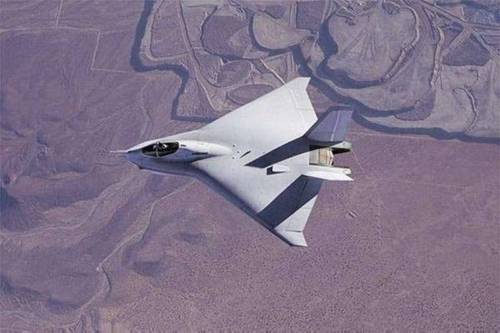

Boeing X-32B on display at the Patuxent River Naval Air Museum. This lost the Joint Strike Fighter competition to Lockheed Martin's X-35 (now the F-35 Lightning II), with the testing conducted at the nearby Naval Air Station Patuxent River. A Lockheed S-3B Viking is in the background.
General characteristics
Crew: 1
Length: 50.77 ft (15.47 m)
Wingspan: 36 ft (10.97 m)
Height: (5.28 m)
Wing area: 590 ft� (54.8 m�)
Max takeoff weight: 38,000 lb (17,200 kg)
Powerplant: 1� Pratt & Whitney F135 afterburning turbofan
Dry thrust: ~26,000 lbf (117 kN)
Thrust with afterburner: 35,000+ lbf (155.7+ kN)
Performance
Maximum speed: Mach 1.6 (1,200 mph, 1,931 km/h) at altitude
Range on USAF mission profile: 850 NM (1,575 km)
Range on United States Navy mission profile: 750 NM (1,390 km)
Range on USMC/RN mission profile: 594 NM (1,100 km)
Armament
20 mm M61A2 cannon, or 27 mm Mauser BK-27 cannon
Internal: 6 AMRAAM air-air missiles or 2 AMRAAM air-air missiles and 2 x 2,000 lb (900 kg) class guided bombs
External: Approx. 15,000 lb (6,800 kg) of full range of external stores including guided weapons, anti-radiation missile, air-to-surface weapons, auxiliary fuel tanks
First i give you the Grumman YF-23 black widow 2 the aircraft that lost the USAF contract to the Lockheed martin f-22 raptor.
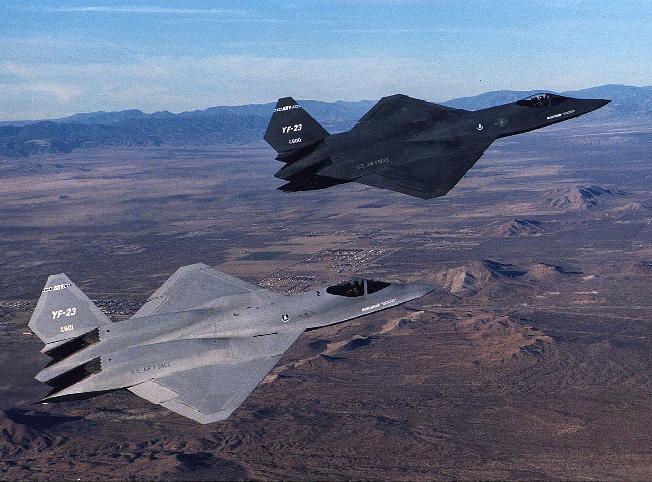
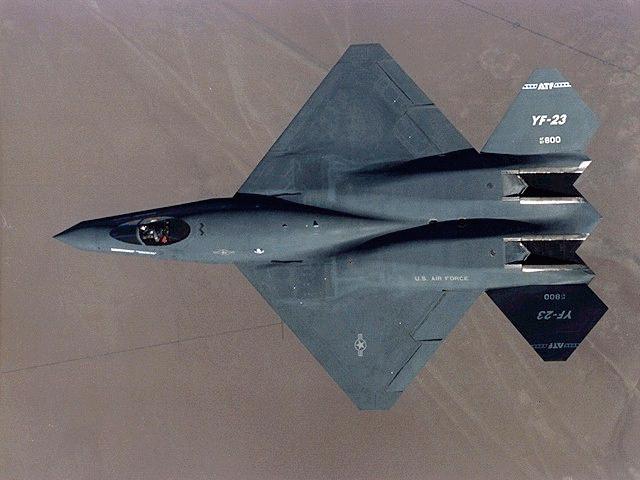
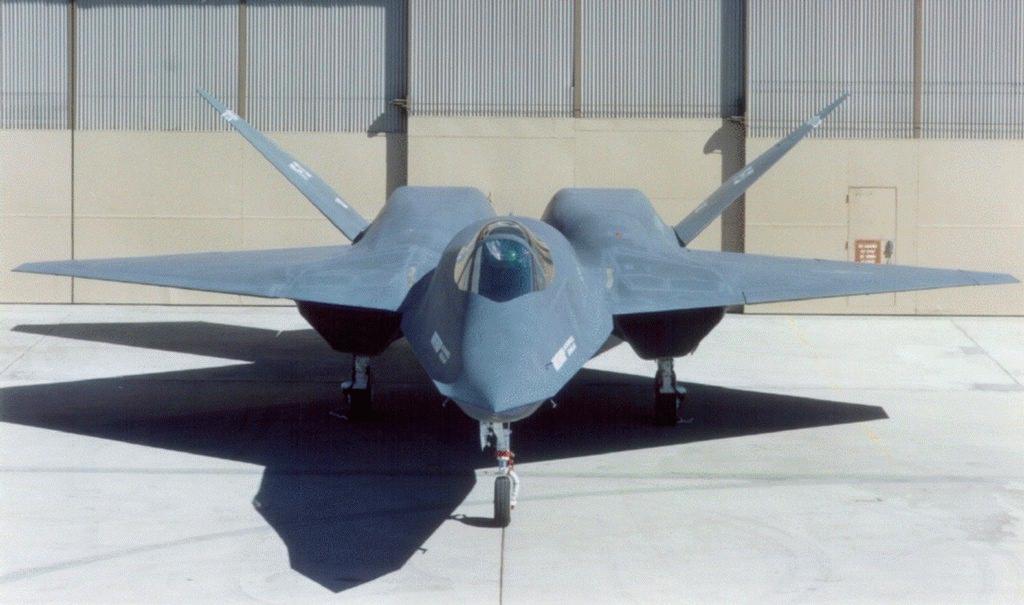
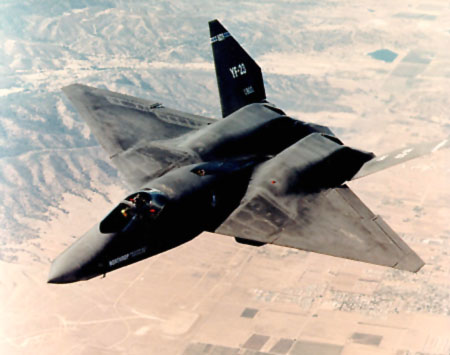
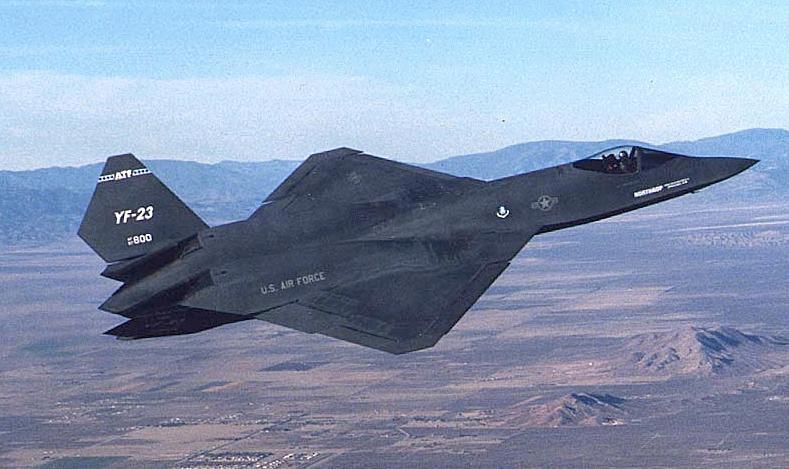
Specifications
General characteristics
Crew: 1 (pilot)
Length: 67 ft 5 in (20.60 m)
Wingspan: 43 ft 7 in (13.30 m)
Height: 13 ft 11 in (4.30 m)
Wing area: 900 ft� (88 m�)
Empty weight: 29,000 lb (14,970 kg)
Loaded weight: 51,320 lb (23,327 kg)
Max takeoff weight: 62,000 lb (29,000 kg)
Powerplant: 2� General Electric YF120 or Pratt & Whitney YF119 , 35,000 lbf (156 kN) each
Performance
Maximum speed: Mach 2.2+ (1,650+ mph, 2,655+ km/h) at altitude
Cruise speed: Mach 1.6 (1,060 mph, 1,706 km/h) supercruise at altitude
Range: over 2,790 mi (over 4,500 km)
Combat radius: 865-920 mi[23] (750-800 nmi, 1,380-1480 km)
Service ceiling: 65,000 ft (19,800 m)
Wing loading: 54 lb/ft� (265 kg/m�)
Thrust/weight: 1.36
Armament
None as tested but provisions made for[1]
1 � 20 mm (.79 in) M61 Vulcan cannon
4-6 � AIM-120 AMRAAM or AIM-7 Sparrow air-to-air missiles
4 � AIM-9 Sidewinder air-to-air missiles

The A-12 Avenger II was an American aircraft program from McDonnell Douglas and General Dynamics intended to be an all-weather, carrier-based stealth bomber[1] replacement for the A-6 Intruder in the United States Navy and Marines. The A-12 project was canceled in 1991 due to high costs.
MORE AT: A-12 Avenger II - Wikipedia, the free encyclopedia
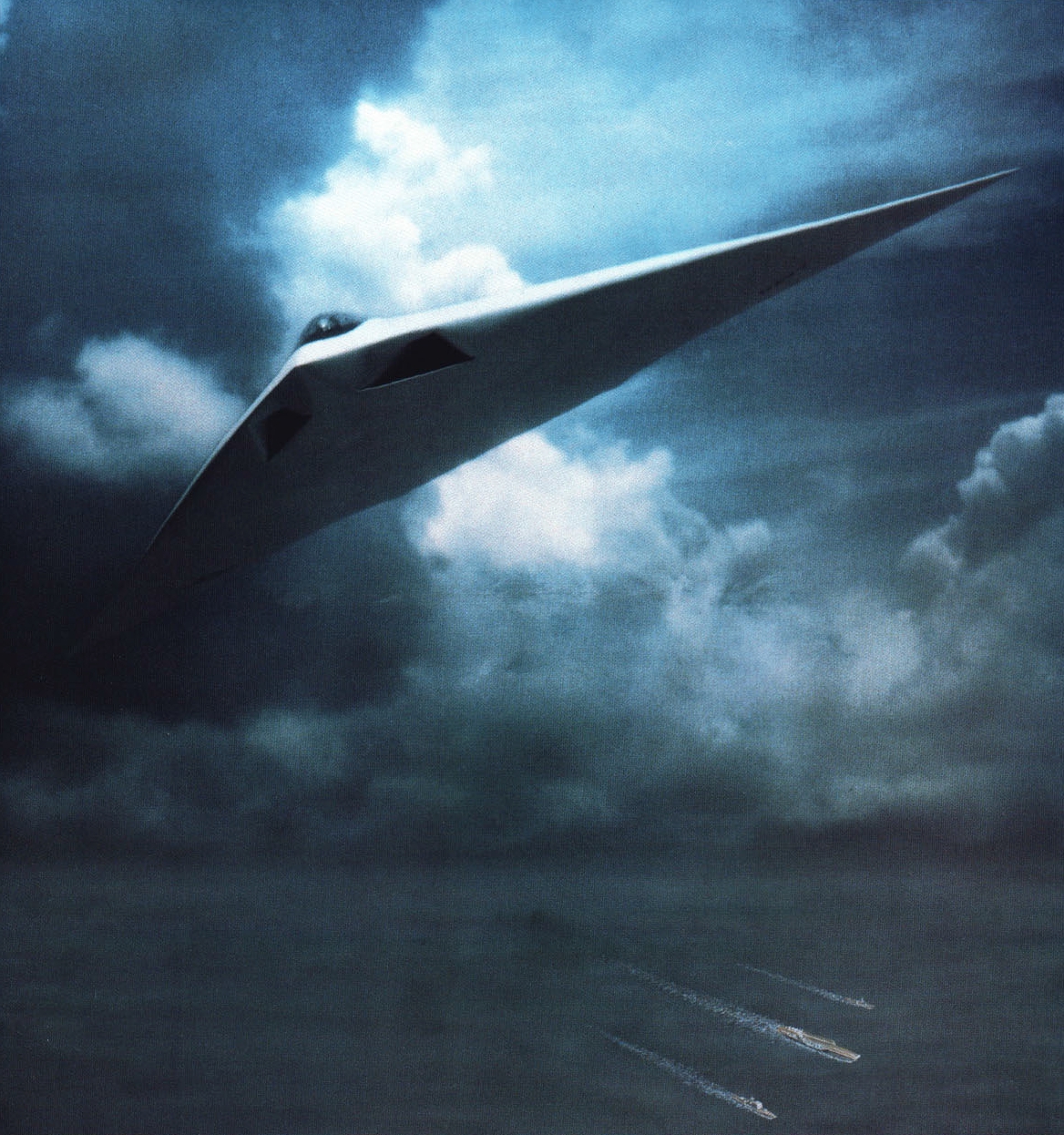

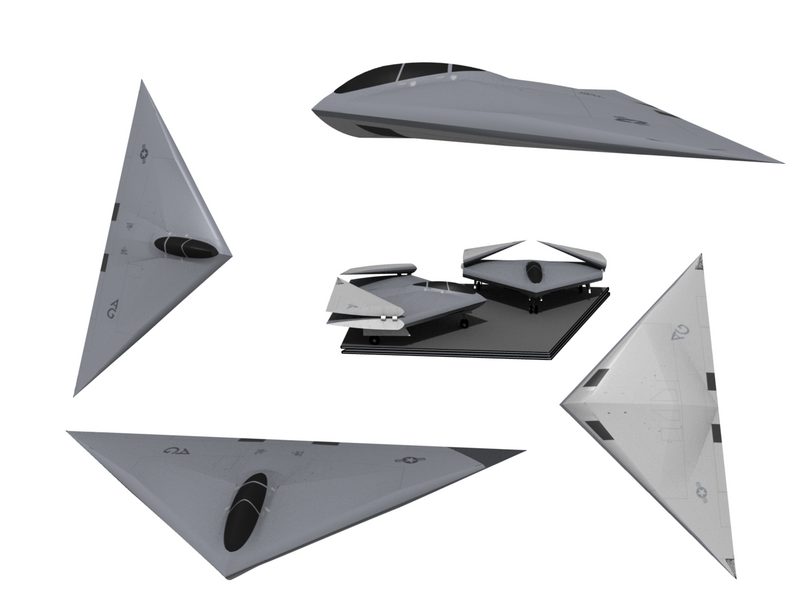
Boeing’s Sixth-Gen Fighter
Here’s a little update on this fighter design we showed you yesterday. It is indeed Boeing’s concept for a sixth-gen “air dominance” fighter for the U.S. Navy and Air Force, Daryl Davis, chief of Boeing’s Phantom Works division told me today. The plane, which is still just a concept, would have long-ranger range and fly at “higher mach numbers” (faster) than jets like the F-35 Joint Strike Fighter and be able to supercruise, according to Davis.
Boeing is funding its own research into sixh-gen fighter concepts since neither the Air Force or Navy is moving to kick off a new fighter program in the near future, said Davis. Pumping it’s own cash into advanced fighter R&D means that Boeing will have existing tech ready for a new airplane design when “the balloon goes up,” added Davis.
This is going to be pretty important in the years to come since, as Air Force Chief of Staff Gen. Norton Schwartz told reporters today that the Air Force is going to focus even more on buying proven, existing technologies that meet the service’s actual combat requirements not its “wants.
China Researching for J-28 Six-generation Space-air Fighter Jet for Star War

A Russia media has recently exposed: China is doing research for the development of J-28, its sixth-generation fighter jet. It is precisely what China has always been doing in developing its weapons: Production and improvement of one generation, research and development for the next generation, preliminary research form a third generation and exploration for a fourth.
China’s Aviation Research Institute No. 611 is now doing the research for J-28, which shall be a sixth-generation multi-function stealth fighter jet. It is said that J-28 is able to conduct accurate conventional hit to counter the nuclear threat from the entire solar system.
The laser weapon a J-28 carries is so strong that it can melt a nuclear missile launched from any planet or satellite in solar system. J-28’s speed is so high that even if it fails to intercept a missile the first time, it can chase the missile to hunt it.
In addition, it is such a wonderful stealth fighter that it cannot be detected by either radar or radio telescope.
The report says as the United States has conducted enough survey to know the Mars, it is expected that the US will establish a nuclear missile base on Mars in 2018.
In order to deal with the nuclear threat from solar system, China has begun its development of J-28, its sixth-generation multi-functin stealth fighter jet.
Source: qianzhan.com “Amazing combat capability of China’s sixth-generation J-28 fighter jet: An accurate hunter of nuclear missile from solar system” (summary by Chan Kai Yee based on the report in Chinese)
So far, the US, Russia, France, Japan and China have officially
declared that they have begun developing six-generation aircrafts, but
all of them are at the stage of research into the ideas.However, sources say that China has made major breakthrough in developing its sixth-generation fighter jet “Shenlong” due to its employment of tens of top scientists from a certain country (Russia according to rumor).
Shenlong has super maneuverability and can do Pugachev’s Cobra maneuver. Its marvelous weapon systems consist of radar and optical laser stations to ensure guidance to missiles in long- and short-range air combats. In long-range battle, they can detect targets and track them while in short-range battle, they are able to determine the nationality of the targets. It even has an advanced integrated weapon control system that is able to resist interference to its optical and electronic information and provide directions and display.
Source: qianzhan.com “Shocking Breakthrough in Developing China’s ‘Shenglong’ Sixth-generation Fighter Jet, making the US and Japan nervous” (summary by Chan Kai Yee based on the report in Chinese)

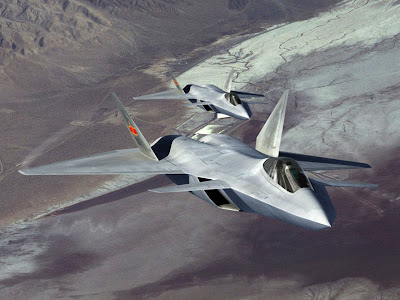
Most likely the 'Dark Sword' will be the candidate of the
Chinese 6th generation fighter.
![[IMG]](http://cache.gawker.com/assets/images/4/2009/10/500x_chinesestealthUAVfight.jpg)
Dark Sword could become world's first supersonic drone
http://www.wantchinatimes.com/
A concept model of the Dark Sword drone was seen for the
first time at the Zhuhai Airshow in 2006. (Photo/CNS)
The Dark Sword — known in Chinese as "Anjian" — made quite a stir in 2006 when a conceptual model of the unusually shaped triangular aircraft made its debut at the Zhuhai Airshow in southern China's Guangdong province.
The model was subsequently exhibited at the Paris Air Show but has disappeared from future airshows, with no official word on the development of the UAV. Some claim the project has already been scrapped due to insufficient funding or other reasons, while others believe the development of the drone is now being kept secret as it is undergoing further research and testing.
Chinese aviation expert Fu Qianshao told CCTV that while he does not know the status of the Dark Sword project, the drone could become the world's first supersonic UAV if it proves a success. He said he would not be surprised if the project is still ongoing in secret as a lack of transparency is nothing new for the aviation industry and is an approach commonly taken by the Americans.
Fu believes even conceptual models of aircraft can reveal something about a country's technology and the quality of its research and development, adding that analyzing models at Zhuhai can allow experts to gauge the pulse of China's aviation industry and pick up data that may be more valuable than what the developers are leaking out to the public.
Fu said he was excited by the appearance of the US Air Force's C-17 Globemaster III large military transport aircraft at Zhuhai this year because it demonstrates that China's aviation industry has reached a certain level.
There have been many arms manufacturers from Europe who want to exhibit their products at Zhuhai but have been unable due to arms embargoes, Fu said. These countries are desperate to show off their products in the hope that China or other countries will buy them because domestic demand alone is insufficient to sustain production, he added.
While air shows provide a platform to display new aviation products, the most advanced weapons and core technologies of other countries cannot be easily bought, Fu said, adding that if China wants to become one of the world leaders in the aviation industry it must develop its own technologies.
References:
Fu Qianshao 傅前哨
![[IMG]](http://img1.cache.netease.com/catchpic/3/37/37926FC5F73AFDE7B57B6AFD8F3FD7E5.jpg)

PAKFA Fifth-generation fighter Pics
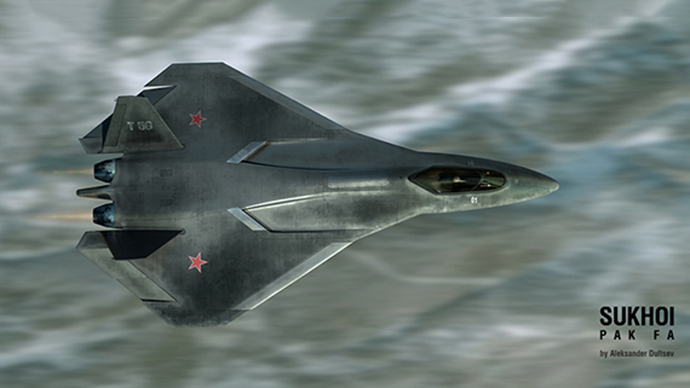 .
.
some more ideas on PAKFA engine layout by paralay
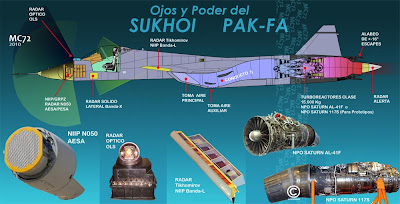
The Russian Air Force's Super Weapon: Beware the PAK-FA Stealth Fighter
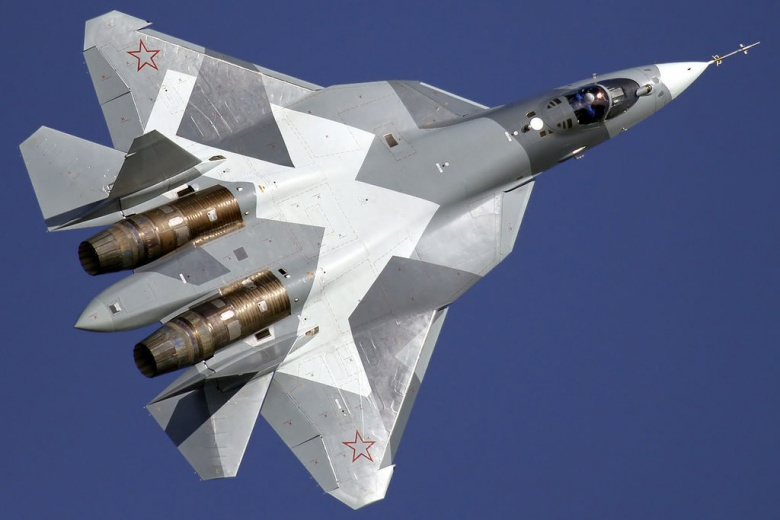
The Russian Sukhoi T-50 PAK-FA stealth fighter could prove to be a formidable competitor to American fifth-generation combat aircraft such as the Lockheed Martin F-22 Raptor and F-35 Joint Strike Fighter. Indeed, in some measures, the new Russian warplane will exceed both U.S.-built jets, but the PAK-FA is not without its flaws.
“The analysis that I have seen on the PAK-FA indicates a pretty sophisticated design that is at least equal to, and some have said even superior to U.S. fifth-generation aircraft,” former U.S. Air Force intelligence chief Lt. Gen. Dave Deptula told the National Interest. “It certainly has greater agility with its combination of thrust vectoring, all moving tail surfaces, and excellent aerodynamic design, than does the F-35.”
Indeed, the PAK-FA appears to be optimized for the air-superiority role like the F-22 more so than the multirole, strike-optimized F-35. Like the Raptor, the PAK-FA is being designed to fly high and fast to impart the maximum amount of launch energy to its arsenal of long-range air-to-air missiles—which would greatly increase the range of those missiles.
“Performance-wise it certainly looks to compete with the Raptor,” one senior military official with extensive experience on U.S. fifth-generation fighters told the National Interest.
Like the F-22, the Russian machine is expected to be able to cruise supersonically for extended periods of time—probably faster than Mach 1.5. The aircraft’s maximum speed should be greater than Mach 2.0—assuming its low observables coatings can handle the stress.
However, unlike the American fifth-generation aircraft, the PAK-FA places less emphasis of stealth, and much more emphasis on maneuverability. While it could compete with the Raptor in terms of raw kinematic performance, the PAK-FA greatly exceeds the F-35. And that performance margin might increase.
The Russian aircraft is currently powered by modified versions of the Su-30 Flanker’s engines called the Izdeliye 117 or AL-41F1, which produce about 33,000 pounds of thrust. The engine, which runs far hotter than the original AL-31 engines from which it was derived, is not proving to be as reliable as initially hoped. But the current engines are only temporary. Later production variants of the PAK-FA are expected to be powered by a new engine called the Izdeliye 30, which should enter service in 2020.
The Russian jet is also equipped with a powerful avionics suite, which is an evolution of Sukhoi’s work on the Flanker-series fighters. “Indications are that the avionics are derived from the Su-35S with the addition of a very high power-aperture X-band multimode AESA radar,” Deptula said.
Further, there are indications that the PAK-FA is also equipped with L-band radar arrays, which are able to detect the presence of a fighter-sized stealth aircraft. While the L-band radar would not allow the PAK-FA to target a stealth aircraft, it would allow the pilot to focus the jet’s other sensors on a particular area of the sky.
In addition to radars and electronic support measures, the PAK-FA is equipped with infrared search and track capabilities.
While the Russians have made enormous leaps in their sensor capabilities, U.S. warplanes still hold the edge in terms of sensor and data-fusion, which is critical for modern warfare. “The real question is can the Russians achieve the same degree of data fusion and networking capabilities of the F-22A and F-35—right now I’d put my money on the U.S. and our allies in that regard,” Deptula said.
A senior U.S. industry official agreed with Deptula’s assessment. In terms of its avionics, the PAK-FA is closer to a Boeing F/A-18E/F Super Hornet or F-16E/F Block 60 than an F-22 or F-35. “Some may claim that the PAK-FA is a 5th gen. fighter, but it's more of a 4.5 gen. fighter by U.S. standards,” the industry official said.
In fact, the PAK-FA’s lack of true sensor fusion and comprehensive data links that are on par with its American counterparts may prove to be its Achilles’ heel. U.S. strategists are moving towards an approach where every aircraft or surface ship can act as a sensor for any aircraft, ship or vehicle that carries a weapon. The launch aircraft might not even guide the weapon once it has been fired. The U.S. Navy is already implementing a construct called the Naval Integrated Fire Control-Counter Air (NIFC-CA) that would do just that. The Air Force, too, is working on something similar.
“In the future—while aerodynamic performance will continue to be important—speed, range and payload to a greater degree than maneuverability. Even more important will be the ability to ubiquitously share knowledge to the point that we have faster decision advantage than any adversary,” Deptula said. “This is the notion of the ‘combat cloud.’ It’s more about how we integrate the sensor-shooters that are resident in systems coming online, more than it is about new platforms.”
The senior military official agreed with Deptula’s assessment, but added that the PAK-FA has another vulnerability, too. The Russians generally do not have a requirement to fight inside a dense, highly advanced integrated air defense system (IADS) like a U.S. jet would. As such, while the PAK-FA does have stealthy features, it places far less emphasis on low observables technology than does the F-22 or F-35. “Its failure to prioritize stealth and sensor fusion make it vulnerable to both Western fifth-gen. fighters, certainly the F-22,” the official said. “When you look at the concept the USAF [U.S. Air Force] will apply with the F-22/F-35 team, the PAK-FA will run in to significant challenges.”
The Chinese, however, are a different story. “That scenario, by the way, is exactly why the Chinese see value in the J-20 and J-31 combo,” the senior official said.
In any case, while Russia might be able to develop a very capable fifth-generation fighter, there are questions as to whether the country can produce such a machine. The Soviet industrial base was always optimized to produce large quantities with relatively crude quality controls. However, stealth technology requires a level of manufacturing precision that Russia has never demonstrated before—especially after collapse of its industrial base in the years that followed the demise of the Soviet Union. “It has a long way to go before reaching IOC [initial operational capability],” the senior industry official said. “Both the Russians and Chinese have yet to ramp-up production of one of their new generation fighters. The Russians have to first resuscitate their aerospace industrial capacity…. and neither has the stealth technology, manufacturing, and operational experience like the U.S.”
Senior U.S. Air Force officials concurred with the industry official’s assessment. “I will mention that getting a fifth-gen. aircraft from brochure to fully functional and reliable is very difficult,” a senior Air Force official said. “They don't have as much experience as our industrial base with some of the capability they want in it and it is still pretty hard for us to do, so I predict growing pains in fielding.”
Comprehensively assessing the PAK-FA before it is fielded is a difficult proposition even for those with access to military intelligence data. “It's tough to tell until the PAK-FA goes into production,” another senior Air Force official said. “I doubt they'll be on par with our fifth-gen. fighters, but we don't have many and they'll likely overmatch any fourth-gen. [fighter like the F-15, F-16 or F/A-18.]”
Nonetheless, the United States has started to work on shaping the requirements for the next-generation successors to the F-22 and F-35 in the form of the Air Force F-X air-superiority fighter and the U.S. Navy’s F/A-XX next-generation strike fighter. But even before then, there are steps the Pentagon can take to mitigate the threat from Russian and Chinese stealth fighters.
“Fifth-gen. aircraft and information technologies are enabling new concepts of operation that we have yet to fully exploit. I’d suggest that is where we put our energy before spending a lot of time and money building another evolutionary fighter,” Deptula said. “LRS-B [Long Range Strike-Bomber], if properly designed for growth, will be the next major component of this concept than will be F-X and F/A-XX.”
Deptula said that fully integrating the Pentagon’s disparate weapons so that they function as a coherent whole would provide capabilities beyond what a new aircraft might provide. “Future developments in data sharing promise to dramatically enhance the way that combat effects are attained as individual aerospace assets are fully integrated with sea, land, space and cyber systems to form an omnipresent defense complex,” he said. “Individual systems connected together to form a self-forming/self healing ‘combat cloud’ and able to leverage their respective strengths, while simultaneously circumventing specific system weaknesses and vulnerabilities is where we need to be heading. This could well be the basis of the next ‘offset strategy’ that the [Secretary of Defense] and his deputy are now championing.”
Dave Majumdar has been covering defense since 2004. He currently writes for the U.S. Naval Institute, Aviation Week and The Daily Beast, among others. Majumdar previously covered national security issues at Flight International, Defense News and C4ISR Journal. Majumdar studied Strategic Studies at the University of Calgary and is a student of naval history.
Image: Wikimedia Commons/Dmitry Zherdin/CC by-sa 3.0
Japan mulls building its own fighter jets: report
But
joint F-2 production ended more than two years ago and the last of the
fighters are due to be retired from Japan's air defence force around
2028, it added.
The defence ministry plans to seek about 40
billion yen ($387 million) in state funding for the next year starting
in April 2015 to test experimental engines and radar-dodging stealth
airframe designs for a purely Japanese fighter, the report said.
According
to its medium-term defence programme, the Tokyo government will decide
by the 2018 financial year whether to go ahead with the all-Japanese
fighter project.
There is a
growing need for Japan to develop a long-haul, highly stealthy fighter
jets in face of China's increasing assertiveness in the East China Sea,
where the two countries are locked in a dispute over a group of
Tokyo-controlled islands, the Nikkei said.
Beijing
regularly warns of what it says is Tokyo's intent to re-arm on the
quiet, saying selective amnesia about its World War II behaviour means
it cannot be trusted to have a fully-fledged military.
Last
month the cabinet of conservative Prime Minister Shinzo Abe loosened
the bonds on Japan's military -- proclaiming the right to go into battle
in defence of allies -- in a highly controversial shift in the nation's
post-war pacifist stance.
Japan
denies its intent is anything other than defensive, and hits back that
Beijing's opaque military spending and its burgeoning ambitions are the
real danger.
The defence
ministry started work four years ago on the so-called Advanced
Technology Demonstrator-X (ATD-X) plane to explore the project's
feasibility by studying lightweight airframe designs and built-in
missile-firing mechanisms, the Nikkei said.
The ATD-X is due to start testing experimental engines in January and the stealth airframe designs in April, the report said.
The
ministry hopes to develop the actual engines for the project in
cooperation with IHI, Mitsubishi Heavy and other defence contractors in
about five years.
Developing a purely domestic fighter is estimated to cost a massive 500-800 billion yen ($4.8-7.7 billion), the report said.
J-XX
all of the pictures here have been posted on one forum or other some time ago, these weren't posted here earlier so i posted them for the benefit of members who would not have seen them earlier.anyways here are some pics of the Japanese 5th gen concept the Mitsubishi ATD-NOT PS)


MHI and TRDI unveil finalized XF-3A renders
Apr 1, 2011
By Bradley Perrett
Tokyo
Japan's Defense Ministry's Technical Research and Development Institute, in conjunction with Mitsubishi Heavy Industries, has released today the first CG images of Japan's next fighter. Previously termed as the I3 fighter, the new fighter designated as the XF-3A, is a sixth generation aircraft that utilizes similar stealth technologies as the US F-35 JSF fighter.
The XF-3A will utilize technologies developed from the ATD-X Shinshin stealth technology demonstrator which is set to begin its first flight by 2014. In comparison to the ATD-X Shinshin, the XF-3A will be 25% larger and feature two internal weapons bay which can carry air to air missiles.
Last year, Russia and China both unveiled new stealth fighters, quickly making obsolete much of Japan's fighter force. Japan currently has territorial disputes with both countries. "The development of a sixth generation fight
er will be essential in defending our country's territorial integrity" said a TRDI spokeswoman.
Japan to test first homegrown stealth fighter jet: report
A group of major
Japanese firms are planning a test flight next year for the nation's
first homegrown stealth fighter jet, a report said Tuesday.
The consortium
-- led by Mitsubishi Heavy Industries -- is developing a jet that has
similar technology to US-made F-35 stealth fighters, with a prototype
set for a test run in January, the Mainichi Shimbun newspaper said.
About 39.2 billion yen ($384 million) has been invested in the project, said the report, which did not cite sources.
Following
the initial flight, the jet will undergo about two years of testing at
the defence ministry with Tokyo set to decide on whether to buy the
plane by early 2019, it added.
The story could not be immediately confirmed.
Japan,
which sees a security alliance with the United States as a cornerstone
of its foreign policy, has long depended on US manufacturers for
military hardware.
But the
conservative government has been looking to expand Japan's military
influence, and has relaxed a self-imposed ban on weapons exports.
Last
month, Tokyo loosened the bonds on Japan's powerful military,
proclaiming the right to go into battle in defence of allies, in a
highly controversial shift for the officially pacifist country.
The
development of a homegrown jet comes amid worsening tensions with
Beijing over rival claims to islands in the East China Sea.
Japan
said last month that its military scrambled fighter jets a record 340
times in the three months to June in response to feared intrusions on
its airspace.
Chinese
government ships and planes have been seen off the disputed islands
dozens of times since Japan nationalised some of the archipelago nearly
two years ago
The First Clear Pictures Of Japan's Stealth Fighter Emerge
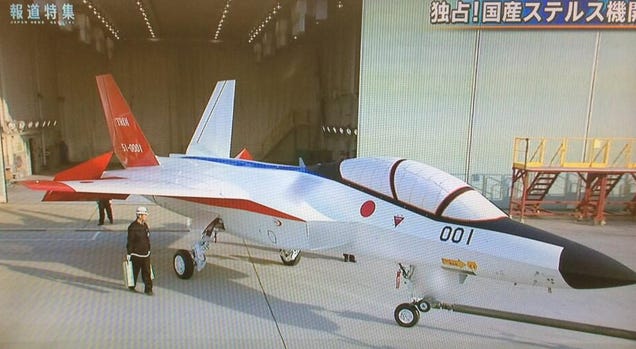
Japan's Mitsubishi built ATD-X experimental stealth fighter has
emerged! This technology demonstrator, known within the Japanese
Ministry Of Defense as the "Spirit of The Heart," is set to fly sometime
later this year.

Japan
hopes the Advanced Technology Demonstrator eXperimental (ATD-X) will
lead to a larger high-performance production aircraft with
low-observable (stealthy) qualities, designed and built indigenously
sometime in the next decade. New technologies that the ATD-X will test
include a second generation AESA radar,
advanced "fly-by-fiber-optic" flight control system that can compensate
for battle damage and control surface failures, an advanced ESM and ECM suite, thrust vectoring and locally developed high-thrust turbofan engines to name a few.
UPDATE: Check out this news segment from Japanese TV-
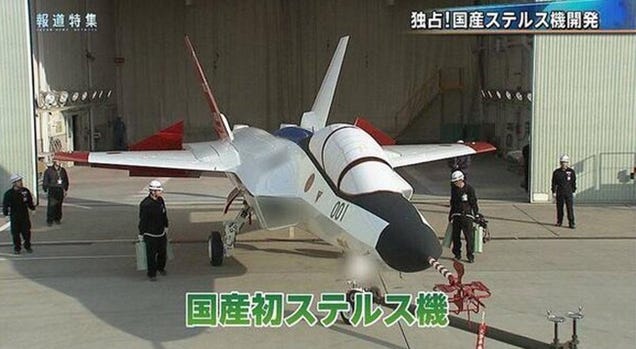
pictures via twitter, Japanese media.
Tyler
Rogoway is a defense journalist and photographer that maintains the
website Foxtrot Alpha for Jalopnik.com You can reach Tyler with story
ideas or direct comments regarding this or any other defense topic via
the email address Tyler@Jalopnik.com

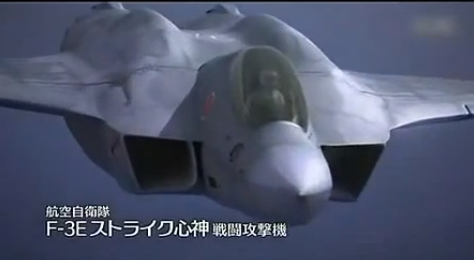
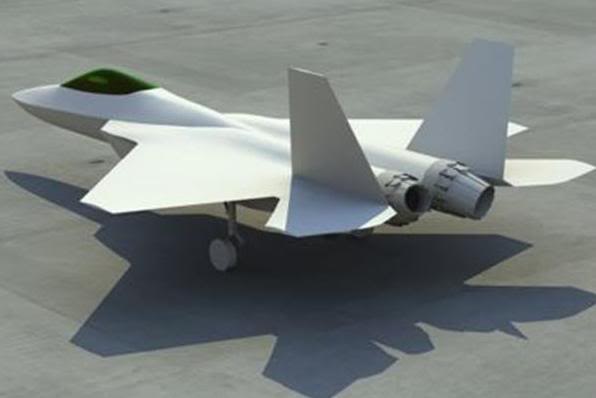
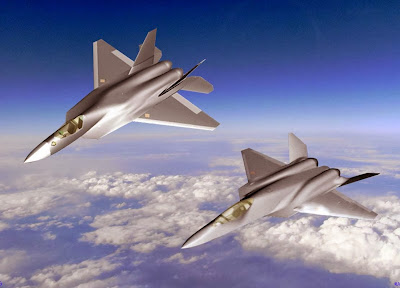
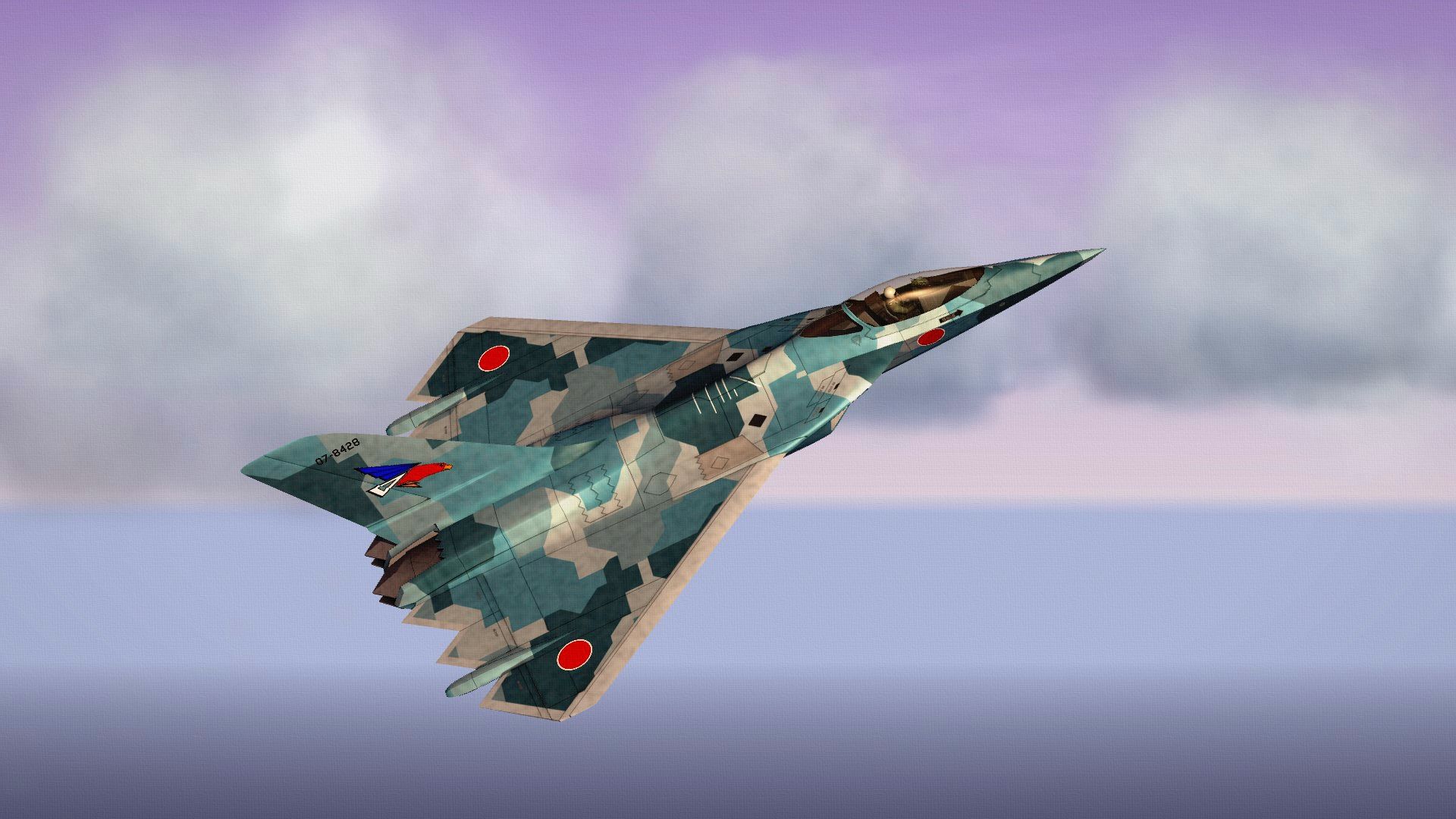

Official CG image released by MHI and TRDI
Credit: TRDI.
Japan to Fly its Own Stealth Fighter Prototype By 2014
 |
Well, the stealth races are now well underway, with China, Russia (partnering with India) and now Japan moving to field stealth fighters this decade.
Fed up with the U.S. refusal to share the F-22 Raptor despite China’s rapidly advancing military technology, Tokyo now says it will fly Japan’s first stealth fighter prototype by 2014, according to the AP:
The prototype will likely be able to fly in 2014, Lt. Gen. Hideyuki Yoshioka, director of air systems development at Japan’s Ministry of Defense, said in an interview with the Associated Press.
He said Japan has put 39 billion yen ($473 million) into the project since 2009, after it became clear the U.S. was not likely to sell it the F-22 “Raptor”—America’s most advanced fighter jet—because of a congressional export ban.
“We are two years into the project, and we are on schedule,” Gen. Yoshioka said Monday. He stressed that a successful test flight of the prototype, dubbed “Shinshin” (“Spirit”), would not lead to immediate production. The prototype would test advanced technologies, and if successful the government would decide in 2016 how to proceed.
That’s pretty darn ambitious. Still, it could be done. Especially if Japan is given help by the U.S. Just because we can’t share our most advanced jets with the island nation, doesn’t mean we won’t be helping one of our closest allies. Especially when that ally is so close to a China that is making no qualms about its desire to exert lots of influence over the region in the coming decades.
This new program, known as ATD-X, isn’t meant to supplant Japan’s plans to buy F-35 Joint Strike Fighters, F/A-18E/F Super Hornets or Eurofighter Typhoons to replace its aging F-4J Phantoms and F-15s. Instead the program is mean to hone Japan’s ability to develop a 21st Century air superiority fighter on par with the F-22, according to the article.
Mitsubishi ATD-X
From Wikipedia, the free encyclopedia
| ATD-X Shinshin | |
|---|---|
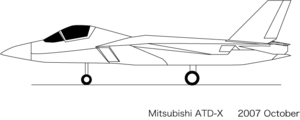 |
|
| Mitsubishi ATD-X as of 2007 | |
| Role | Stealth experimental aircraft |
| National origin | Japan |
| Manufacturer | Mitsubishi Heavy Industries |
| First flight | 2014 (projected)[1] |
| Status | Under development |
| Primary user | Japan Air Self-Defense Force |
Development
At the beginning of the twenty-first century, Japan, seeking to replace its aging fleet of fighter aircraft, began making overtures to the United States on the topic of purchasing several Lockheed Martin F-22 Raptor fighters for their own forces.[5] However the U.S. Congress had banned the exporting of the aircraft in order to safeguard secrets of the aircraft's technology such as its extensive use of stealth; this rejection necessitated Japan to develop its own modern fighter, to be equipped with stealth features and other advanced systems.A mock-up of the ATD-X was constructed and used to study the radar cross section in France in 2005.[6][7] A radio-controlled 1/5 scale model made its first flight in 2006 to gain data on performance at high angles of attack and to test new sensory equipment and self-repairing flight control systems.[7]
Following these preliminary steps, the decision was taken in 2007 to push ahead with the multi billion-yen project. At the time of this decision, production was forecast to start roughly 10 years later, around 2017. In 2007, the ATD-X was expected to conduct its maiden flight in 2014.[8] In 2011, the maiden flight is to take place in 2014 or 2015.[9]
On July 2014, the TRDI (Technical Reseach & Development Institute ) released first official photos of the ATD-X prototype, and stated that the aircraft was undergoing tests on ground. Mitsubishi ATD-X shinshin stealth fighter prototype has rolled out, to be fully developed by 2018. [10]
The ATD-X program will then lead to a F-3 fighter to be produced in 2027.[11]
Design
The ATD-X will be used as a technology demonstrator and research prototype to determine whether domestic advanced technologies for a sixth generation fighter aircraft are viable, and is a 1/3 size model of a possible full-production aircraft.[12] The aircraft also features 3D thrust vectoring capability. Thrust is controlled in the ATD-X by the use of 3 paddles on each engine nozzle similar to the system used on the Rockwell X-31, while an axis-symmetric thrust vectoring engine is also being developed for the full scale production model.[12] The nozzles on the prototype appear to be uncovered and might have a slight adverse effect on the aircraft's stealth characteristics.[citation needed]Among the features the ATD-X is to have is a fly-by-optics flight control system, which by substituting optical fibers for wires, allows data to be transferred faster and with immunity to electromagnetic disturbance.[12]
Its radar will be an active electronically scanned array (AESA) radar called the 'Multifunction RF Sensor', which is intended to have broad spectrum agility, capabilities for electronic countermeasures (ECM), electronic support measures (ESM), communications functions, and possibly even microwave weapon functions.[12]
A further feature will be a so-called 'Self Repairing Flight Control Capability' (自己修復飛行制御機能?), which will allow the aircraft to automatically detect failures or damage in its flight control surfaces, and using the remaining control surfaces, calibrate accordingly to retain controlled flight.[7]
The JASDF is reported to have issued a request for information for engines in the 10 to 20 thousand pound thrust range to power the prototypes while Ishikawajima-Harima Heavy Industries is to provide the engines for the completed fighter.[13]
Specifications (ATD-X)
Data from Miyakawa et al, 2008[7]
General characteristics- Crew: 1
- Length: 14.174 meters (46.50 feet)
- Wingspan: 9.099 meters (29.85 feet)
- Height: 4.514 meters (14.80 feet)
- Max. takeoff weight: 13 tonnes (28,659 pounds)
- Powerplant: 2 × IHI XF5-1 turbofans
- Dry thrust: unknown (unknown) each
- Thrust with afterburner: 11,023 pounds each (5,000kg[14]) each
HAL AMCA
From Wikipedia, the free encyclopedia
(Redirected from Advanced Medium Combat Aircraft)
| Advanced Medium Combat Aircraft | |
|---|---|
 |
|
| A wind tunnel model of the AMCA | |
| Role | Stealth multirole fighter |
| National origin | India |
| Manufacturer | Hindustan Aeronautics Limited |
| Designer | Aeronautical Development Agency, Defence Research and Development Organisation |
| First flight | Early 2020s[1] |
| Introduction | TBD |
| Status | Under development |
| Primary users | Indian Air Force Indian Navy |
| Unit cost |
TBD
|
Contents
Development
In October 2008, the Indian Air Force asked the ADA to prepare a detailed project report on the development of a Medium Combat Aircraft (MCA) incorporating stealth features.[5]In February 2009, ADA director PS Subramanyam said at an Aero-India 2009 seminar, that they are working closely with Indian Air Force to develop a Medium Combat Aircraft. He added that according to the specification provided by the Indian Air Force, it would likely be a 20-ton aircraft powered by two GTX Kaveri engines.[6]
In April 2010, the Indian Air Force issued the Air Staff requirements (ASR) for the AMCA which placed the aircraft in the 25-ton category.[7]
Funding and future developments
In November, 2010, the Aeronautical Development Agency (ADA) sought $2-billion (approximatelyBy August 2011, the aircraft was in preliminary design phase. As of July 2012, with aerodynamic design optimisation near complete, the AMCA's broad specifications are final. The aircraft will have a weight of 16-18 tonnes with 2-tonnes of internal weapons and four-tonnes of internal fuel with a combat ceiling of 15-km, max speed of 1.8-Mach at 11-km.[10] The final design is expected to be shown to the air force by 2012, after which full scale development on the aircraft may start.[11] In February 2013, the Aeronautical Development Agency (ADA) unveiled a 1:8 scale model at Aero India 2013.[4]
Temporary intermission
The Ministry of Defense had put the project on hold wanting to make up for the protracted delays incurred by the ADA during the development of Light Combat Aircraft.[12] According to a top Defence Ministry source, ″This decision was taken recently to let the ADA focus on the LCA project.″[12] It was reported in January 2014 that work on AMCA has again commenced after HAL Tejas attained IOC, and that the AMCA will be developed by 2018.[13]Design
The AMCA will be designed with a very small radar cross-section and will also feature serpentine shaped air-intakes, internal weapons and the use of composites and other materials. It will be a twin-engined design using the GTX Kaveri engine with thrust vectoring with the possibility of giving the aircraft supercruise capabilities.[3][3][14] Talks on a joint venture with France for development of Kaveri engine is on progress.[7][15]As part of the multidisciplinary design optimisation (MDO) currently on for the AMCA—wind-tunnel testing model of the MCA airframe was seen at Aero-India 2009.[16] —that design-based stealth features will include further optimised airframe shaping, edge matching, body conforming antennae and a low IR signature through nozzle design, engine bay cooling and work on reduced exhaust temperature.[3][10] The aircraft will have an internal weapons bay and radar-absorbent paint and composites.[17]
As well as advanced sensors the aircraft will be equipped with missiles like DRDO Astra and other advanced missiles, stand-off weapons and precision weapons.[14] The aircraft will have the capability to deploy Precision Guided Munitions. The aircraft will feature extended detection range and targeting range with the ability to release weapons at supersonic speeds. The aircraft's avionics suite will include AESA radar, IRST and appropriate electronic warfare systems and all aspect radar warning receiver (RWR), Laser warning receiver (LWR), missile warning suite.[3][18]
In the Paris Air Show 2013, ADA revealed that the AMCA will have "net-centric warfare, vehicle management (including weapons), data fusion, decision aids, integrated modular avionics, internal carriage of weapons, signature control with sharpening for low observability, AESA radar, IR search-and-track, supersonic persistence, high-speed weapon release and thrust vectoring." The aircraft is designed to be multi-role, with the ability to undertake both long and short-range missions, and conduct both air-to-air and strike missions. Unlike the HAL Tejas which has a digital flight-control computer and hydraulic controllers, the AMCA is likely to have a distributed processing system employing fast processors and smart subsystems and will be electronically controlled via a "central computational system connected internally and externally on an optic-fiber channel by means of a multi-port connectivity switching module". This would require using the IEEE-1394B-STD rather than MIL-STD-1553B databus standard.[19]
The product design work of Advanced Medium Combat Aircraft has been started by the Defence Research and Development Organization (DRDO) and the vehicle is expected to be ready in 2018, Dr Tamilmani, Director General (Aeronautical Systems) DRDO, Bangalore has said.
Speaking to reporters on the sidelines of the three-day international meet on 'Product Life Cycle, Modelling, Simulation and Synthesis (PLMSS) at VIT university on Monday,’ he said the aircraft would be equipped with twin engines with super cruise power and for the first time it would be using the stealth technology to 'hide' from radar surveillance.
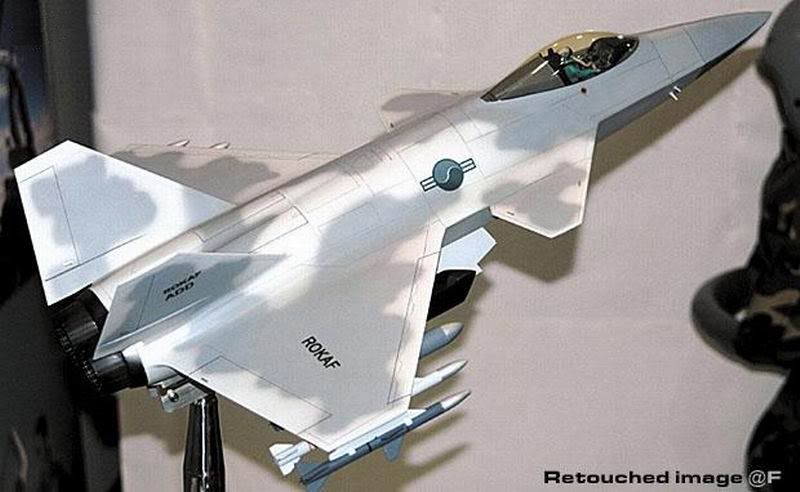
Best Fighter for Canada

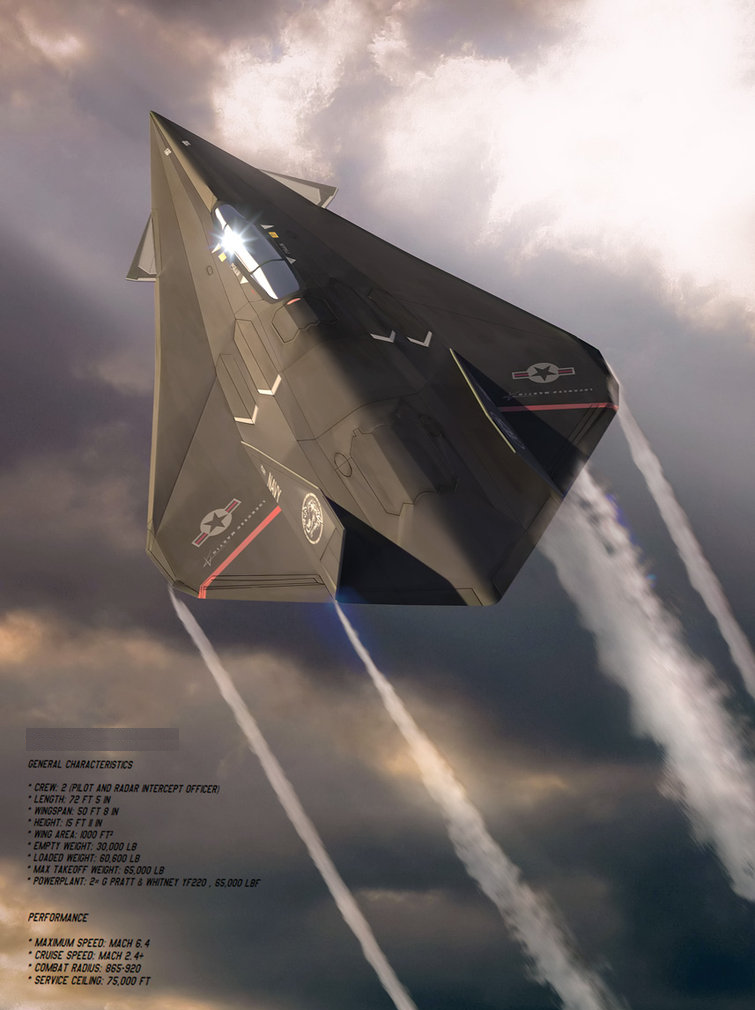





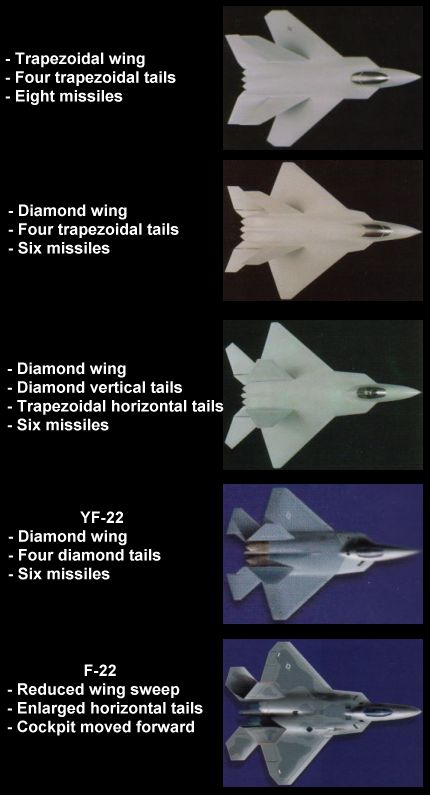
Due to airframe weight concerns, Lockheed decided to completely redesign
its initial Model 090P proposal during 1987. The redesign process
yielded an aircraft that resembles YF-22. (image courtesy of Lockheed
Martin)
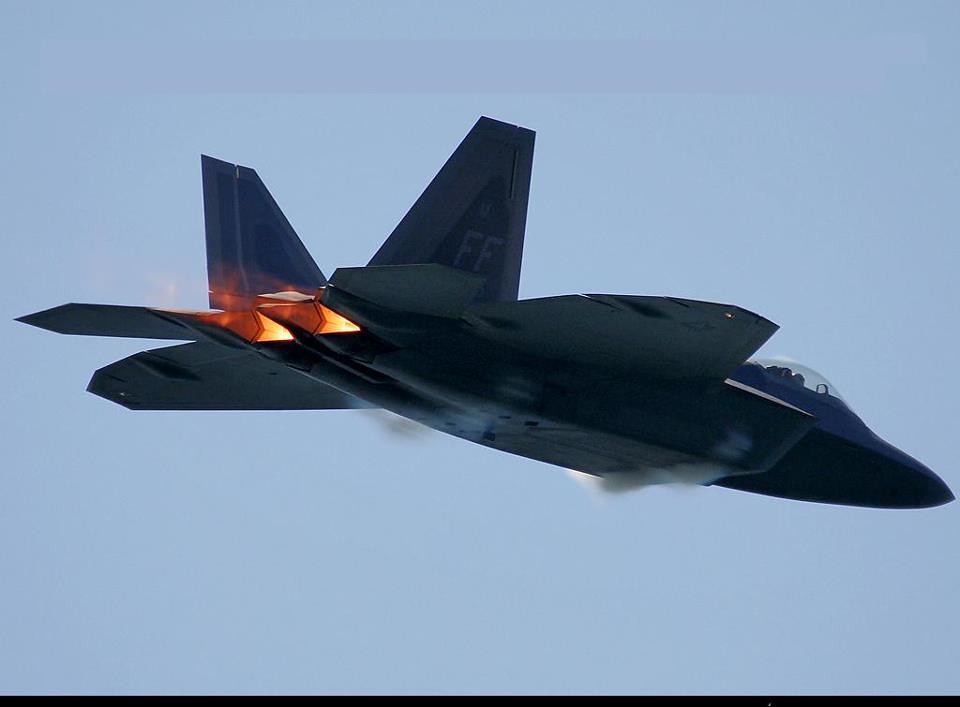





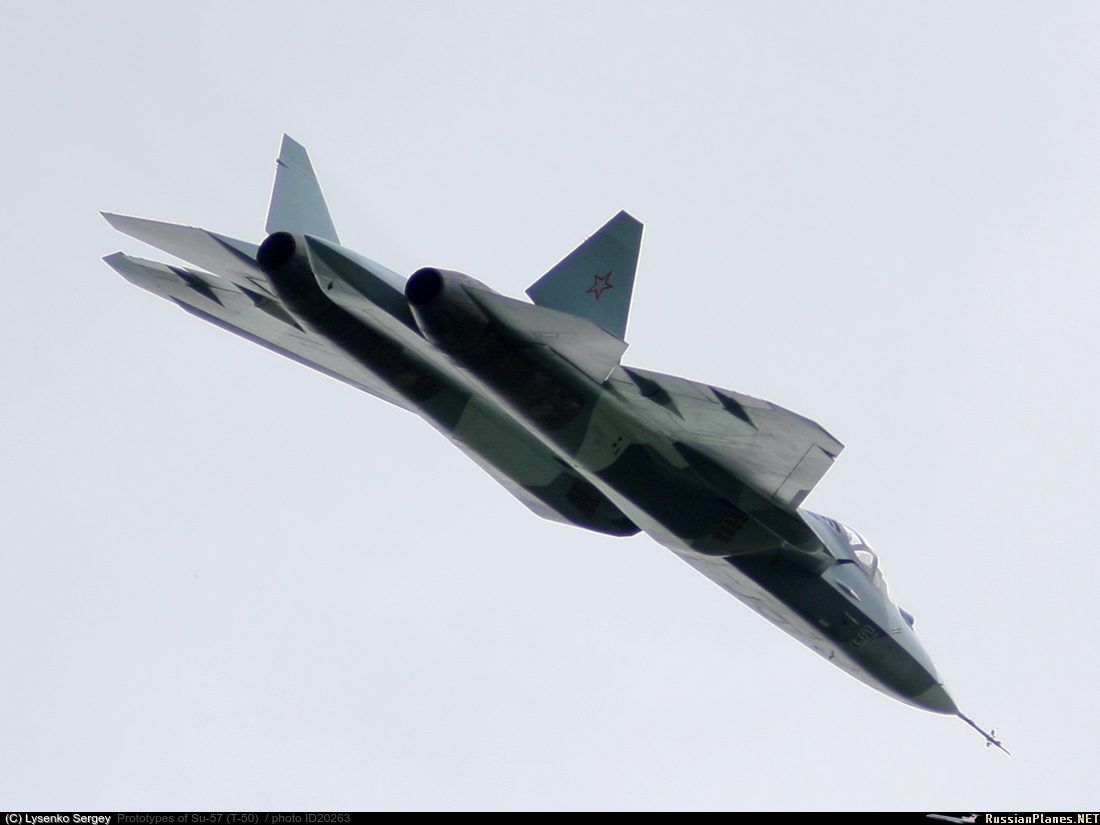
The Stealth In India's Advanced Medium Combat Aircraft (AMCA)
The official CAD images above, from the Advanced Projects & Technologies (AP&T) directorate of India's Aeronautical Development Agency (ADA) provide further perspective on the low-observable design elements that are known to be going into India's Advanced Medium Combat Aircraft (AMCA), known for a while now to be a stealth aircraft concept. Serpentine air intakes (with minimum flow distortion and robust pressure recovery) and internal weapons bays, depicted in the images above, are some of the most critical nose-on low observability design elements going into the programme.
As part of the multidisciplinary design optimization (MDO) currently on for the AMCA -- a wind tunnel model of which was first publicly displayed at AeroIndia 2009 -- that design-based stealth features will include further optimized airframe shaping, edge matching, body conforming antennae and a low IR signature through nozzle design, engine bay cooling and work on reduced exhaust temperature. RAMs, RAPs, special coatings for polycarbonate canopy and precision manufacturing will all be part of the effort to make the AMCA India's first stealth airplane.
With aerodynamic design optimisation near complete, the AMCA's broad specifications are final. The aicraft will have a weight of 16-18 tons [16-18 tons with 2-tons of internal weapons and 4-tons of internal fuel with a combat ceiling of 15-km, max speed of 1.8-Mach at 11-km. The AMCA will be powered by 2 x 90KN engines with vectored nozzles. For the record, the official ADA document that will finally be processed this year by the government towards formal project launch describes the AMCA as a "multirole combat aircraft for air superiority, point air defence, deep penetration/strike, special missions".
IAF Su-50 / PAKFA in Indian colours
Credits to Timmolnt



Tail comparisons: PAK-FA with Su-35, YF-22 and F-22A

PAK-FA/F-22A weapons bay comparison

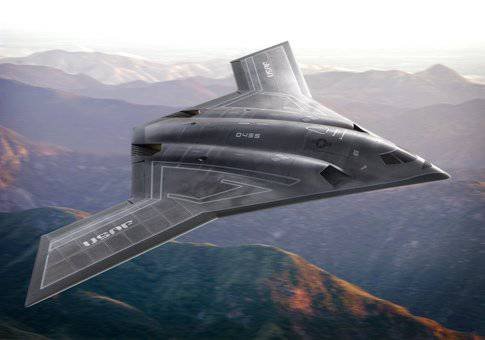




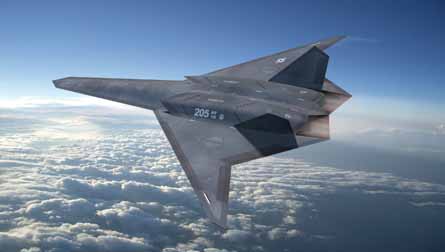



![[IMG]](http://up-ship.com/blog/wp-content/uploads/2011/09/EDI_stealth_UCAV.jpg)
Boeing YAL-1
From Wikipedia, the free encyclopedia
| YAL-1 Airborne Laser | |
|---|---|
 |
|
| ABL aircraft during flight | |
| Role | Airborne Laser (ABL) anti-ballistic missile weapons system |
| Manufacturer | Boeing |
| First flight | 18 July 2002 |
| Status | Canceled |
| Primary user | United States Air Force |
| Number built | 1 |
| Developed from | Boeing 747-400F |
The YAL-1 with a low-power laser was test-fired in flight, at an airborne target in 2007.[2] A high-energy laser was used to intercept a test target in January 2010,[3] and the following month, successfully destroyed two test missiles.[4] Funding for the program was cut in 2010 and the program was canceled in December 2011.[5] It made its final flight on February 14, 2012 to Davis–Monthan Air Force Base in Tucson, Arizona to be prepared and kept in storage at the "Boneyard" by the 309th Aerospace Maintenance and Regeneration Group.
Contents
Development
Origins
The Airborne Laser program was initiated by the US Air Force in 1996 with the awarding of a product definition risk reduction contract to Boeing's ABL team.[7][8] In 2001, the program was transferred to the MDA and converted to an acquisition program.[8]
The development of the system was being accomplished by a team of contractors. Boeing Defense, Space & Security provides the aircraft, the management team and the systems integration processes. Northrop Grumman was supplying the COIL, and Lockheed Martin was supplying the nose turret and the fire control system.[8][9]
In 2001, a retired Air India 747-200 was acquired by the Air Force, and trucked without its wings from the Mojave Airport to Edwards Air Force Base where the airframe was incorporated into the System Integration Laboratory (SIL) building at Edwards' Birk Flight Test Center, to be used to fit check and test the various components.[10][11] The SIL was built primarily to test the COIL at a simulated operational altitude, and during that phase of the program, the laser was operated over 50 times, achieving lasing durations representative of actual operational engagements. These tests fully qualified the system so that it could be integrated into the actual aircraft. Following the completion of the tests, the laboratory was dismantled, and the 747-200 fuselage was removed.[11]
Boeing completed initial modifications to a new 747-400F off the production line in 2002, culminating in its first flight on July 18, 2002 from Boeing's Wichita, Kansas facility. Ground testing of the COIL resulted in its successful firing in 2004. The YAL-1 was assigned to the 417th Flight Test Squadron Airborne Laser Combined Test Force at Edwards AFB.[citation needed]
Testing
Besides the COIL, the system also includes two kilowatt-class Target Illuminator Lasers for target tracking. On March 15, 2007, the YAL-1 successfully fired this laser in flight, hitting its target. The target was an NC-135E Big Crow test aircraft that has been specially modified with a "signboard" target on its fuselage. The test validated the system's ability to track an airborne target and measure and compensate for atmospheric distortion.[9]The next phase in the test program involved the "surrogate high-energy laser" (SHEL), a stand-in for the COIL, and demonstrated the transition from target illumination to simulated weapons firing. The COIL system was installed in the aircraft and undergoing ground testing by July 2008.[12]
In an April 6, 2009 press conference, the Secretary of Defense Robert Gates recommended the cancellation of the planned second ABL aircraft and said that the program should return to a Research and Development effort. "The ABL program has significant affordability and technology problems and the program’s proposed operational role is highly questionable," Gates said in making the recommendation.[13]
There was a test launch just off the coast of California on June 6, 2009.[14] At that time it was anticipated that the new Airborne Laser Aircraft could be ready for operation by 2013 after a successful test. On August 13, 2009 the first in-flight test of the YAL-1 culminated with a successful firing of the SHEL at an instrumented test missile.[15]
The U.S. Missile Defense Agency (MDA) on August 18, 2009 successfully fired the high-energy laser aboard the aircraft in flight for the first time. The YAL-1 took off from Edwards Air Force Base and fired its high-energy laser while flying over the California High Desert. The laser was fired into an onboard calorimeter, which captured the beam and measured its power.[16]
In January 2010, the high-energy laser was used in-flight, to intercept, although not destroy, a test Missile Alternative Range Target Instrument (MARTI) in the boost phase of flight.[3] On February 11, 2010 in a test at Point Mugu Naval Air Warfare Center-Weapons Division Sea Range off the central California coast, the system successfully destroyed a liquid-fuel boosting ballistic missile. Less than an hour after that first missile had been destroyed, a second missile—a solid-fuel design—had, as announced by the MDA, been "successfully engaged", but not destroyed, and that all test criteria had been met. The MDA announcement also noted that ABL had destroyed an identical solid-fuel missile in flight eight days earlier.[17] This test was the first time that a directed-energy system destroyed a ballistic missile in any phase of flight. It was later reported that the first February 11 engagement required 50% less dwell time than expected to destroy the missile, the second engagement on the solid-fuel missile, less than an hour later, had to be cut short before it could be destroyed because of a "beam misalignment" problem.[18]
Recent developments
Former Secretary of Defense Gates said that "I don't know anybody at the Department of Defense, Mr. Tiahrt, who thinks that this program should, or would, ever be operationally deployed. The reality is that you would need a laser something like 20 to 30 times more powerful than the chemical laser in the plane right now to be able to get any distance from the launch site to fire.""So, right now the ABL would have to orbit inside the borders of Iran in order to be able to try and use its laser to shoot down that missile in the boost phase. And if you were to operationalize this you would be looking at 10 to 20 747s, at a billion and a half dollars apiece, and $100 million a year to operate. And there's nobody in uniform that I know who believes that this is a workable concept."[19]
The Air Force did not request further funds for the Airborne Laser for 2010; Air Force Chief Schwartz has said that the system "does not reflect something that is operationally viable."[20][21] In December 2011, it was reported that the project was to be ended after 16 years of development and a cost of over $5 billion.[22] On 14 February 2012, the YA-1 flew her final mission to Davis-Monthan AFB, AZ and was placed in storage at the AMARG.[23]
As of 2013 studies are underway to apply the lessons of the YAL-1 by mounting laser anti-missile defenses on Unmanned combat air vehicles that could fly above the altitude limits of the converted jetliner.[24]
Design
COIL
The heart of the system is the COIL, comprising six interconnected modules, each as large as an SUV. Each module weighs about 6,500 pounds (3,000 kg). When fired, the laser produces enough energy in a five-second burst to power a typical American household for more than an hour.[9]Use against ICBMs vs TBMs
The ABL was designed for use against tactical ballistic missiles (TBMs). These have a shorter range and fly more slowly than ICBMs. The MDA has recently suggested the ABL might be used against ICBMs during their boost phase. This could require much longer flights to get in position, and might not be possible without flying over hostile territory. Liquid-fueled ICBMs, which have thinner skins, and remain in boost phase longer than TBMs, might be easier to destroy.[citation needed]If the ABL achieves its design goals, it could destroy liquid-fueled ICBMs up to 600 km away. Tougher solid-fueled ICBM destruction range would likely be limited to 300 km, too short to be useful in many scenarios, according to a 2003 report by the American Physical Society on National Missile Defense.[25]
Intercept sequence
The ABL system uses infrared sensors for initial missile detection. After initial detection, three low power tracking lasers calculate missile course, speed, aimpoint, and air turbulence. Air turbulence deflects and distorts the laser beam. The ABL adaptive optics use the turbulence measurement to compensate for atmospheric errors. The main laser, located in a turret on the aircraft nose, is fired for 3 to 5 seconds, causing the missile to break up in flight near the launch area. The ABL is not designed to intercept TBMs in the terminal, or descending, flight phase. Thus, the ABL must be within a few hundred kilometers of the missile launch point. All of this occurs in approximately 8 to 12 seconds.[citation needed]Operational considerations
Use against other targets
In theory, an airborne laser could be used against hostile fighter aircraft, cruise missiles, or even low-earth-orbit satellites (see anti-satellite weapon). However, the YAL-1 infrared target acquisition system is designed to detect the hot exhaust of TBMs in boost phase. Satellites and other aircraft have a much lower heat signature, making them more difficult to detect. Aside from the difficulty of acquiring and tracking a different kind of target, ground targets such as armored vehicles and possibly even aircraft are not fragile enough to be damaged by a megawatt-class laser.An analysis by the Union of Concerned Scientists discusses potential airborne laser use against low earth orbit satellites.[27] Another program, the Advanced Tactical Laser, envisions air-to-ground use of a megawatt-class laser mounted on an aircraft better suited for low altitude flight.[citation needed]
Specifications
General characteristics- Crew: 6
- Length: 231 ft 10 in (70.6 m)
- Wingspan: 211 ft 5 in (64.4 m)
- Height: 63 ft 8 in (19.4 m)
- Max. takeoff weight: 875,000 lb (396,890 kg)
- Powerplant: 4 × General Electric CF6-80C2B5F turbofans, 62,100 lbf (276 kN) each
- Maximum speed: Mach 0.92 (630 mph, 1,015 km/h) at 35,000 ft altitude
- Cruise speed: Mach 0.84 (575 mph, 925 km/h) at 35,000 ft altitude
- 1 × COIL
- 1 × ABL infrared detector system
- 2 × Target Illuminator lasers
See also
- Related development
- Aircraft of comparable role, configuration and era
- Related lists

Sixth-generation jet fighter
From Wikipedia, the free encyclopedia
(Redirected from Sixth generation jet fighter)
Contents
History
On October 10, 2012, Under Secretary of Defense for Acquisition, Technology and Logistics Frank Kendal justified the need to start the program.[4]In April 2013, DARPA started a study to try to bridge the USAF and USN concepts.[5]
The Pentagon 2015 budget request has studies to lead to an acquisition program in fiscal year 2018.[6]
Design concepts
Dubbed the "Next Generation Tactical Aircraft"/"Next Gen TACAIR",[7] the USAF seeks a fighter with "enhanced capabilities in areas such as reach, persistence, survivability, net-centricity, situational awareness, human-system integration and weapons effects," a November 4, 2010 presolicitation notice states. “The future system will have to counter adversaries equipped with next generation advanced electronic attack, sophisticated integrated air defense systems, passive detection, integrated self-protection, directed energy weapons, and cyber attack capabilities. It must be able to operate in the anti-access/area-denial environment that will exist in the 2030–50 timeframe.”[8][9]The sixth-generation fighters are expected to use advanced engines such as Adaptive Versatile Engine Technology to allow longer ranges and higher performance. Risk reduction began in 2012 so that engine development can start around 2020. An engine is to be ready when fighters are introduced by the Navy in 2028 and the Air Force in 2032.[10]
USAF General Mike Hostage has said that they have yet to decide on which features will define the sixth-generation fighters.[11]
In November 2013, the Air Force Research Laboratory released a request for information (RFI) for a laser weapon that could be mounted on next-generation air dominance fighters by the 2030s. The Air Force is interested in three categories of lasers: low-power for illuminating, tracking, targeting, and defeating enemy sensors; moderate-power for protection to destroy incoming missiles; and high-power to offensively engage enemy aircraft and ground targets. The laser and systems controls are to work at altitudes from sea level to 65,000 ft at speeds from Mach 0.6 to Mach 2.5. Laser submissions are to be at technology readiness level 4 (basic components work in a lab) by October 2014, and the Air Force wants a system to be at technology readiness level 5 (system components work in a simulated environment) or higher by 2022. The RFI requests submissions with detailed descriptions in a militarily useful configuration, potential problems and solutions, and cost estimates.[12]
The RAND Corporation has recommended that the U.S. military services avoid joint programs for the development the design of a sixth-generation fighter. Studies by RAND have found that in previous joint programs, different service-specific requirements for complex programs have lead to design compromises that raise costs far more than normal single-service programs. In a comparison between four recent joint service programs (F-35 Joint Strike Fighter, T-6A Texan II Joint Primary Aircraft Training System, E-8 JSTARS, V-22 Osprey) and four recent single-service programs (C-17 Globemaster III, F/A-18E/F Super Hornet, F-22 Raptor, T-45 Goshawk), costs for joint programs rose 65 percent nine years after a Milestone B decision to move into engineering and manufacturing development compared to 24 percent for independent programs during the same timespan.[13]
Engine development for sixth generation fighters is already underway to be more efficient in making jets faster and giving them a longer range. While current engines operate best at a single point in the flight envelope, newer engines could vary their bypass ratios for optimum efficiency at any speed or altitude. That would give an aircraft a much greater range, faster acceleration, and greater subsonic cruise efficiency. A variable-cycle engine could configure itself to act like a turbojet at supersonic speeds, while performing like a high-bypass turbofan for efficient cruising at slower speeds; the ability to supercruise may not be a critical requirement, but it will likely be able to with the engine type. One critical component is the adaptive fan to allow the engine to vary its bypass ratio depending on altitude and speed with a third stream of air to increase or decrease the bypass ratio. A low-bypass configuration would be used for take offs and supersonic flight, and a high-bypass configuration would have high propulsive efficiency for cruising. The U.S. Navy and Air Force have different sixth generation fighter development programs, but both services are working together on engine development. The Air Force is aiming for a Milestone A decision by 2018, with a production version to be ready possibly by 2021. Companies involved with next-generation engine development include General Electric and Pratt & Whitney.[14]
Examples
In September 2011, Boeing unveiled a sixth-generation fighter concept for the U.S. Navy and Air Force. It is planned to have supercruise and fly faster and further than the F-35 Lightning II. Boeing is self-funding the project until an official fighter program starts to have a design ready.[15]Lockheed Martin's Skunk Works division has revealed a conceptual next-generation fighter design that offers the first hints of an ambitious, long-term technology strategy for the new class of tactical aircraft that will emerge after 2030. The concept was published in a 2012 calendar, which was distributed to journalists. Lockheed Martin has called for greater speed, range, stealth and self-healing structures.[16]
International development
In 2010, Japanese Ministry of Defence exposed the concept of sixth-generation national product jet fighter.[17]On 26 August 2013, Russia revealed it would proceed with development of a sixth-generation jet fighter. They say the aircraft will most likely be pilotless. However, they would not skip completing development of fifth-generation fighter projects, like the Sukhoi T-50.[18]
China is believed to be developing sixth-generation fighters, with designs being created by companies including Shenyang Aircraft Corporation and Chengdu Aircraft Industry Corporation. Russia believes that with the introduction of an American sixth-generation fighter planned between 2030 and 2040, it is unlikely that China could develop their own before that timeframe given the lack of sufficient resources.[19]
France has abandoned any attempt to develop an indigenous fifth-generation fighter and have moved resources directly to development of a sixth-generation fighter aircraft.[19]
See also
Variable cycle engine
From Wikipedia, the free encyclopedia
The next generation of Supersonic transport (SST) may require some form of VCE. SST engines require a high Specific Thrust (net thrust/airflow) at supersonic cruise to keep the cross-sectional area of the powerplant to a minimum, so as to reduce aircraft drag. Unfortunately, this implies a high jet velocity not only at supersonic cruise, but at take-off, which makes the aircraft noisy.
A high specific thrust engine has a high jet velocity by definition, as the following approximate equation for net thrust implies:[1]

where:
 intake mass flow rate
intake mass flow rate fully expanded jet velocity (in the exhaust plume)
fully expanded jet velocity (in the exhaust plume) aircraft flight velocity
aircraft flight velocityRearranging the above equation, specific thrust is given by:

So for zero flight velocity, specific thrust is directly proportional to jet velocity.
The Olympus 593 engines in Concorde had a high specific thrust in supersonic cruise and at dry take-off power. This alone would have made the engines noisy, but the problem was compounded by the need for a modest amount of afterburning (reheat) at take-off (and Transonic Acceleration). An SST VCE would have to increase the engine airflow substantially at take-off, to reduce the jet velocity at a given thrust (i.e. a lower specific thrust)
Examples
One SST VCE concept is the Tandem Fan engine. The engine has two fans, both mounted on the low-pressure shaft, with a significant axial gap between the units. In normal flight, the engine is in the series mode, with the flow leaving the front fan passing directly into the second fan, the engine behaving much like a normal turbofan. However, for take-off, climb-out, final-descent and approach, the front fan is allowed to discharge directly through an auxiliary nozzle on the underside of the powerplant nacelle. Auxiliary intakes are opened on each side of the powerplant, allowing air to enter the rear fan and progress through the rest of the engine. Operating the fans in this parallel mode substantially increases the total airflow of the engine at a thrust, resulting in a lower jet velocity and a quieter engine. Back in the 1970s, Boeing modified a Pratt & Whitney JT8D to a Tandem Fan configuration and successfully demonstrated the switch from series to parallel operation (and vice-versa) with the engine running, albeit at part power.In the Mid Tandem Fan concept, a high specific flow single stage fan is located between the high pressure (HP) and low pressure (LP) compressors of a turbojet core. Only bypass air is allowed to pass through the fan, the LP compressor exit flow passing through special passages within the fan disc, directly underneath the fan rotor blades. Some of the bypass air enters the engine via an auxiliary intake. During take-off and approach the engine behaves much like a normal civil turbofan, with an acceptable jet noise level (i.e., low specific thrust). However, for supersonic cruise, the fan variable inlet guide vanes and auxiliary intake close-off to minimize bypass flow and increase specific thrust. In this mode the engine acts more like a 'leaky' turbojet (e.g. the F404).
In the Mixed-Flow Turbofan with Ejector concept, a low bypass ratio engine is mounted in front of a long tube, called an ejector. This silencer device is deployed during take-off and approach. Turbofan exhaust gases induce additional air into the ejector via an auxiliary air intake, thereby reducing the specific thrust/mean jet velocity of the final exhaust. The mixed-flow design does not have the advantages of the mid-tandem fan design in terms of low-speed efficiency, but is considerably simpler.
Other Applications
Another application that could benefit from the VCE approach is combat aircraft. Designers normally have to make a compromise on specific thrust of the engine. If they choose a high specific thrust, the reheat specific fuel consumption (SFC) will be very good, but the dry SFC poor. A high specific thrust implies a high fan pressure ratio, which indicates a high nozzle temperature in dry power. Consequently the thrust boost in reheat is relatively low. By definition, both the dry and reheat thrust levels are good.The opposite is true for a low specific thrust engine- i.e. poor reheat SFC, good dry and throttled SFC, good reheat thrust boost and, by definition, low dry and reheated thrust.
A high specific thrust engine would favour an aircraft requiring good duration in reheated combat, but it would be penalised on the range available in dry power.
On the other hand, a low specific thrust engine, would favour an aircraft with the need for long range in dry power, but compromise the time spent in reheated combat.
Thus engine designers often have to make a compromise on engine specific thrust.
However, the ideal Combat VCE would have the high reheat thrust/good reheat SFC associated with a high specific thrust engine, but would have the low SFC of a low specific thrust engine in dry power and throttled back. Devising such an engine is difficult. However, General Electric did develop a Variable Cycle Engine, known as the GE37 or General Electric YF120, for the YF22/YF23 fighter aircraft competition, back in the late 80's. GE used a Double Bypass/Hybrid Fan arrangement, but to date has never disclosed precisely how they exploited the concept. Although the YF120 was a good (possibly better) engine in the fly-off, the USAF erred on the side of caution and selected the more conventional Pratt & Whitney F119 as the powerplant for the production F22.
General Electric YF120
From Wikipedia, the free encyclopedia
| YF120 | |
|---|---|
| Type | Variable Cycle Turbofan |
| National origin | United States |
| Manufacturer | General Electric |
| First run | 1980s |
| Major applications | Lockheed YF-22 Northrop YF-23 |
| Developed into | General Electric/Rolls-Royce F136 |
Contents
Development and Design
General Electric began developing the YF120 for the ATF competition in the early 1980s. Unlike competitor Pratt & Whitney, GE elected against developing a conventional low bypass turbofan and instead chose to design a variable cycle engine. This decision was made as a result of the challenging ATF requirement of supercruise. This meant the engine had to produce a large amount of dry thrust (without afterburner) and therefore have high off-design efficiency ("design" being standard cruise conditions).[1]The core technology used in the YF120 was developed during two industry-government programs, the Advanced Technology Engine Gas Generator (ATEGG) and Joint Technology Demonstration Engine (JTDE) programs.[2]
Variable Cycle
The YF120's variable cycle system worked by varying the bypass ratio of engine for different flight regimes, allowing the engine act like either a low bypass turbofan or nearly a turbojet.[1] As a low bypass turbofan (like competitor F119), the engine performed similar to comparable engines. When needed, however, the engine could direct more airflow through the hot core of the engine (like a turbojet), increasing the specific thrust of the engine. This made the engine more efficient at high altitude, high thrust levels than a traditional low bypass turbofan.[3]An expected disadvantage of this variable cycle system would be increased complexity and weight. GE claims to have combated this by using simple pressure driven valves rather than complex mechanically actuated valves to divert airflow. GE stated that this system resulted in the variable cycle system adding only 10 lb to the engine.[1] Additionally a production F120 engine was expected to have 40% fewer parts than the F110 engine.[2]
Thrust Vectoring
The YF120 engine featured a two-dimensional thrust vectoring nozzle. The nozzle allowed for vectoring in the pitch direction. This capability gave the aircraft it was installed in a serious advantage in pitch agility by greatly increasing the amount of nose pitching moment available to the aircraft. The pitching moment is traditionally generated by the horizontal stabilizer (and/or canard, if applicable), but with a thrust vectoring nozzle that moment can be agumented by the thrust of the engine.[citation needed]While the YF120 engine never went into production, it was installed in the YF-22 used for the high angle of attack demonstration program as part of the ATF competition. During this demonstration, the YF120 powered aircraft flew, trimmed, at 60 degrees angle of attack at 82 knots. At this attitude the aircraft was able to demonstrate controlibility. Later analysis revealed that the aircraft could have maintained controlled, trimmed flight up to 70 degrees angle of attack.[4]
Advanced Development
The YF120 was also proposed as the basis for a more exotic engine, the Turbine-Based Combined Cycle (TBCC) engine that was to be used in demonstrator aircraft like the X-43B and future hypersonic aircraft. Specifically, the YF120 was to be the basis for the Revolutionary Turbine Accelerator (RTA-1). The variable cycle technology used in the YF120 would be extended to not only turn the engine into a turbojet but also into a ramjet. In that mode all airflow would bypass the core and be diverted into the afterburner-like "hyperburner" where it would be combusted like a ramjet. This proposed engine was to accelerate from 0 to Mach 4.1 (at 56,000 ft) in eight minutes.[5][6]Applications
Specifications (YF120)
General characteristics
- Type: Twin-Spool, Augmented Turbofan
- Length: 4,242 mm
- Diameter: 1,067 mm
- Dry weight: 1,860 kg
Components
- Compressor: Two stage fan, five stage high pressure compressor (estimated[2])
- Combustors: Annular Combustor
- Turbine: Single stage HPT, Counter-Rotating Single Stage LPT [7]
- Nozzle: Two Dimensional Vectoring Convergent/Divergent
- Fuel type: JP-4 or JP-8
Performance
- Maximum thrust: 35,000 lbf (160 kN) - class
- Power-to-weight ratio:
See also
- Related development
- Comparable engines
- Related lists
Rocket-based combined cycle
From Wikipedia, the free encyclopedia
It has been speculated that aerospace engineer Richard Foster originally introduced the term RBCC into the aerospace nomenclature.[citation needed]
A TBCC, or Turbine Based Combined Cycle propulsion system, is a turbine engine combined with a ramjet and scramjet.[2]
A TRCC, or Turbo Rocket Combined Cycle propulsion system, is another combination propulsion system that combines an afterburning turbine engine with a RBCC propulsion system.[3]

Schematic diagram for a Turbine Based Combined Cycle (TBCC) engine. 1)
low speed inlet 2) high speed inlet 3) turbojet 4) dual-mode scramjet
flowpath 5) high speed nozzle 6) low speed nozzle
Background
Airbreathing propulsion systems are attractive for hypersonic flight vehicles for applications such as high-speed, long-distance strike or access to orbit. In the latter case, the primary benefit relative to traditional rockets is that the airbreather does not have to carry its oxidizer on board, providing a potential payload fraction advantage. Relative to a rocket, however, the hypersonic airbreather will be a much more complex system, considering the external physics of high-speed aerothermodynamics and the complex propulsion flowpath physics. The airbreathing propulsion system will be a combined cycle, since no one currently-known cycle can operate from takeoff to high-speed cruise, or to rocket takeover for final boost to orbit. Two combined cycle systems currently under consideration are the rocket-based combined cycle (RBCC) and the turbine-based combined cycle (TBCC). In the current TBCC design concepts, the turbine flowpath is located parallel to and above the high-speed ramjet/scramjet flowpath and is closed off after ramjet takeover. The process of transitioning from the low-speed turbine flowpath to the high-speed flowpath is the first critical combined cycle mode transition. The acceleration through the ramjet mode to the scramjet mode represents the second critical transition, the dual-mode. The vehicle is operated in supersonic/hypervelocity modes for the high-speed strike mission, or up to scramjet-to-rocket takeover Mach number for a two-stage-to-orbit (TSTO) vehicle. The Center is concentrating on the physics of the complex fluid mechanics and combustion phenomena, and their interaction, in the combined cycle airbreathing flowpath. The flow physics will be much the same for the RBCC or the TBCC and, for the purposes of this proposal, the physical phenomena to be studied in the center will be discussed relative to the TBCC.The main components of an “over-and-under” TBCC engine are shown in the figure. Since the mode transitions and the supersonic combustion regimes of the combined cycle operation are most critical, these will be the primary research concentrations of the Center. At about Mach 3-4 the transition will occur from the turbine low-speed flowpath to the ramjet/scramjet high-speed flowpath. A diverter door will move to close off the low-speed flowpath as the high-speed engine takes over. The inlets involved in this low-speed transition are indicated on the figure. This low-speed mode transition is very critical since unstart of the low-speed inlet can occur and, during transition, can cause unstart of the high-speed inlet. Such unstart will be controlled by the use of wall bleed, but modeling bleed is currently a difficult research topic. In the proposed center’s research, data from NASA Glenn’s Dual Inlet Mode Transition experiments are being used to advance the understanding of this important mode transition.
As the Mach number is increased past about 4, the subsonic ramjet transitions into the dual-mode regime, where the combustor inlet Mach number is increased enough such that a thermal throat is created in the combustor and a pre-combustion shock train is generated. The isolator is designed to prevent this shock train from reaching the inlet to prevent catastrophic inlet unstart. In this regime the combustor operates in a mixed subsonic/supersonic, or dual-mode. The isolator flowfield contains multiple shock reflections, with complex shock-boundary-layer-interactions (SBLI). As the Mach number is further increased past about 6, the pre-combustion shock train moves out of the isolator and the combustor operates in the supersonic mode. The isolator and combustor involved in the dual-mode transition are labeled in the figure. At Mach numbers higher than about 6, the combustor operates in the supersonic mode. This regime is characterized by intense SBLI and mixing that is diffusion-limited due to the very high freestream velocities.

http://up-ship.com/blog
Lockheed TBCC demonstrator
Jan 052009
A 40-foot long unmanned aircraft meant to test and demontrate the
TBCC (Turbine-Based Combined Cycle) engine concept. Two existing J85
turbojet engines would be integrated with a ramjet to provide power for
the 10,000-lb gross weight vehicle. The turbojets would power the
vehicle to Mach 3, where the ramjet would take over. Top speed is not
given in the avialable documentation. The TBCC engine was hoped to power
the GTX SSTO concept.
Dates from 2000-2001.
The configuration is very similar to NASP-derived operational vehicles designed at General Dynamics-Fort Worth, so that would be my guess as to where this concept originated.
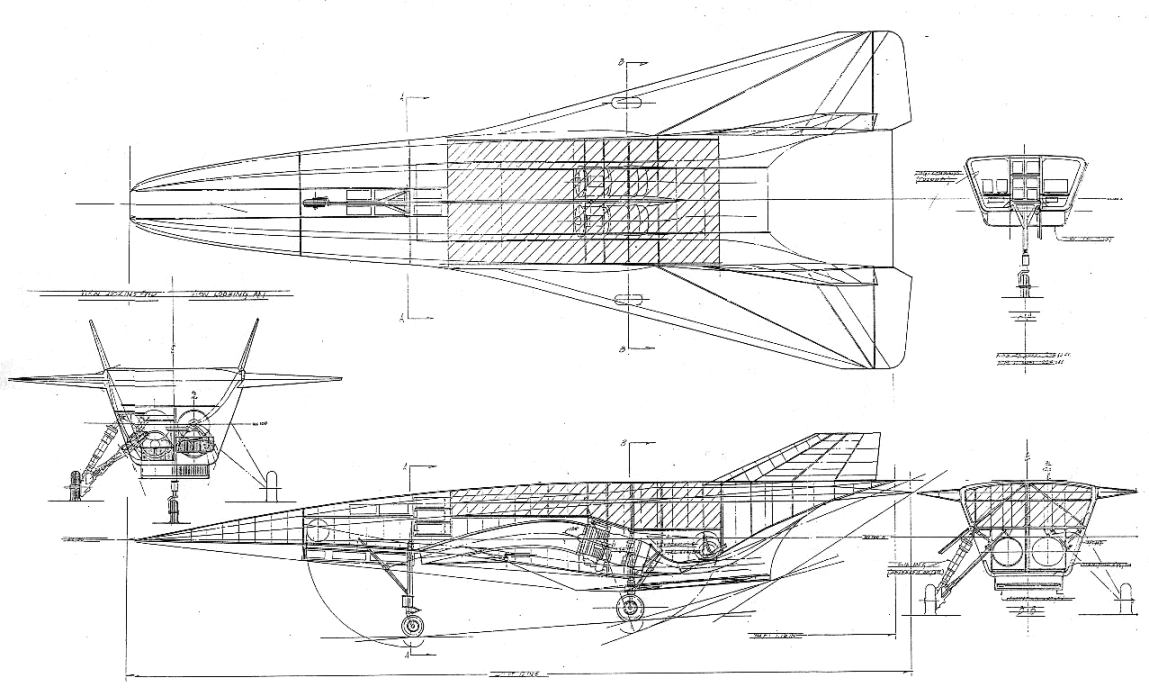
Dates from 2000-2001.
The configuration is very similar to NASP-derived operational vehicles designed at General Dynamics-Fort Worth, so that would be my guess as to where this concept originated.

http://asmedigitalcollection.asme.org/index.aspx
Gas Turbines: Aircraft Engine
Propulsive Performance of Ideal Detonation Turbine Based Combined Cycle Engine
A novel two-mode propulsion system based on detonation combustion, known as a detonation turbine based combined cycle engine (DTBCC), was proposed and thermodynamically analyzed for potential application to aircrafts whose flight Mach number is from 0 to 5. The obvious advantage of the two-mode system is that both modes share the same multidetonation chambers. The quasi-stable total temperature and total pressure for inlet conditions of the turbine could be realized in this hybrid pulse detonation engine. A key parameter (drive area ratio) was defined as the ratio of the outflow area at the head to the cross-sectional area of the detonation chamber. The calculated results showed that the increase of the drive area ratio led to the increase in the mass flow entering the turbine; however, this led to the decrease of the total inlet temperature, the total inlet pressure, and the expansion-pressure ratio of the turbine. Compared with an ideal turbojet engine, the inlet temperature of the turbine in a preturbine hybrid pulse detonation engine with a drive area ratio of 1 was 80 K lower than the former under the same pressure ratio and the same fuel-air ratio. In other words, the increase of the drive area ratio may improve the performance of this hybrid pulse detonation engine. Variation of the pressure ratio was adapted to varied flight Mach numbers by a change of the drive area ratio, which induced the enlargement of the operating range. Finally, a performance model was established to research the components’ characteristics and the propulsive performance of the engine. Preliminary performance estimates suggested that thrust and specific fuel consumption of the two-mode propulsion system were superior to the existing turbine based combined cycle designsHypersonic Rocket-Plane Program Inches Along, Stalls
Latest update [?]
The path toward a hypersonic space plane has been a slow one, filled
with twists and turns one would expect given the technological leap
involved. Speeds of Mach 8+ place tremendous heat and resistance
stresses on a craft. Building a vehicle that is both light enough to
achieve the speeds desired at reasonable cost, and robust enough to
survive those speeds, is no easy task.
Despite the considerable engineering challenges ahead, the potential of a truly hypersonic aircraft for reconnaissance, global strike/ transport, and low-cost access to near-space and space is a compelling goal on both engineering and military grounds. The question, as always, will be balancing the need for funding to prove out new designs and concepts, with risk management that ensures limited exposure if it becomes clear that the challenge is still too great. In October 2008, the US Congress decided that FALCON/Blackswift had reached those limits. That decision led to the program’s cancellation, though some activities will continue.
Despite the considerable engineering challenges ahead, the potential of a truly hypersonic aircraft for reconnaissance, global strike/ transport, and low-cost access to near-space and space is a compelling goal on both engineering and military grounds. The question, as always, will be balancing the need for funding to prove out new designs and concepts, with risk management that ensures limited exposure if it becomes clear that the challenge is still too great. In October 2008, the US Congress decided that FALCON/Blackswift had reached those limits. That decision led to the program’s cancellation, though some activities will continue.
The FALCON Hypersonic Vehicle: Technical Challenges
The famous SR-71 Blackbird, which cruised at “only” Mach 3, made heavy use of titanium and had to use slip fits instead of rivets in many places, so that the plane wouldn’t tear itself apart when 800-900 degree surface temperatures made it expand. On the ground, and when being refueled shortly after takeoff, the plane would reportedly leak like a sieve until speed and heat had given the airframe its requisite fit.
While the state of the art has advanced since then, so have the desired speeds – and the accompanying challenges.
Making more advanced powered hypersonic aircraft work was always going to take some fancy technologies – and ongoing American interest in military initiatives like “Prompt Global Strike” may yet lead to renewed funding. Engines that can boost a plane to hypersonic speeds are very different, however, as metals tend to melt at the temperatures created by air friction at Mach 9. On Oct 8/06, journalist , back when HTV-3 was still a live goal:
Engineers are improving on this so-called “combined cycle” to propel the Falcon, using a more powerful “scramjet” in place of the ramjet. “We need propulsion that transitions seamlessly from Mach 0 to Mach 9 or 10,” says Lockheed Martin’s Bob Baumgartner.These technologies have uses in a variety of systems, including hypersonic missiles. That’s why research in these areas hasn’t stopped, even if HTV-3 is no longer on the planing board. covers a program aimed at researching those kinds of advanced combined engine technologies.
“For low speed, we’re looking at turbine engines that can perform at speeds from Mach 0 to Mach 4, then a scramjet … that takes over anywhere between Mach 2 and Mach 4 and goes up to higher Mach numbers — depending on the fuel, up to Mach 10,” says Steven Walker, a Darpa researcher. “For sure, we know how turbines work, but we don’t have turbines that work at Mach 4.”
“The scramjets are still at a low-technology readiness level,” he adds. “Combining both flow-paths and looking at how you transition from one to the other and the transition back … that’s all new, break-through technology.”
“Thermal protection … is the next major enabling technology,” Baumgartner says, referring to ways of coping with the high temperatures that Mach-10 flight generates. “We’re looking at durable metallic thermal protection panels to withstand heat and keep it away from structure. We’re also looking at ceramic panels.”
The FALCON Hypersonic Vehicle: Industrial Teams
Lockheed Martin has reportedly completed conceptual design of an HTV-3X demonstrator. The are also performing subscale tests of the combined-cycle propulsion system, and have ground-tested inlets and nozzles that are shared by the high-mach turbine and the ramjet.
At this point, Lockheed Martin appears to have secured a team for the main bid that also includes Boeing and ATK.
Rolls-Royce and Williams International are developing candidates for the 13-inch diameter high-Mach jet turbine.
A round-combustor dual-mode ramjet under development by Pratt & Whitney Rocketdyne will be used as the ramjet, once the turbine has accelerated the vehicle to a high enough speed.
The FALCON Hypersonic Vehicle: Program History & Changes
ttaining Mach 19, the vehicle will briefly exit the Earth’s atmosphere and re-enter flying between 19 and 28 miles above the planet’s surface. Demonstrating hypersonic glide technology and setting the stage for HTV-2 represent the primary focus of the lower risk, lower performance initial flight.
…For the second demonstration, scheduled for 2008 or 2009, the Falcon HTV-2 will feature a different structural design, enhanced controllability and higher risk performance factors during its high-speed journey. Like its predecessor, the system will reach Mach 22 and then finish its one-hour plus mission over the Pacific Ocean… As of January 2006, HTV-1 is beginning construction.”According to a however, technical difficulties forced a change in schedule. DARPA and prime contractor Lockheed Martin decided not to build and fly the two planned HTV-1 craft, after subcontractor C-CAT experienced delamination problems with the curved leading edges of the carbon-based aeroshell. Instead, they have shifted efforts to a different HTV-2 design whose multi-piece aeroshell has thinner leading edges, and will be easier to build because it’s less of a technical stretch.
As the Flight International article notes, these developments had effects on the program’s schedule:
“The change will delay a first flight from 2007 for the HTV-1, to late 2008 for the first of two ground-launched, expendable HTV-2s. These will be followed by a reusable HTV-3 closer in design to the objective hypersonic cruise vehicle (HCV). The Mach 10 HTV-3 will be unpowered, but Walker says DARPA has received funding to develop and ground test a propulsion system for the HCV.HTV-3, at least, seemed to retain a great deal in common with the of a reusable Falcon vehicle:
Walker says Lockheed has selected a high-Mach turbine engine and supersonic-combustion ramjet (scramjet) for a combined-cycle powerplant enabling the HCV to take off from a runway and accelerate to a hypersonic cruise. Tests of the “inward-turning” inlet and scramjet are planned for later this year [2006].”
“On the other hand, the third and final Falcon HTV, slated for 2009, will be a departure from the previous demonstrations. The reusable hypersonic glider will lift off from NASA’s Wallops Flight Facility at Wallops Island, Va., and then more than an hour later, be recovered in the Atlantic Ocean.That proved a bridge too far, for now. In the end, HTV-3 was canceled, and FALCON flights were restricted to rocket-carried, unpowered test vehicles. There were to be 2 HTV-2 launches, in 2010 and 2011, costing about $308 million. Following the failure of the 1st such test in April 2010, the fate of the 2nd test was uncertain, but DARPA appears ready to go ahead.
In addition, the HTV-3, flying at Mach 10, will be designed to achieve high aerodynamic efficiency and to validate external heat barrier panels that will be reusable.”
FALCON Hypersonic Vehicle: Contracts & Key Events
Nov 16/10: What happened to HTV-2? An independent Engineering Review Board (ERB) says the problem was more yaw than expected, which turned into a roll that was too fast for the autonomous flight control system to handle. The programmed response to that was “flight termination” via a forced roll and pitchover directly into the ocean, which is what happened 9 minutes into the 30 minute flight.
That’s the bad news. The good news is that DARPA got data from the flight covering aerothermal, aerodynamic, thermal protection, navigation, guidance and control; and now knows that the flight termination system works. DARPA TTO Director David Neyland thinks HTV needs tweaks rather than a full redesign, and wants to repeat the test in late 2011, after adjusting the vehicle’s center of gravity, decreasing its angle of attack (nose-up angle), and augmenting the flaps with the onboard reaction control system.
April 26/10: “Team Vandenberg launched the first Minotaur IV Lite launch vehicle at 4 p.m. April 22 from Space Launch Complex-8 here. The rocket launched the Defense Advanced Research Projects Agency’s Falcon Hypersonic Technology Vehicle 2. The 30th Space Wing commander, Col. David Buck, was the launch decision authority.”
Unfortunately, a DARPA statement said that:
“The launch vehicle executed first-of-its-kind energy management maneuvers, clamshell payload fairing release and HTV-2 deployment… Approximately 9 minutes into the mission, telemetry assets experienced a loss of signal from the HTV-2. An engineering team is reviewing available data to understand this event.”Aviation Week adds that:
“Based on a mission timeline released by DARPA in December, the HTV-2 was between beginning reentry and starting its hypersonic glide when telemetry signals were lost.”
“This requirement is for the charter of one (1) US flag vessel. The period of performance, if all option periods are exercised, is estimated to be approximately 29 days. The firm period will commence on 03 April 2010, lasting for 21 days. In addition, there will be three (3) 3-day options periods. Vessel is required to provide a variety of terminal impact area support functions to an experimental Hypersonic Technology Vehicle (HTV-2) flight test that is part of the DARPA-USAF Falcon Program. The HTV-2 will be launched on a booster from Vandenberg AFB, CA to an impact near the Reagan Test Site (RTS), Kwajalein Atoll in the Marshall Islands. A launch date is planned to occur within an 8-day window lasting from April 20 through April 27, 2010. The vessel will be required to operate in close proximity to the RTS. The primary activities supported in the impact area will be (1) to transport, deploy and retrieve a set of nine impact scoring rafts, along with two Telemetry Buoys and (2) to obtain telemetry from the HTV-2 in its final seconds of flight all the way to impact from a vessel standoff distance of approximately 10 nm.”This upcoming test is supposed to demonstrate HTV-2′s ability to withstand hypersonic heat buildup, and remain controllable. The launch rocket is expected to be a Minotaur IV Lite
Oct 13/08: DARPA cancels the Blackswift reusable hypersonic testbed, after a skeptical Congress slashed the program’s FY 2009 budget from $120 – 10 million, cutting DARPA funding from $70 – 10 million and eliminating the Air Force’s requested $50 million entirely.
DARPA says it will continue with the Falcon program by flying unpowered hypersonic test vehicles in 2009, launched by Orbital Sciences Minotaur boosters in order to demonstrate their aerodynamic and structural technologies.
DARPA had hoped to award a contract for the demonstrator later in 2008, and was believed to be negotiating with a Lockheed Martin Skunk Works-led team that included Boeing. The Blackswift was expected to fly in 2012.]
July 25/08: Aviation Week’s that ATK and Boeing have joined Lockheed Martin’s “Blackswift” team for the FALCON HTV project, adding that Northrop Grumman has declined to bid.
If the reports are true, this would make it very difficult to field a credible competing team from American industry.
March 13/08: DARPA Director Dr. Tony Tether discusses FALCON during before the House Armed Services Subcommittee on Terrorism, Unconventional Threats and Capabilities [PDF]:
“When the U.S. Decides to act, we envision using new hypersonic vehicles to quickly reach any point on earth without the need to organize an air refueling tanker fleet to support a long-range mission. With this vision in mind, DARPA’s Falcon program has been working to vastly improve the U.S capability to promptly reach other points on the globe. A major goal of the program is to flight test key hypersonic cruise vehicle technologies in a realistic flight environment. Recently we conducted both low- and high-speed wind tunnel tests that validate the stability and control of the hypersonic technology vehicle across the flight regime. The program is also developing a vehicle test bed called Blackswift. By the end of 2012, our goal is for Blackswift to take off under its own turbojet power from a runway, accelerate to Mach 6 under combined turbojet/scramjet propulsion, and land on a runway.”Dec 14/07: A $6 million increment of a $40.8 million modification to a previously awarded “other transaction for prototypes agreement,” as part of the Falcon HTV program’s Phase 3.
Phase 3 will include fabrication and assembly of 2 hypersonic technology vehicles to be flight-tested during 2009. Work will be performed in Palmdale, CA (9%), King of Prussia, PA (79%), and Fort Worth, TX (12%), and is expected to be completed in December 2009. Funds will expire at the end of the current fiscal year. This is a sole source award (HR0011-04-9-0010/P00032).
April 10/07: A $10.2 million modification to a previously awarded other transaction for prototypes agreement to exercise an option for the Falcon Combined Cycle Engine Technology portion of the Falcon Hypersonic Technology Vehicle effort.
Work will be performed in Palmdale, CA (20%); Philadelphia, PA (73%); and Fort Worth, TX (7%), and is expected to be complete in September 2008 (HR0011-04-9-0010, P00027).
Oct 25/06: A $33.2 million modification to a previously awarded other transaction for prototypes agreement, to continue development and demonstration of the Hypersonic Technology Vehicle portion of the Falcon program. Work will be performed in Palmdale (20%), Philadelphia, PA (73%), and Fort Worth, TX (7%), and is expected to be completed in September 2008. This agreement is incrementally funded, and this is a sole source award (HR0011-04-9-0010/P00022).
Aug 22/06: A $14.6 million modification exercises options for prototypes, as part of an agreement to continue development and demonstration of the hypersonic technology vehicle portion of the FALCON program. Work will be complete in September 2008. This Agreement is incrementally funded; no funds are being obligated at this time (HR0011-04-9-0010/P00021).
“The Air Vehicles directorate has for several years conducted focused research on high temperature thermal protection systems that support high-speed air vehicles. The primary application of this technology is to un-powered hypersonic technology vehicles such as those being developed in the DARPA/AFSPC Falcon Program. However, this technology has many other applications to high-speed air, re-entry and space access vehicles. Ongoing research into these thermal protection systems is approximately half complete; this effort will carry the research through to completion over the next five years.”June 27/05: An $8.9 million increment of a $19.9 million modification to a previously awarded other transaction for prototypes agreement. It exercises two options to continue development and demonstration of the hypersonic technology vehicle portion of the Falcon program. Work will be performed in Palmdale, CA and will be complete in September 2008. $2 million will expire at the end of FY 2005 (HR0011-04-9-0010).
March 16/05: A $10.6 million increment toward the DARPA/USAF The increment is part of a $55.2 million modification that exercises the option for Phase IIb of Task 2 (Hypersonic Technology Vehicle). Work will be performed in Palmdale, CA (41.5%) and King of Prussia, PA (58.5%) and will be completed in December 2005. $3 million of these funds will expire at the end of FY 2005 (HR0011-04-9-0010, P00006).
Aug 6/04: A $7.6 million increment of an $8.4 million other transaction for prototypes agreement. It covers Phase IIa of Task 2 (hypersonic technology vehicle) of the DARPA/Air Force Falcon program. Work will be performed in Palmdale, CA (41.5%) and King of Prussia, PA (58.5%) and will be complete in February 2005. $4.6 million of the funds will expire at the end of FY 2004. This was a limited competition among the 4 participants in Phase I of the Falcon HTV program (HR0011-04-9-0010).

Lockheed Martin F-22 Raptor
From Wikipedia, the free encyclopedia
| F-22 Raptor | |
|---|---|
 |
|
| An F-22 flies over Andrews Air Force Base (AFB) | |
| Role | Stealth air superiority fighter |
| National origin | United States |
| Manufacturer | Lockheed Martin Aeronautics Boeing Defense, Space & Security |
| First flight | 7 September 1997[1] |
| Introduction | 15 December 2005 |
| Status | In service |
| Primary user | United States Air Force |
| Produced | F-22: 1996–2011[2] |
| Number built | 195 (8 test and 187 operational aircraft)[2][3] |
| Program cost | US$66.7 billion[4] |
| Unit cost |
US$150 million (flyaway cost for FY2009)[5]
|
| Developed from | Lockheed YF-22 |
| Developed into | Lockheed Martin X-44 MANTA Lockheed Martin FB-22 |
The aircraft was variously designated F-22 and F/A-22 prior to formally entering service in December 2005 as the F-22A. Despite a protracted development and operational issues, the USAF considers the F-22 a critical component of its tactical air power, and claims that the aircraft is unmatched by any known or projected fighter.[7] The Raptor's combination of stealth, aerodynamic performance, and situational awareness gives the aircraft unprecedented air-to-air capabilities.[8] Air Chief Marshal Angus Houston, former Chief of the Australian Defence Force, said in 2004 that the "F-22 will be the most outstanding fighter plane ever built."[9]
The high cost of the aircraft, a lack of clear air-to-air missions due to delays in Russian and Chinese fighter programs, a ban on exports, and development of the more versatile and lower cost F-35 led to the end of F-22 production.[N 1] A final procurement tally of 187 operational production aircraft was established in 2009 and the last F-22 was delivered to the USAF in 2012.
Contents
Development
Origins
Main articles: Advanced Tactical Fighter and Lockheed YF-22
Each design team produced two prototype air vehicles, one for each of the two engine options. The Lockheed-led team employed thrust vectoring nozzles on YF-22 for enhanced maneuverability in dogfights. The ATF's increasing weight and cost drove out some features during development. A dedicated infra-red search and track (IRST) system was downgraded from multi-color to single color and then deleted, the side-looking radars were deleted and the ejection seat requirement was downgraded from a fresh design to the existing McDonnell Douglas ACES II.[15]
After a 90-day flight test validation of the prototypes, on 23 April 1991, Secretary of the USAF Donald Rice announced the YF-22 as the winner of the ATF competition.[16] The YF-23 design was considered stealthier and faster while the YF-22 was more maneuverable.[17] The aviation press speculated that the YF-22 was also more adaptable to the U.S. Navy's Navalized Advanced Tactical Fighter (NATF), but by 1992, the Navy had abandoned NATF.[18] In 1991, the USAF planned to buy 650 aircraft.[19]
Production and procurement
Primary contractor Lockheed Martin Aeronautics manufactures the majority of the airframe and performs final assembly at Dobbins Air Reserve Base in Marietta, Georgia; program partner Boeing Defense, Space & Security provides additional airframe components as well as avionics integration and training systems.[20] F-22 production was split up over many subcontractors across 46 states to increase Congressional support,[21][22] though this production split may have contributed to increased costs and delays.[23] Many capabilities were deferred to post-service upgrades, reducing the initial cost but increasing total program cost.[24] Each aircraft built required "1,000 subcontractors and suppliers and 95,000 workers".[25]The F-22 had several design changes from the YF-22. The swept-back angle on the wing's leading edge was decreased from 48° to 42°, while the vertical stabilizers were shifted rearward and their area decreased by 20%.[26] To improve pilot visibility, the canopy was moved forward 7 inches (18 cm), and the engine intakes moved rearward 14 inches (36 cm). The shapes of the wing and stabilator trailing edges were refined to improve aerodynamics, strength, and stealth characteristics.[27][28] Due to increasing weight during development, range and aerodynamic performance were slightly reduced.[29]
The first F-22, an engineering and manufacturing development (EMD) aircraft named Raptor 4001, was unveiled at Marietta, Georgia on 9 April 1997, and first flew on 7 September 1997.[30] In 2006, the Raptor's development team, composed of over 1,000 contractors and the USAF, won the Collier Trophy, American aviation's most prestigious award.[31] The F-22 was in production for 15 years, at a rate of roughly two per month during peak production.[32]
The USAF had originally envisioned ordering 750 ATFs at a cost of $26.2 billion, with production beginning in 1994; however, the 1990 Major Aircraft Review led by Secretary of Defense Dick Cheney altered the plan to 648 aircraft beginning in 1996. In 1994, the number was cut to 438 aircraft that would enter service by 2004, and in 1997 the number was further cut to 339.[33] By 2003, the existing funding limited the purchase to 277 fighters, and in 2004, the Department of Defense (DoD) further reduced the number to 183 operational production aircraft.[34] In 2006, a multi-year procurement plan was implemented that would save $15 billion but raise the cost of each aircraft. The total cost of the program by 2006 was $62 billion, at which point the USAF still sought to acquire 381 F-22s divided among seven active duty combat squadrons and three integrated Air Force Reserve Command and Air National Guard squadrons.[35] In 2007, Lockheed Martin received a $7.3 billion contract that raised the order number of production F-22s to 183 and extended manufacturing through 2011.[36]
In April 2006, the cost of the F-22 was assessed by the Government Accountability Office (GAO) to be $361 million per aircraft, with $28 billion invested in F-22 development and testing; the Unit Procurement Cost was estimated at $178 million in 2006, based on a production run of 181 aircraft.[37][38] It was estimated by the end of production, $34 billion will have been spent on procurement, resulting in a total program cost of $62 billion, around $339 million per aircraft. The incremental cost for an additional F-22 was estimated at about $138 million in 2009.[35][39] In March 2012, the GAO increased the estimated cost to $412 million per aircraft.[40]
Ban on exports
The F-22 cannot be exported under American federal law.[41] Customers for U.S. fighters are either acquiring earlier designs such as the F-15 Eagle and F-16 Fighting Falcon or shall acquire the F-35 Lightning II Joint Strike Fighter, which contains technology from the F-22 but is designed to be cheaper, more flexible, and available for export.[42] In September 2006, Congress upheld the ban on foreign F-22 sales.[43] Despite the ban, the 2010 defense authorization bill included provisions requiring the DoD to prepare a report on the costs and feasibility for an F-22 export variant, and another report on the impact of F-22 export sales on U.S. aerospace industry.[44][45]
The IAF would be happy to equip itself with 24 F-22s, but the problem
at this time is the U.S. refusal to sell the aircraft, and its
$200 million price tag.
Israeli Air Force (IAF) chief procurement officer Brigadier-General Ze'ev Snir.[46]
Production termination
Throughout the 2000s, the need for F-22s was debated due to rising costs and the lack of relevant adversaries. In 2006, Comptroller General of the United States David Walker found that "the DoD has not demonstrated the need" for more investment in the F-22,[55] and further opposition to the program was expressed by Secretary of Defense Donald Rumsfeld, Deputy Secretary of Defense Gordon R. England, Senator John McCain, and Chairman of U.S. Senate Committee on Armed Services Senator John Warner.[56][57] In November 2008, Secretary of Defense Robert Gates stated that the Raptor was not relevant in post-Cold War conflicts such as the wars in Iraq and Afghanistan.[58] Nevertheless, in 2008, Congress passed a defense spending bill funding the continued production of the F-22 and the Pentagon released $50 million of the $140 million approved by Congress for four additional aircraft. This raised the operational production aircraft order number to 187 and left the Raptor program in the hands of the next executive administration.[59][60]In April 2009, Secretary Gates under the new Obama Administration called for ending F-22 production in fiscal year (FY) 2011, leaving the USAF with 187 operational production aircraft.[61] However, in June, the House Armed Services Committee inserted $369 million in the budget for a further 12 F-22s in FY 2011.[62] In July, General James Cartwright, Vice Chairman of the Joint Chiefs of Staff, stated to the Senate Committee on Armed Services his reasons for supporting termination of F-22 production, including shifting resources to the multirole F-35 to allow proliferation of fifth-generation fighters for three service branches and preserving the F/A-18 production line to maintain the military's electronic warfare (EW) capabilities in the EA-18G Growler.[63] Issues with the F-22's reliability and availability also raised concerns.[42][64] After President Obama threatened to veto further production, the Senate voted in July 2009 in favor of ending production and the House subsequently agreed to remove funds for the additional 12 aircraft and abide by the 187 cap.[65][66] Gates stated that the decision was taken in light of the F-35's capabilities,[67] and in 2010, he set the F-22 requirement to 187 aircraft by lowering the number of major regional conflict preparations from two to one.[68]
The Pentagon cannot continue with business as usual when it comes to the F-22 or any other program in excess of our needs.
Russian and Chinese fighter developments have fueled concern; in 2009, General John Corley, head of Air Combat Command, stated that a fleet of 187 operational production F-22s would be inadequate, but Secretary Gates dismissed this concern.[76] In 2011, Gates explained that Chinese fifth-generation fighter developments had been accounted when the number of F-22s was set, and that the U.S. would have a considerable advantage in stealth aircraft in 2025, even with F-35 delays.[77] In December 2011, the 195th and final F-22 was completed out of 8 test and 187 operational aircraft produced, and the jet was delivered to the USAF on 2 May 2012.[61][78]
Upgrades
The first combat-capable Block 3.0 aircraft first flew in 2001.[79] Increment 2, the first F-22 upgrade program, was implemented in 2005 and gave the aircraft the ability to employ Joint Direct Attack Munitions (JDAM).[80] In 2009, Increment 3.1 began testing, providing improved ground-attack capability through synthetic-aperture radar mapping and radio emitter direction finding, electronic attack and the GBU-39 Small Diameter Bomb (SDB).[81] This upgrade was applied to 149 Raptors, and the first upgraded aircraft was delivered in 2012.[82][83][84]Increment 3.2 is a two-part upgrade process; 3.2A focuses on electronic warfare, communications and identification, while 3.2B will allow the F-22 to better exploit the AIM-9X and AIM-120D missiles.[85][80] In 2009, three business jets were equipped with the Battlefield Airborne Communications Node (BACN) for communicating between the F-22 and other platforms prior to the Multifunction Advanced Data Link (MADL).[86] Lockheed Martin is developing IRST functionality into the AN/AAR-56 Missile Launch Detector (MLD).[87] The F-22 System Program Office is working with the 422d Test and Evaluation Squadron to integrate the Visionix Scorpion helmet-mounted cueing system (HMCS), capable of off-boresight missile launches, with the aircraft.[85] In March 2010, the USAF accelerated software portions of 3.2 to be completed in FY 2013.[88] Applying the 3.2 upgrade to 183 aircraft was estimated to cost $8 billion, which would be funded via the early retirement of legacy fighters.[89][90] In February 2013, Lockheed Martin's upgrade contract was modified to include the 3.2B features, bringing the total upgrade cost to $6.9 billion; the upgrade process is expected to be completed by 2023. The subsequent Increment 3.3 may include the adoption of an open avionics platform and air traffic control updates.[91][78]
In January 2011, the USAF opened the Raptor enhancement, development and integration (REDI) contract to bidders, with a $16 billion budget.[92] In November 2011, Lockheed Martin's upgrade contract was increased by $1.4 billion to a maximum value of $7.4 billion.[93][94] Of the $11.7 billion allocated for upgrades, almost $2 billion was for structural repairs and to increase the fleet's availability rate from 55.5% to 70.6% by 2015.[95] Some F-35 technology, such as more durable stealth coatings, have been applied to the F-22.[96][97] Elements such as MADL are delayed until the F-35 program is completed.[98] By 2012, the update schedule had slipped seven years because of "requirements and funding instability".[99] In 2016, the F-22 fleet is planned to have 36 Block 20 training aircraft and 149 Block 30/35 combat aircraft.
While no definitive cause was found for the frequent oxygen deprivation issues responsible for several incidents, including a fatal crash, the F-22 will be upgraded with a backup oxygen system, software upgrades and oxygen sensors to normal operations in spite of the problem.[100] In 2013, the faulty flight vest valves were replaced and altitude restrictions lifted; distance restrictions will be lifted once a backup oxygen system is installed.[101] In April 2014 the USAF confirmed in testimony to the Senate Armed Services Committee that installation of automatic backup oxygen systems on the F-22 fleet would be completed within twelve months.[102]
The F-22 was designed for a lifespan of 30 years and 8,000 flight hours, with a $100 million "structures retrofit program".[103] Investigations are being made for upgrades to extend their useful lives further.[104] In the long term, the F-22 is expected to eventually be replaced by the Next Generation TACAIR.[105]
Design
Overview
To withstand stress and heat, the F-22 makes extensive use of materials such as high-strength titanium alloys and composites whose structural weight percentages are 39% and 24% respectively.[111] The use of internal weapons bays allows the aircraft to maintain a comparatively higher performance while carrying a heavy payload over most other aircraft due to a lack of drag from external stores. It is one of only a few aircraft that can supercruise or sustain supersonic flight without the use of fuel-inefficient afterburners; targets can be intercepted which subsonic aircraft would lack the speed to pursuit and an afterburner-dependent aircraft lack the fuel to reach.[7][112]
The F-22 is highly maneuverable at both supersonic and subsonic speeds. Computerized fly-by-wire control system and full authority digital engine control (FADEC) make the aircraft highly departure resistant and enable it to remain controllable at aggressive pilot inputs.[113][114] The Raptor's relaxed stability and thrust vectoring allow the aircraft to turn tightly, and perform very high alpha (angle of attack) maneuvers such as the Herbst maneuver (J-turn) and Pugachev's Cobra. The F-22 is also capable of maintaining over 60° angle of attack while having some roll control, and the jet's high operating altitude is also a significant tactical advantage over legacy fighters.[115][116]
The F-22's combination of aerodynamic performance, sensor fusion, and stealth work together for increased effectiveness. Altitude, speed, and advanced active and passive sensors allow targets to be spotted at considerable ranges and increase weapons range. Altitude and speed also complement stealth's effectiveness by increasing distance between the aircraft and ground defenses and giving defensive systems less time to react.[117][7][118]
Avionics
Key avionics include BAE Systems EI&S AN/ALR-94 radar warning receiver (RWR),[119] Lockheed Martin AN/AAR-56 Infra-Red and Ultra-Violet MAWS (Missile Approach Warning System) and Northrop Grumman AN/APG-77 Active Electronically Scanned Array (AESA) radar. The RWR is a passive radar detector with more than 30 antennas are blended into the wings and fuselage for all-round coverage. Tom Burbage, former F-22 program head at Lockheed Martin, described it as "the most technically complex piece of equipment on the aircraft." The range of the RWR (250+ nmi) exceeds the radar's, allowing radar usage to be limited to increase stealth. The RWR can cue the radar to track approaching targets with a narrow beam (down to 2° by 2° in azimuth and elevation).[120]The AN/APG-77 radar, designed for air superiority and strike operations, features a low-observable, active-aperture, electronically scanned array that can track multiple targets in any weather. Additionally, the radar emissions can be focused in an electronic-attack capability to overload enemy sensors.[121][122] It changes frequencies more than 1,000 times per second to lower interception probability. The radar has an estimated range of 125–150 miles, though planned upgrades will allow a range of 250 miles (400 km) or more in narrow beams.[115]
Radar information is processed by two Raytheon Common Integrated Processor (CIP)s, each capable of processing up to 10.5 billion instructions per second. Information from the radar, other sensors, and external systems is filtered by the CIP in a process known as sensor fusion, combining and processing data from multiple systems into a common view to prevent the pilot from being overwhelmed.[123] The F-22's software has some 1.7 million lines of code, the majority involving processing radar data.[124] In 2007, tests by Northrop Grumman, Lockheed Martin, and L-3 Communications used the F-22's radar as a wireless data transceiver, able to transmit data at 548 megabits per second and receive at gigabit speed, far faster than the Link 16 system.[125]
The F-22 has a threat detection and identification capability comparative with the RC-135 Rivet Joint. The Raptor's stealth allows it to safely operate far closer to the battlefield, compensating for the reduced capability. The F-22 is capable of functioning as a "mini-AWACS", though the radar is less powerful than those of dedicated platforms such as the E-3 Sentry. The F-22 allows its pilot to designate targets for cooperating F-15s and F-16s, and determine whether two friendly aircraft are targeting the same aircraft. This radar system can sometimes identify targets "many times quicker than the AWACS". The radar is capable of high-bandwidth data transmission; conventional radio "chatter" can be reduced via these alternative means.[115] The IEEE-1394B data bus developed for the F-22 was derived from the commercial IEEE-1394 "FireWire" bus system.[126]
In 2009 former Navy Secretary John Lehman considered the F-22 to be safe from cyberattack, citing the age of its IBM software.[127] Former Secretary of the USAF Michael Wynne blamed the use of the DoD's Ada for cost overruns and delays on many military projects, including the F-22.[128] Cyberattacks on Lockheed Martin's subcontractors have reportedly raised doubts about the security of the F-22's systems and combat-effectiveness.[129]
Cockpit
The F-22 has a glass cockpit with all-digital flight instruments. The monochrome head-up display offers a wide field of view and serves as a primary flight instrument; information is also displayed upon six color liquid crystal display (LCD) panels.[130] The primary flight controls are a force-sensitive side-stick controller and a pair of throttles. The USAF initially wanted to implement direct voice input (DVI) controls, but this was judged to be too technically risky and was abandoned.[131] The canopy's dimensions are approximately 140 inches long, 45 inches wide, and 27 inches tall (355 cm x 115 cm x 69 cm) and weighs 360 pounds.[132]The F-22 has integrated radio functionality, the signal processing systems are virtualized rather than as a separate hardware module.[133] There has been several reports on the F-22's inability to communicate with other aircraft, and funding cuts have affected the development of the MADL data link.[134] Voice communication is possible, but not data transfer.[135]
The integrated control panel (ICP) is a keypad system for entering communications, navigation, and autopilot data. Two 3 in × 4 in (7.6 cm × 10.2 cm) up-front displays located around the ICP are used to display integrated caution advisory/warning data, communications, navigation and identification (CNI) data and also serve as the stand-by flight instrumentation group and fuel quantity indicator.[136][137] The stand-by flight group displays an artificial horizon, for basic instrument meteorological conditions. The 8 in × 8 in (20 cm × 20 cm) primary multi-function display (PMFD) is located under the ICP, and is used for navigation and situation assessment. Three 6.25 in × 6.25 in (15.9 cm × 15.9 cm) secondary multi-function displays are located around the PMFD for tactical information and stores management.[137]
The ejection seat is a version of the ACES II (Advanced Concept Ejection Seat) commonly used in USAF aircraft, with a center-mounted ejection control.[138] The F-22 has a complex life support system, which includes the on-board oxygen generation system (OBOGS), protective pilot garments, and a breathing regulator/anti-g (BRAG) valve controlling flow and pressure to the pilot's mask and garments. The protective garments are designed to protect against chemical/biological hazards and cold-water immersion, to counter g-forces and low pressure at high altitudes, and to provide thermal relief. It was developed under the Advanced Technology Anti-G Suit (ATAGS) project.[139] Suspicions regarding the performance of the OBOGS and life support equipment have been raised by several mishaps, including a fatal crash.[140]
Armament
The Raptor has three internal weapons bays: a large bay on the bottom of the fuselage, and two smaller bays on the sides of the fuselage, aft of the engine intakes.[141] It can carry six medium range missiles in the center bay and one short–range missile in each side bay;[142] Four of the medium range missiles can be replaced with two bomb racks that can each carry one medium-size or four smaller bombs.[7] Carrying armaments internally maintains the aircraft's stealth and minimizes additional drag. Missile launches require the bay doors to be open for less than a second, during which hydraulic arms push missiles clear of the aircraft; this is to reduce vulnerability to detection and to deploy missiles during high speed flight.[143]The Raptor's very high cruise speed and altitude increase the effective ranges of its munitions; the F-22 has 50% greater employment range for the AIM-120 AMRAAM than prior platforms.[114] The range will be further extended with the eventual introduction of the AIM-120D. While specifics are classified, it is expected that JDAMs employed by F-22s will have twice or more the effective range of legacy platforms.[148] In testing, a Raptor dropped a 1,000 lb (450 kg) JDAM from 50,000 feet (15,000 m), while cruising at Mach 1.5, striking a moving target 24 miles (39 km) away.[149]
While the F-22 typically carries weapons internally, the wings include four hardpoints, each rated to handle 5,000 lb (2,300 kg). Each hardpoint has a pylon that can carry a detachable 600 gallon fuel tank or a launcher holding two air-air missiles. However, the use of external stores degrades the F-22's stealth, maneuverability and speed. The two inner hardpoints are "plumbed" for external fuel tanks; the hardpoints can be jettisoned in flight so the fighter can maximize its stealth after exhausting external stores.[150] A stealth ordnance pod and pylon is being developed to carry additional weapons internally.[151]
Stealth
The F-22 was designed to be highly stealthy to radar. Radar signature reduction measures include airframe shaping such as planform alignment of edges, fixed-geometry serpentine inlets that prevent line-of-sight of the engine faces from any exterior view, the use of radar absorbent material (RAM), and attention to detail such as hinges and pilot helmets that could provide a radar return. The Raptor was also designed to have decreased radio, heat and noise emissions as well as reduced visibility to the naked eye.[152] The aircraft's flat thrust vectoring nozzle reduces its infrared emissions to mitigate the threat of infrared homing ("heat seeking") surface-to-air or air-to-air missiles.[153] Further reduction in infrared signature includes special paint and active cooling of leading edges to deal with the heat buildup encountered during supersonic flight.[154]Compared to previous stealth designs like the F-117, the F-22 is less reliant on RAM, which are maintenance-intensive and susceptible to adverse weather conditions. Unlike the B-2, which requires climate-controlled hangars, the F-22 can undergo repairs on the flight line or in a normal hangar. The F-22 features a Signature Assessment System which delivers warnings when the radar signature is degraded and necessitates repair.[115] The exact radar cross-section (RCS) is classified; however, in 2009 Lockheed Martin released information indicating it has an RCS (from certain angles) of −40 dBsm – equivalent to the radar reflection of a "steel marble".[155] Effectively maintaining the stealth features can decrease the F-22's mission capable rate to 62–70%.[N 3]
The effectiveness of the stealth characteristics is difficult to gauge. The RCS value is a restrictive measurement of the aircraft's frontal or side area from the perspective of a static radar. When an aircraft maneuvers it exposes a completely different set of angles and surface area, potentially increasing radar observability. Furthermore, stealth contouring and radar absorbent materials are chiefly effective against high-frequency radars, usually found on other aircraft. Low-frequency radars, employed by weather radars and ground warning stations, are alleged to be less affected by stealth technologies and are thus more capable as detection platforms.[157][158] While faint or fleeting radar contacts make defenders aware that a stealth aircraft is present, reliably vectoring interception to attack the aircraft is much more challenging.[159]
Operational history
Designation and testing

Flight testing of the F-22 began in 1997 with Raptor 4001, the first EMD jet, and eight more F-22s would participate in the EMD and flight test program.[162] Raptor 4001 was retired from flight testing in 2000 and subsequently sent to Wright-Patterson Air Force Base (AFB) for survivability testing, including live fire testing and battle damage repair training.[163] EMD F-22s have been used for testing upgrades, and also as maintenance trainers.[164] The first production F-22 was delivered to Nellis AFB, Nevada, in January 2003.[165]
In May 2006, a released report documented a problem with the F-22's forward titanium boom, caused by defective heat-treating. This made the boom on roughly the first 80 F-22s less ductile than specified and potentially shortened the part's life. Modifications and inspections were implemented to the booms to restore life expectancy.[104][166]
In August 2008, an unmodified F-22 of the 411th Flight Test Squadron performed in the first ever air-to-air refueling of an aircraft using synthetic jet fuel as part of a wider USAF effort to qualify aircraft to use the fuel, a 50/50 mix of JP-8 and a Fischer-Tropsch process-produced, natural gas-based fuel.[167] In 2011, an F-22 flew supersonic on a 50% mixture of biofuel derived from camelina.[168]
Introduction into service
In December 2005, the USAF announced that the F-22 had achieved Initial Operational Capability (IOC).[169] During Exercise Northern Edge in Alaska in June 2006, in simulated combat exercises 12 F-22s of the 94th FS downed 108 adversaries with no losses.[35] In the exercises, the Raptor-led Blue Force amassed 241 kills against two losses in air-to-air combat; neither Blue Force loss was an F-22. During Red Flag 07-1 in February 2007, 14 F-22s of the 94th FS supported Blue Force strikes and undertook close air support sorties. Against superior numbers of Red Force Aggressor F-15s and F-16s, 6–8 F-22s maintained air dominance throughout. No sorties were missed because of maintenance or other failures, a single F-22 was judged lost against the defeated opposing force.[N 4] F-22s also provided airborne electronic surveillance.[170]The Raptor achieved Full Operational Capability (FOC) in December 2007, when General John Corley of Air Combat Command officially declared the F-22s of the integrated active duty 1st Fighter Wing and Virginia Air National Guard 192d Fighter Wing fully operational.[171] This was followed by an Operational Readiness Inspection (ORI) of the integrated wing in April 2008, in which it was rated "excellent" in all categories, with a simulated kill-ratio of 221–0.[172]
Deployments
In February 2007, while attempting its first overseas deployment to the Kadena Air Base in Okinawa, Japan, six F-22s of 27th Fighter Squadron flying from Hickam AFB, Hawaii, experienced multiple software-related system failures while crossing the International Date Line (180th meridian of longitude). The aircraft returned to Hawaii by following tanker aircraft. Within 48 hours, the error was resolved and the journey resumed.[173][174] By January 2013, F-22s have been deployed to Kadena Air Base seven times,[175] and in early 2013, F-22s were involved in U.S.-South Korean military drills.[176] In June 2014, F-22s from the 199th Fighter Squadron of the Hawaii Air National Guard were deployed to Malaysia to participate in the Cope Taufan 2014 exercise conducted by the USAF Pacific Air Forces and Royal Malaysian Air Force.[177]In November 2007, F-22s of 90th Fighter Squadron performed their first NORAD interception of two Russian Tu-95MS "Bear-H" bombers over Alaska.[178] Since then, F-22s have also escorted probing Tu-160 "Blackjack" bombers.[179] The first pair of F-22s assigned to the 49th Fighter Wing became operational at Holloman AFB, New Mexico, in June 2008.[180] In 2014, Holloman Raptors and their support personnel were reassigned to the reactivated 95th Fighter Squadron at Tyndall AFB.[181]
In 2008, two F-22 pilots proposed that USAF form a rapid response airborne package of one C-17 to support four F-22s, able to set up and engage in combat within 24 hours.[187]
Maintenance and training
F-22 had a mission ready rate of 62% in 2004, 70% in 2009, and was predicted to reach 85% as the fleet reached 100,000 flight hours.[64] Early on, the F-22 required more than 30 hours of maintenance per flight hour and a total cost per flight hour of $44,000; by 2008 it was reduced to 18.1, and 10.5 by 2009;[64] lower than the Pentagon's requirement of 12 maintenance hours per flight hour.[188] When introduced, the F-22 had a Mean Time Between Maintenance (MTBM) of 1.7 hours, short of the required 3.0 hours, but the figure was improved to 3.2 hours in 2012.[64] By 2013, the cost per flight hour had grown to $68,362, over three times as much as the F-16.[189]Each aircraft requires a month-long packaged maintenance plan (PMP) every 300 flight hours.[190] The stealth system, including its radar absorbing metallic skin, account for almost one third of maintenance.[64] The canopy was redesigned after the original design lasted an averaged of 331 hours instead of the required 800 hours.[64] F-22 depot maintenance is performed at Ogden Air Logistics Complex at Hill AFB, Utah.[191]
In January 2007, the F-22 reportedly maintained 97% sortie rate, flying 102 out of 105 tasked sorties while amassing a 144-to-zero kill ratio during "Northern Edge" air-to-air exercises in Alaska. According to Lieutenant Colonel Wade Tolliver, squadron commander of the 27th Fighter Squadron, the stealth coatings of the F-22 are more robust than those used in earlier stealth aircraft, being less sensitive to weather and wear and tear.[115] However, rain caused "shorts and failures in sophisticated electrical components" when F-22s were posted to Guam.[192]
In its 2012 budget request, the USAF cut F-22 flight training hours by one-third to reduce operating costs.[193] DoD budget cuts led to F-22 demonstration flights being halted in 2013; the demonstration flights were resumed in 2014.[194][195] In 2012, it was reported that the F-22's maintenance demands have increased as the fleet aged; maintaining the stealth coatings is particularly demanding.[196][197]
Operational issues
Operational issues have been experienced and some have caused fleet-wide groundings. Critically, pilots have experienced a decreased mental status, including losing consciousness. There were reports of instances of pilots found to have a decreased level of alertness and/or memory loss after landing.[198] F-22 pilots have experienced lingering respiratory problems and a chronic cough; other symptoms include irritability, emotional lability and neurologic changes.[198] A number of possible causative factors were investigated, including possible exposure to noxious chemical agents from the respiratory tubing, pressure suit malfunction, side effects from oxygen delivery at greater-than-atmospheric concentrations, and oxygen supply disruptions. Other issues include minor mechanical problems and navigational software failures.[199] The fleet was grounded for four months in 2011 before resuming flight, but reports of oxygen issues persisted.[200]In 2005, the Raptor Aeromedical Working Group, a USAF expert panel, recommended several changes to deal with the oxygen supply issues.[201] In October 2011, Lockheed Martin was awarded a $24M contract to investigate the breathing difficulties.[202] In July 2012, the Pentagon concluded that a pressure valve on flight vests worn during high-altitude flights and a carbon air filter were likely sources of at least some hypoxia-like symptoms. Long-distance flights were resumed, but were limited to lower altitudes until corrections had been made. The carbon filters were changed to a different model to reduce lung exposure to carbon particulates.[203][204] The breathing regulator/anti-g (BRAG) valve, used to inflate the pilot's vest during high G maneuvers, was found to be defective, inflating the vest at unintended intervals, causing the pilot to shallow-breathe.[205] The on-board oxygen generating system (OBOGS) also unexpectedly reduced oxygen levels during high-G maneuvers.[206] In late 2012, Lockheed Martin was awarded contracts to install a supplemental automatic oxygen backup system, in addition to the primary and manual backup.[207] Changes recommended by the Raptor Aeromedical Working Group in 2005 received further consideration in 2012;[208] the USAF reportedly considered installing EEG brain wave monitors on the pilot's helmets for inflight monitoring.[209][210]
New backup oxygen generators and filters have been installed on the aircraft. The coughing symptoms have been attributed to acceleration atelectasis, which may be exacerbated by the F-22's high performance; there is no present solution to the condition. The presence of toxins and particles in some ground crew was deemed to be unrelated.[211] On 4 April 2013, the distance and altitude flight restrictions were lifted after the F-22 Combined Test Force and 412th Aerospace Medicine Squadron determined that breathing restrictions on the pilot were responsible as opposed to an issue with the oxygen provided.[212][213][214]
Variants
- YF-22A – pre-production technology demonstrator for ATF demonstration/validation phase; two were built.
- F-22A – single-seat production version, was designated F/A-22A in early 2000s.
- F-22B – planned two-seat variant, but was canceled in 1996 to save development costs.[215]
- Naval F-22 variant – a carrier-borne variant of the F-22 with variable-sweep wings for the U.S. Navy's Navy Advanced Tactical Fighter (NATF) program to replace the F-14 Tomcat. Program was canceled in 1993.[215] Former SoAF Donald Rice has called the possibility of the naval variant the deciding factor for his choice of the YF-22 over the YF-23.[216]
Derivatives
The FB-22 was a proposed medium-range bomber for the USAF.[217] The FB-22 was projected to carry up to 30 Small Diameter Bombs to about twice the range of the F-22A, while maintaining the F-22's stealth and supersonic speed.[218] However, the FB-22 in its planned form appears to have been canceled with the 2006 Quadrennial Defense Review and subsequent developments, in lieu of a larger subsonic bomber with a much greater range.[219][220]The X-44 MANTA, or multi-axis, no-tail aircraft, was a planned experimental aircraft based on the F-22 with enhanced thrust vectoring controls and no aerodynamic surface backup.[221] The aircraft was to be solely controlled by thrust vectoring, without featuring any rudders, ailerons, or elevators. Funding for this program was halted in 2000.[222]
Operators
- Air Combat Command
- 1st Fighter Wing, Langley AFB, Virginia
- 27th Fighter Squadron – The first combat F-22 squadron. Began conversion in December 2005.[224]
- 94th Fighter Squadron
- 53d Wing, Eglin AFB, Florida
- 57th Wing, Nellis AFB, Nevada
- 325th Fighter Wing, Tyndall AFB, Florida
- 43d Fighter Squadron – The first squadron to operate the F-22 and continues to serve as the Formal Training Unit.[227] Known as the "Hornets", the 43d was re-activated at Tyndall in 2002.
- 95th Fighter Squadron[228]
- 1st Fighter Wing, Langley AFB, Virginia
- Air Force Materiel Command
- 412th Test Wing, Edwards AFB, California
- 411th Flight Test Squadron – Conducted competition between YF-22 and YF-23 from 1989 to 1991. Continues to conduct flight test on F-22 armaments and upgrades.
- 412th Test Wing, Edwards AFB, California
- Pacific Air Forces
- 3d Wing, Elmendorf AFB, Alaska
- 15th Wing, Hickam AFB, Hawaii
- 19th Fighter Squadron – Active Associate squadron to the 199th Fighter Squadron (Hawaii Air National Guard).[230]
- Air National Guard
- 192d Fighter Wing, Langley AFB, Virginia
- 149th Fighter Squadron, Virginia Air National Guard – Associate ANG squadron to the 1st Fighter Wing (Air Combat Command).
- 154th Wing, Hickam AFB, Hawaii[231]
- 192d Fighter Wing, Langley AFB, Virginia
- Air Force Reserve Command
- 44th Fighter Group, Tyndall AFB, Florida
- 301st Fighter Squadron – Associate AFRC squadron to the 325th Fighter Wing (Air Combat Command).
- 477th Fighter Group, Elmendorf AFB, Alaska
- 302d Fighter Squadron – Associate AFRC squadron to the 3d Wing (Pacific Air Forces).
- 44th Fighter Group, Tyndall AFB, Florida
Accidents
In April 1992, the second YF-22 crashed while landing at Edwards AFB. The test pilot, Tom Morgenfeld, escaped without injury. The cause of the crash was found to be a flight control software error that failed to prevent a pilot-induced oscillation.[232]The first F-22 crash occurred during takeoff at Nellis AFB on 20 December 2004, in which the pilot ejected safely before impact.[233] The crash investigation revealed that a brief interruption in power during an engine shutdown prior to flight caused a malfunction in the flight-control system;[162] consequently the aircraft design was corrected to avoid the problem. All F-22s were grounded after the crash; operations resumed following a review.[234]
On 25 March 2009, an EMD F-22 crashed 35 miles (56 km) northeast of Edwards AFB during a test flight,[235] resulting in the death of Lockheed Martin test pilot David P. Cooley.[42][236] An Air Force Materiel Command investigation found that Cooley momentarily lost consciousness during a high-G maneuver, then ejected when he found himself too low to recover. Cooley was killed during ejection by blunt-force trauma from windblast due to the aircraft's speed. The investigation found no design issues.[237][238]
On 16 November 2010, an F-22 from Elmendorf AFB crashed, killing the pilot, Captain Jeffrey Haney.[239] The F-22 fleet was restricted to flying below 25,000 feet, before being grounded while the accident was investigated.[240] The accident was attributed to a bleed air system malfunction following the detection of an engine overheat condition, which shut down the Environmental Control System (ECS) and OBOGS. The accident review board ruled the pilot was to blame, as he did not react properly and did not engage the emergency oxygen system.[241] The pilot's widow sued, claiming the aircraft has defective equipment;[242] the manufacturers later reached a settlement.[243] In response to the investigation results, the engagement handle for the emergency oxygen system was redesigned; the emergency oxygen system should engage automatically when OBOGS is shut down due to engine failure.[244] On 11 February 2013, the DoD's Inspector General released its report, which stated that the USAF had erred in assigning blame to Haney for the crash and that conclusions were not sufficiently supported by facts; the USAF stated that it stood by its conclusions.[245]
During a training mission, an F-22 crashed to the east of Tyndall AFB, on 15 November 2012. The pilot ejected safely and no injuries were reported on the ground.[246] The investigation determined that a "chafed" electrical wire ignited the fluid in a hydraulic line, causing a fire that damaged the flight controls.[247]
Aircraft on display
EMD F-22A 91-4003 is on display at the National Museum of the United States Air Force.[248]Specifications (F-22A)
Data from USAF,[7] F-22 Raptor Team web site,[249] Manufacturers' data,[250][251] Aviation Week,[115] and Journal of Electronic Defense,[120]
General characteristics- Crew: 1
- Length: 62 ft 1 in (18.90 m)
- Wingspan: 44 ft 6 in (13.56 m)
- Height: 16 ft 8 in (5.08 m)
- Wing area: 840 ft² (78.04 m²)
- Airfoil: NACA 64A?05.92 root, NACA 64A?04.29 tip
- Empty weight: 43,340 lb (19,700 kg)
- Loaded weight: 64,460 lb (29,300 kg[N 5])
- Max. takeoff weight: 83,500 lb (38,000 kg)
- Powerplant: 2 × Pratt & Whitney F119-PW-100 Pitch Thrust vectoring turbofans
- Dry thrust: 23,500 lb[252] (104 kN) each
- Thrust with afterburner: 35,000+ lb[7][252] (156+ kN) each
- Fuel capacity: 18,000 lb (8,200 kg) internally, or 26,000 lb (11,900 kg) with two external fuel tanks. About 3,050 gal or 20,333 lb JP-8 (without additions) internally.[253]
- Maximum speed:
- At altitude: Mach 2.25 (1,500 mph, 2,410 km/h) [estimated][109]
- Supercruise: Mach 1.82 (1,220 mph, 1,960 km/h)[109]
- Range: >1,600 nmi (1,840 mi, 2,960 km) with 2 external fuel tanks
- Combat radius: 410 nmi (with 100 nmi in supercruise) (470 mi, 760 km)
- Ferry range: 2,000 mi (1,740 nmi, 3,220 km)
- Service ceiling: >65,000 ft (20,000 m)
- Wing loading: 77 lb/ft² (375 kg/m²)
- Thrust/weight: 1.09 (1.26 with loaded weight & 50% fuel)
- Maximum design g-load: −3.0/+9.0 g[109]
- Guns: 1× 20 mm (0.787 in) M61A2 Vulcan 6-barrel Gatling cannon in right wing root, 480 rounds
- Air to air loadout:
- Air to ground loadout:
- 2× 1,000 lb (450 kg) JDAM or 8× 250 lb (110 kg) GBU-39 Small Diameter Bombs
- 2× AIM-120 AMRAAM
- 2× AIM-9 Sidewinder
- Hardpoints: 4× under-wing pylon stations can be fitted to carry 600 U.S. gallon drop tanks or weapons, each with a capacity of 5,000 lb (2,270 kg).[254]
- AN/APG-77 radar: 125–150 miles (200–240 km) against 1 m2 (11 sq ft) targets (estimated range)[115]
- AN/AAR-56 missile approach warning system (MAWS)[87]
- AN/ALR-94 radar warning receiver (RWR): 250 nmi (463 km) or more detection range[120]
- MJU-39/40 flares for protection against IR missiles[255]
Pratt & Whitney J58
From Wikipedia, the free encyclopedia
| J58 | |
|---|---|
 |
|
| J58 engine on display at the Evergreen Aviation & Space Museum | |
| Type | Turbojet |
| Manufacturer | Pratt & Whitney |
| First run | 1958 |
| Major applications | Lockheed A-12 Lockheed SR-71 |
Contents
Design and development
Origins
The J58 had its origins in the bigger JT9 (J91) engine. It was a 3/4 scale JT9 with a mass flow of 300 lb/s, down from 400 lb/s and known by the company designation JT11.[2] The JT11 was initially proposed for the US Navy, hence its Navy designation J58.[2] It was also promoted for various Navy and Air Force aircraft which never materialised, for example Convair F-106, North American F-108, Convair B-58C and North American A3J.[2] The J58 was initially developed for the US Navy [3] to power the planned version (using the J58)[4] of the Martin P6M jet flying boat.[5] The P6M started out using Allison J71-A-4 engines and then switched to the Pratt & Whitney J75 as the J58 wasn't ready due to development problems. Upon cancellation of this aircraft, it was selected for the Convair Kingfish and for the Lockheed A-12, YF-12A and SR-71. Other sources link its origin to the USAF's requirement for a powerplant for the WS-110A, the future XB-70 Valkyrie.[6][7]Testing
There were many failures of the J58 in testing. Catastrophic failures were not uncommon with the engines being destroyed when something failed in the compressor section for instance. Also the rear half of the engine could be blown off if the afterburner liner failed.[8] In July 1962 the engine completed the pre-flight testing phase and was ready for use in a test aircraft. One early problem, when it was installed in the Lockheed A-12, concerned ignition. The Pratt & Whitney engineers could not get the engine to start regardless of what procedure they implemented. The wind tunnel testing of the scale model did not reveal that the full scale engines requirement for air was so immense - around 100,000 cubic feet per second[9] - that instead of air flowing out of the compressors 4th stage bleed ducts, flow reversal occurred and air was drawn into the compressor from the rear of the engine. Pratt & Whitney added an air bleed door to improve airflow during ground starts.[10][11]Re-design for Mach 3.2
The compressor redesign, as well as addressing the need for high temperature materials such as Waspaloy in the rear stages[13] had to address the aerodynamic shortcomings inherent in any turbomachine compressor when ingesting very hot air (800 °F (427 °C) at Mach 3.2).[14] The route chosen to keep the J58 compressor pumping was to bleed air from the compressor 4th stage through 6 external tubes to the afterburner. In addition a 2-position trailing edge flap was added to the inlet guide vanes.[15] The bleed and adjustable flap position enabled the compressor to still work efficiently despite the high temperatures delivered to it by the intake.
Other possible ways to achieve the same end are given in section "Contemporary compressor solutions for flight at Mach 3". The afterburner received the exhaust from the turbine as well as the bleed air from the compressor. Most of the compressor bleed was required for cooling the afterburner duct and propelling nozzle and the remainder was used, together with the turbine exhaust, to burn the afterburner fuel flow.[15] The combustor liner and flame holders were sprayed with ceramic thermal barrier coating[16] to allow sustained afterburner operation at temperatures up to 3,200 °F (1,760 °C).[13]
Contemporary compressor solutions for flight at Mach 3
Alternative solutions to combat the adverse effects of high inlet temperature on the aerodynamic performance of the compressor were rejected by the Pratt & Whitney patentee, Robert Abernethy.[17] One of those solutions was used in a contemporary installation. The GE YJ93/XB-70 used a variable stator compressor to avoid front stage stall and rear stage choking.[18] Another possible solution, pre-compressor cooling, was used on the MIG-25. Water/methanol was injected from a spray mast in front of the compressor to lower the intake temperature for short durations at maximum speed.[19] Pre-compressor cooling was also proposed for a Mach 3 reconnaissance Phantom[20] and the Mach 3+ F-106 RASCAL project.[21]Starting
A variety of engine starting operations were available throughout the life of the A-12, F-12 and SR-71 aircraft, including: A twin chamber mono-fuel starter, attached to the engine only for starting, an AG330 starter cart, with two Buick Wildcat V8 internal combustion engines driving a common output, spinning the J58 to 3,200 rpm before the turbojet could self-sustain.Fuel
The engine's high operating speeds and temperatures required a new jet fuel, JP-7. Its reluctance to be ignited required triethylborane (TEB) to be injected into the engine to ignite it, and to ignite the afterburner in flight; above -5 °C TEB spontaneously ignites in contact with air. Each engine carried a nitrogen-pressurized sealed tank with 600 cm3 (20.7 ounces) of TEB, sufficient for at least 16 starts, restarts, or afterburner lights; this number was one of the limiting factors of SR-71 endurance, as after each air refueling the afterburners had to be reignited.[22] When the pilot moved the throttle from cut-off to idle position, fuel flowed into the engine, and shortly afterwards an approx. 50 cm3 (1.7 ounce) shot of TEB was injected into the combustion chamber, where it spontaneously ignited and lit the fuel with a green flash. In some conditions, however, the TEB flow was obstructed by coking deposits on the injector nozzle, hindering restart attempts. Refilling the TEB tank was a perilous task; the maintenance crew wore silver fire suits.[23] Conversely, the JP-7 fueling was so safe that some aircraft maintenance was permitted during filling. The chemical ignition was chosen instead of a conventional igniter for reliability reasons, and to reduce mechanical complexity. The TEB tank is cooled with fuel flowing around it, and contains a disk that ruptures in case of overpressure, allowing TEB and nitrogen to discharge into the afterburner.The fuel flowing into the engine is used as a coolant to cool the engine, hydraulic fluid, oil, TEB tank, afterburner nozzle actuator control lines, air conditioning systems, and the parts of the airframe subjected to aerodynamic heating.
The engine lubricant was a silicone-based grease. It was solid at room temperature, and was preheated prior to engine start.
The complete engine installation or propulsion system
Introduction
The propulsion system consisted of the intake, engine, nacelle or secondary airflow and ejector nozzle(propelling nozzle).[24] The propulsive thrust distribution between these components changed with flight speed.at Mach 2.2 inlet 13% - engine 73% - ejector 14%
at Mach 3.0+ inlet 54% - engine 17.6% - ejector 28.4%[24]
Intake
The intake had to supply air to the engine with minimum pressure loss and distortion and at the speed dictated by the engine, namely about Mach 0.4. It had to do this at all flight conditions.Nacelle airflow and ejector nozzle
The ejector nozzle performed the reverse function of the inlet accelerating the turbine exhaust from about Mach 0.4 back up to Mach 3.[25] Mach 3 exhaust velocity is higher than Mach 3 flight velocity due to the much higher temperature in the exhaust. The nacelle airflow from the intake controlled the expansion of the hot engine exhaust in the ejector nozzle.[26] This air flowed around the engine and served also to cool the hot external parts of the engine and to purge any combustible mixtures in the event of a fuel or oil leak in the nacelle.Applications
Specification of JT11D-20

Cambridgeshire, UK, alongside a Lockheed SR-71A Blackbird
General characteristics
- Type: afterburning turbojet with compressor bleed bypass
- Length: 17 ft 10 in (5.44 m) (an additional 6 in (15 cm) at max. temp.)
- Diameter: 4 ft 9 in (1.45 m)
- Dry weight: approx. 6,000 lb (2,700 kg)
Components
- Compressor: 9-stage, axial flow, single spool
- Combustors: 8 can, annular
- Turbine: two-stage axial flow
- Fuel type: JP-7 or JP-4 or JP-5 for emergency refuelling from any tanker (Mach 1.5 limit)[27]
Performance
- Maximum thrust: 34,000 pounds-force (150 kN) wet, 25,000 pounds-force (110 kN) dry
- Overall pressure ratio: 7.5 at take off[28]
- Thrust-to-weight ratio: approx. 6
- air flow: 300 lb/s, (136 kg/s)at take off[28]

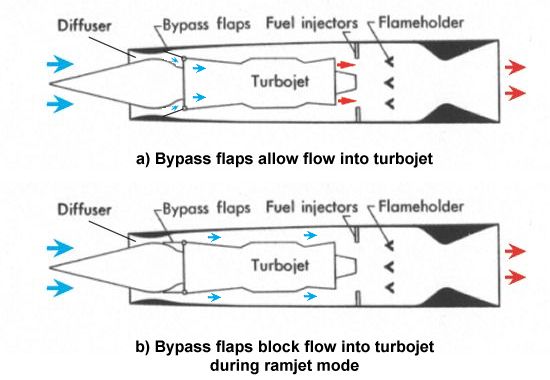

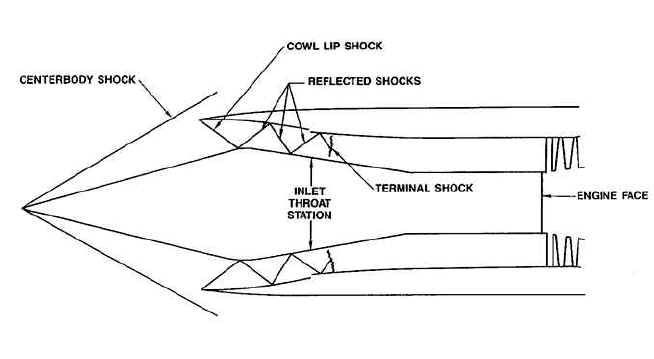
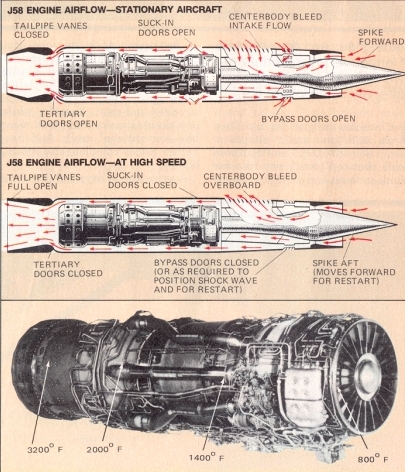
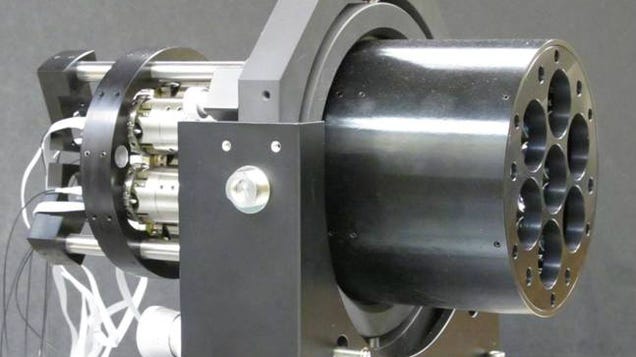
DARPA is going gaga over the pew-pew. The department just awarded a
Northrop Grumman a $20.2 million contract to begin the second phase of
its Excalibur Program—one which aims to give the same kind of
missile-frying laser cannon that's currently patrolling the Persian Gulf to America's Air Force.
Specifically, Northop has been contracted as part of Project
Endurance, which focuses on miniaturizing components as well as
developing tracking, identification, and engagement systems (basically
all the stuff that would allow a pilot to aim and fire a beam weapon).
Project Endurance is an offshoot of the department's larger Excalibur Project whose goal is to
"develop coherent optical phased array technologies to enable scalable
laser weapons that are 10 times lighter and more compact than existing
high-power chemical laser systems."
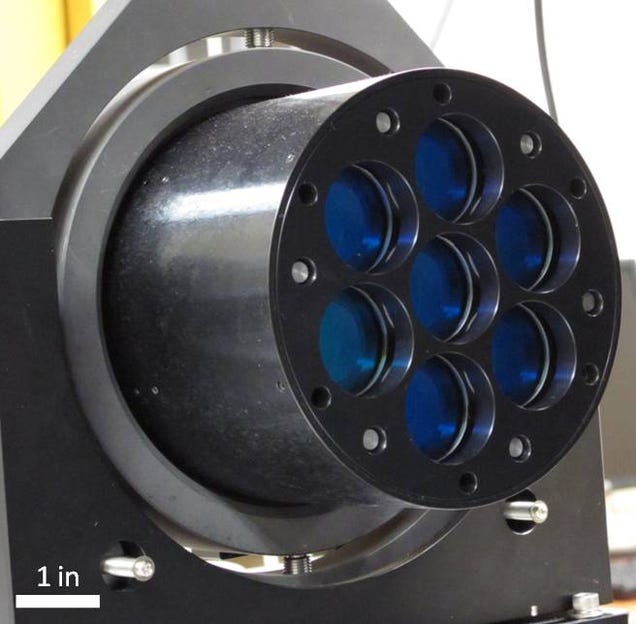
This
is, surprisingly, not an offensive weapon but is rather being developed
to counter incoming IR (heat-seeking) missiles. And by counter, I don't
mean simply dazzling the incoming threat, or leading it away from the
aircraft with decoys or chaff—this laser will simply burn through the
missile before it can detonate.
That's a tall order. You look at the size of the existing laser systems America has fielded in the past few years—like the HEL-MD and the laser aboard the USS Ponce—and
they're all enormous. What's more, they require massive amounts of
power to operate. So shrinking all these bits down (along with a means
of driving them) into a package that can fit under the wing of an
aircraft or even a drone (DARPA's looking to eventually put these
systems on Predators and Reapers because duh) is no easy feat.
As Valerie Coffey of The Optical Society writes,
The biggest challenge for researchers is creating a laser that can reach high enough powers to partially destroy or defeat a target while tracking numerous objects simultaneously. In turbulent atmospheric conditions, like dust and humidity, the laser must propagate efficiently and stay accurately focused on the target.... The platform must be compact enough to fit on a vehicle or even a soldier's shoulder, while the optics must be ruggedized to withstand shock and high irradiance.
To that
end, the Excalibur program has focused on using phased arrays of
electrically-driven lasers rather than the bulkier chemical lasers we
saw in Real Genius. Plus, DARPA is working to adapt this
same laser technology to also act as a radar array, target designator,
and comm system in addition to defense.
Northrop is
confident that it will be able to meet a March, 2016 deadline. Once
they do, DARPA's next goal is boosting the laser's maximum power output
to 100 kW—double what the HEL-MD can currently produce. [DARPA via NG - OSA]
"There are those that see JSF as the last manned fighter. I'm one that's inclined to believe that."
-- Adm. Mike Mullen, chairman of the U.S. Joint Chiefs of Staff
With Lockheed Martin's (NYSE: LMT ) introduction of the JSF -- the F-35 Joint Strike Fighter -- America now boasts two fully functional manned stealth fighter jets: the F-35 and the F-22 Raptor. Problem is ... China now has two, too.
Designed to mirror the capabilities of the F-22 and F-35, China's
Chengdu J-20 fighter and its recently unveiled Shenyang J-31 were both
designed -- or so the rumor goes -- from top-secret blueprints stolen
by Chinese hackers. So while China's "stealth" planes are not yet
operational, it seems likely that China's Air Force will soon boast a
stealth capability rivaling our own. Meanwhile, a newly aggressive
Russia is also hard at work developing a fifth-generation stealth
fighter.
All of which has U.S. generals thinking that right about now would be a good time to start thinking about developing a new kind of fighter jet.
Hold up a sec. Didn't Admiral Mullen say ...?
I know, I know. This seems to fly in the face of the 2009 assertion from Admiral Mike Mullen -- then chairman of the U.S. Joint Chiefs of Staff -- that the F-35 would be our "last manned fighter." Five years ago, we really thought this might be how things played out -- that the fifth-generation F-35 would also be the "last generation" of American fighter jets, giving Lockheed Martin a de facto monopoly on fighter jet production till the end of time.
But the thing is, times change, and so does technology. Five years on, the tech gap between America and its rivals has narrowed.
What's to be done
According to the defense journalists over at DefenseNews.com, "Potential adversaries are spending big on technology, and the U.S. can't afford to fall behind." It might even be nice if the U.S. could stay a step or two ahead. With that in mind, the Pentagon is putting together a wish list for things they'd like to stick in a new "F-X, next-generation air dominance" fighter jet:
For example, it might be nice if the new jet could fly at hypersonic speeds -- Mach 5 and up -- like Lockheed Martin's experimental Mach 6 SR-72 ...
Of course, fighter jets don't just travel in straight lines but are
able to maneuver at high G-forces as well. The Pentagon is thinking that
9 "gees" might be just about right ...
Twin engines -- in place of the single, dual-directional, United Technologies (NYSE: UTX ) -built F135 engine on the F-35 -- would help with both these tasks.
Meanwhile, for the "fighting" portions of the fighter jet's mission,
the Pentagon suggests it might arm the F-X with directed energy weapons
-- laser guns -- such as Kratos Defense & Security's (NASDAQ: KTOS ) 33-kilowatt Laser Weapon System, or the new, smaller, 25-kw laser that Raytheon (NYSE: RTN ) is building for the Army.
As U.S. Air Combat Command's Col. Tom Coglitore points out, "lasers have made significant progress over the last decade or two." With pretty much every defense contractor you can name now running a laser weapons project, Mark Gunzinger, retired Air Force colonel and senior fellow at the Center for Strategic and Budgetary Assessments, avers that laser guns on airplanes are "no longer a pipe dream."
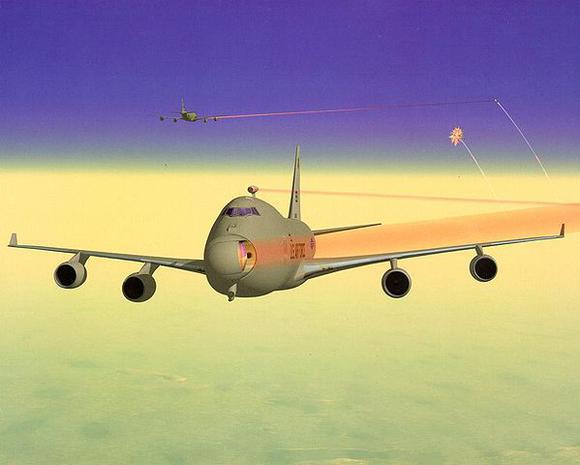
The U.S. Air Force has been experimenting with
Last but not least, the Pentagon continues to like the idea of
"optionally piloted" warplanes, which can carry a human pilot if need be
-- but which could also be piloted remotely, or by an on-board robot.
Who will build the F-X fighter jet -- and when?
When the F-35 Joint Strike Fighter was first announced more than a decade ago, we were told that the Air Force intended to build and fly these birds for a good six decades or more -- well into the 2070s. But already, there's talk of starting up an acquisition process for F-X by 2018, and of bringing the first sixth-generation F-X fighter to market as early as the 2030. So it seems Lockheed's F-35 could cease to be America's "last manned fighter" a lot sooner than any of us expected.
But who will build its replacement?
The short answer to that is probably Lockheed Martin. After all, the incumbent fighter jet-producer has a built-in advantage in these types of projects -- if for no other reason, then because it's got the most, and the most current, experience in building fighter jets.
The longer answer, though, is that there are enough items on the Pentagon's F-X fighter jet wish list to provide work for most, if not all, of the major defense contractors. Lockheed's got the pole position in fighter jets and their stealth technology, obviously. But Boeing's no slouch in aerospace, either. Both of these companies, and Raytheon and Kratos besides, have invaluable experience building laser weapons. Northrop Grumman (NYSE: NOC ) is tops in building unmanned aerial vehicles. United Technologies can build the engines -- you get the picture.
Long story short, if the F-X air dominance fighter jet does get built, there will be more than enough work -- and profits -- to go around.
America's Next Fighter Jet: Hypersonic, Packing Laser Guns, With a Robot in the Cockpit?
http://www.fool.com
-- Adm. Mike Mullen, chairman of the U.S. Joint Chiefs of Staff
With Lockheed Martin's (NYSE: LMT ) introduction of the JSF -- the F-35 Joint Strike Fighter -- America now boasts two fully functional manned stealth fighter jets: the F-35 and the F-22 Raptor. Problem is ... China now has two, too.
All of which has U.S. generals thinking that right about now would be a good time to start thinking about developing a new kind of fighter jet.
Hold up a sec. Didn't Admiral Mullen say ...?
I know, I know. This seems to fly in the face of the 2009 assertion from Admiral Mike Mullen -- then chairman of the U.S. Joint Chiefs of Staff -- that the F-35 would be our "last manned fighter." Five years ago, we really thought this might be how things played out -- that the fifth-generation F-35 would also be the "last generation" of American fighter jets, giving Lockheed Martin a de facto monopoly on fighter jet production till the end of time.
But the thing is, times change, and so does technology. Five years on, the tech gap between America and its rivals has narrowed.
What's to be done
According to the defense journalists over at DefenseNews.com, "Potential adversaries are spending big on technology, and the U.S. can't afford to fall behind." It might even be nice if the U.S. could stay a step or two ahead. With that in mind, the Pentagon is putting together a wish list for things they'd like to stick in a new "F-X, next-generation air dominance" fighter jet:
For example, it might be nice if the new jet could fly at hypersonic speeds -- Mach 5 and up -- like Lockheed Martin's experimental Mach 6 SR-72 ...
As U.S. Air Combat Command's Col. Tom Coglitore points out, "lasers have made significant progress over the last decade or two." With pretty much every defense contractor you can name now running a laser weapons project, Mark Gunzinger, retired Air Force colonel and senior fellow at the Center for Strategic and Budgetary Assessments, avers that laser guns on airplanes are "no longer a pipe dream."

The U.S. Air Force has been experimenting with
flying laser guns for years. Photo: Wikimedia Commons.
Who will build the F-X fighter jet -- and when?
When the F-35 Joint Strike Fighter was first announced more than a decade ago, we were told that the Air Force intended to build and fly these birds for a good six decades or more -- well into the 2070s. But already, there's talk of starting up an acquisition process for F-X by 2018, and of bringing the first sixth-generation F-X fighter to market as early as the 2030. So it seems Lockheed's F-35 could cease to be America's "last manned fighter" a lot sooner than any of us expected.
But who will build its replacement?
The short answer to that is probably Lockheed Martin. After all, the incumbent fighter jet-producer has a built-in advantage in these types of projects -- if for no other reason, then because it's got the most, and the most current, experience in building fighter jets.
The longer answer, though, is that there are enough items on the Pentagon's F-X fighter jet wish list to provide work for most, if not all, of the major defense contractors. Lockheed's got the pole position in fighter jets and their stealth technology, obviously. But Boeing's no slouch in aerospace, either. Both of these companies, and Raytheon and Kratos besides, have invaluable experience building laser weapons. Northrop Grumman (NYSE: NOC ) is tops in building unmanned aerial vehicles. United Technologies can build the engines -- you get the picture.
Long story short, if the F-X air dominance fighter jet does get built, there will be more than enough work -- and profits -- to go around.
A New, "Super" F-35 to Rule the U.S. Military?
Advanced derivatives of the tri-service Lockheed Martin F-35 Joint Strike Fighter could replace the Air Force’s F-22 Raptor, Boeing F-15C Eagle and F/A-18E/F Super Hornet, multiple sources told the National Interest. However, they added that the idea of replacing the high flying and fast Raptor with the slower and less agile F-35 was not well received by many within the Air Force.
“No doubt that the F-35 will be doing air dominance missions in the future,” one industry official said. “Especially with more internal air-to-air, and maybe a new engine.”
Both the U.S. Air Force (USAF) and the U.S. Navy (USN) have begun preliminary work on analysis of alternatives (AOA) for the sixth-generations of those aircraft. The Air Force effort, called the F-X, is aimed at recapitalizing its fleet of air superiority fighters while the Navy’s F/A-XX program is expected to produce a replacement for the Super Hornet. The Navy will start its formal AOA in 2015 while the Air Force’s analysis will start a little later—in about a year and a half from now.
The Air Force hopes to enter into a technology development phase in 2018.
While both the Navy and the Air Force are looking at many possible options to replace their jets, including modernized versions of current aircraft, new clean-sheet designs—manned and unmanned—and some other outside-the-box ideas, one of the major contenders to replace the F-22, F-15 and F/A-18E/F is a highly modified F-35.
“It will likely be one of the alternatives in the Analysis of Alternatives,” said a senior Air Force official.
The Navy, too, will likely consider a highly modified F-35 to fit its F/A-XX requirement, service officials confirmed. “We will both have to do it in order to baseline our capabilities and ensure the taxpayer and services are getting the best alternative,” the Air Force official said. “It's routine for us to look at whether or not existing systems or modifications to existing systems can fulfill our gaps.”
The Air Force official added that another alternative will be to modify and upgrade the tiny 186 aircraft-strong F-22 Raptor fleet. “Modifying the Raptor will be an option too,” he said. “I doubt either the F-22 or F-35 will ‘win.’”
The Air Force and Navy are adamant that their disparate mission requirements for the F-X and F/A-XX will mean that they will ultimately require separate solutions. “I would expect our requirements to be a lot different from the Navy’s,” Col. Tom Coglitore, who heads Air Combat Command’s Air Superiority Core Function Team and the F-X program, told the trade journal Aviation Week in its Oct. 13 issue. “Our system of systems would be more offensively minded and operate in more difficult and highly contested areas of operation than the areas the Navy will likely be operating in.”
Industry officials, however, are less certain that the Air Force and Navy will ultimately be able to afford separate platforms to replace their aging fleets. The most likely scenario is that budgetary realities will force the two services to develop a common platform. “USAF and Navy can ‘afford’ to have differences now, since everything is pre AoA. However, fiscal realities will force them to align technology and weapons investments,” the industry official said. “Their differences stem primarily from out-of-phase need dates, and different capability emphases.”
Given that defense spending does not look like it will increase in the near future—especially in the coming years when technologies for the F/A-XX and F-X will have to be developed—advanced versions of the F-35 might be the best option for the Air Force. “The USAF will need to factor F-35A—and ‘E’—into the air dominance equation,” the industry official said. “Especially when it’s loaded with next generation air-to-air missiles, and other technologies.”
The Navy, given the limitations of aircraft carriers and their increasing vulnerability to anti-ship cruise and ballistic missiles, might have to concede the high-end air superiority mission to the Air Force.
Arguably, the service already gave up that role with the demise of the Grumman F-14 Tomcat fleet and the cancellation of the Naval Advanced Tactical Fighter and A/F-X programs during the 1990s drawdown.
“The Navy may need to be content with ceding the uber-air dominance mission to the USAF due to the geometric constraints of their ‘mobile airbases,’” the industry official said.
A Lockheed Martin official would not provide any information on advanced F-35 derivatives that are currently in the works—but acknowledged that such projects are underway. “We cannot provide any details on either of these topics given their proprietary nature,” company spokeswoman Heather Kelso said.
Operational Air Force pilots with air superiority fighter experience were less than enthusiastic about the prospect of the F-35 replacing the Raptor or F-15. “I hope they get that we need to be well beyond the F-35 in the future and recycling a ramped up proposal isn't going to be good enough,” one senior officer said.
Another added that it was physically impossible for the F-35 to match, much less replace, the F-22. “F-35s will never be able to sit at the table with F-22s in the realm of air-to-air and SEAD/DEAD [suppression of enemy air defenses/destruction of enemy air defenses],” the senior Air Force pilot said. “Doesn't have the performance, doesn't have the payload, doesn't have the stealth.”
Another highly experienced F-22 pilot was equally unenthused about the prospect of an advanced F-35 derivative—even if that new variant was equipped with an advanced adaptive cycle engine. “That would be a really bad idea unless they finally got enough thrust with two engines!!” the pilot said. “It is an underpowered airplane from what I hear from my bros flying the jet. But, we have leveraged our tactical aviation future on this aircraft, so I guess we have to like it...”
Dave Majumdar has been covering defense since 2004. He currently writes for the U.S. Naval Institute, Aviation Week and The Daily Beast, among others. Majumdar previously covered national security issues at Flight International, Defense News and C4ISR Journal. Majumdar studied Strategic Studies at the University of Calgary and is a student of naval history. You can follow him on Twitter: @DaveMajumdar.
HAL AMCA
From Wikipedia, the free encyclopedia
(Redirected from Advanced Medium Combat Aircraft)
| Advanced Medium Combat Aircraft | |
|---|---|
| A CGI Generated model of the AMCA | |
| Role | Stealth multirole fighter |
| National origin | India |
| Manufacturer | Hindustan Aeronautics Limited |
| Designer | Aeronautical Development Agency, Defence Research and Development Organisation |
| Status | Under development |
| Primary users | Indian Air Force Indian Navy |
Contents
Development
In October 2008, the Indian Air Force asked the ADA to prepare a detailed project report on the development of a Medium Combat Aircraft (MCA) incorporating stealth features.[4]In February 2009, ADA director PS Subramanyam said at an Aero-India 2009 seminar, that they are working closely with Indian Air Force to develop a Medium Combat Aircraft. He added that according to the specification provided by the Indian Air Force, it would likely be a 20-ton aircraft powered by two GTX Kaveri engines.[5]
In April 2010, the Indian Air Force issued the Air Staff requirements (ASR) for the AMCA which placed the aircraft in the 25-ton category.[6]
Funding and future developments
In November, 2010, the Aeronautical Development Agency (ADA) soughtBy August 2011, the aircraft was in preliminary design phase. As of July 2012, with aerodynamic design optimisation near complete, the AMCA's broad specifications are final. The aircraft will have a weight of 16-18 tonnes with 2-tonnes of internal weapons and four-tonnes of internal fuel with a combat ceiling of 15-km, max speed of 1.8-Mach at 11-km.[9] The final design is expected to be shown to the air force by 2012, after which full scale development on the aircraft may start.[10] In February 2013, the Aeronautical Development Agency (ADA) unveiled a 1:8 scale model at Aero India 2013.[3]
Temporary intermission
The Ministry of Defense had put the project on hold wanting to make up for the protracted delays incurred by the ADA during the development of HAL Tejas.[11] According to a top Defence Ministry source, ″This decision was taken recently to let the ADA focus on the LCA project.″[11]Restart of work on AMCA
It was reported in January 2014 that work on AMCA has again commenced after HAL Tejas attained IOC, and that the AMCA will be developed by 2018.[12]Design
The AMCA will be designed with a very small radar cross-section and will also feature serpentine shaped air-intakes, internal weapons and the use of composites and other materials. It will be a twin-engined design using an imported engine as Kaveri has been cancelled. As part of the multidisciplinary design optimisation (MDO) currently on for the AMCA—wind-tunnel testing model of the MCA airframe was seen at Aero-India 2009.[13] —that design-based stealth features will include further optimised airframe shaping, edge matching, body conforming antennae and a low IR signature through nozzle design, engine bay cooling and work on reduced exhaust temperature.[2][9] The aircraft will have an internal weapons bay and radar-absorbent paint and composites.[14]As well as advanced sensors the aircraft will be equipped with missiles like DRDO Astra and other advanced missiles, stand-off weapons and precision weapons.[15] The aircraft will have the capability to deploy Precision Guided Munitions. The aircraft will feature extended detection range and targeting range with the ability to release weapons at supersonic speeds. The aircraft's avionics suite will include AESA radar, IRST and appropriate electronic warfare systems and all aspect radar warning receiver (RWR), Laser warning receiver (LWR), missile warning suite.[2][16]
In the Paris Air Show 2013, ADA revealed that the AMCA will have "net-centric warfare, vehicle management (including weapons), data fusion, decision aids, integrated modular avionics, internal carriage of weapons, signature control with sharpening for low observability, AESA radar, IR search-and-track, supersonic persistence, high-speed weapon release and thrust vectoring." The aircraft is designed to be multi-role, with the ability to undertake both long and short-range missions, and conduct both air-to-air and strike missions. Unlike the HAL Tejas which has a digital flight-control computer and hydraulic controllers, the AMCA is likely to have a distributed processing system employing fast processors and smart subsystems and will be electronically controlled via a "central computational system connected internally and externally on an optic-fiber channel by means of a multi-port connectivity switching module". This would require using the IEEE-1394B-STD rather than MIL-STD-1553B databus standard.[17]
The product design work of Advanced Medium Combat Aircraft has been started by the Defence Research and Development Organization (DRDO) and the vehicle is expected to be ready in 2018, Dr Tamilmani, Director General (Aeronautical Systems) DRDO, Bangalore has said.
Speaking to reporters on the sidelines of the three-day international meet on 'Product Life Cycle, Modelling, Simulation and Synthesis (PLMSS) at VIT university on Monday,’ he said the aircraft would be equipped with twin engines with super cruise power and for the first time it would be using the stealth technology to 'hide' from radar surveillance.
Operators
Specifications
All figures from SP's Aviation[9] and Dainik Bhaskar.[18]General characteristics
- Crew: 1 (pilot)
- Length: 13.20 m (43 ft 4 in)
- Wingspan: 8.20 m (26 ft 11 in)
- Height: 4.40 m (14 ft 9 in)
- Wing area: 38.4 m² (413 ft²)
- Empty weight: 16-18 tons ()
- Max. takeoff weight: 22-24 tons two tonnes of internal weapons and four tonnes of internal fuel ()
- Powerplant: × unknown will be imported as Kaveri cancelled
- Maximum speed: Mach 1.8+ (1,920+ km/h, 1,190 mph) at altitude of 11 km.
- Service ceiling: 15,000 m (49,200 f
These are NASA's coolest and strangest airplanes of the future
Jesus Diaz

Most people don't know this, but NASA doesn't only work in exploring space. Its contribution to airplane technology—National Aeronautics
and Space Administration—has been crucial to the development of safer,
faster, more efficient travel. These are their coolest future
concepts—some of which could enter service as soon as 2025.
These concepts have been developed working with private companies like Lockheed Martin, Northrop Grumman, and Boeing:
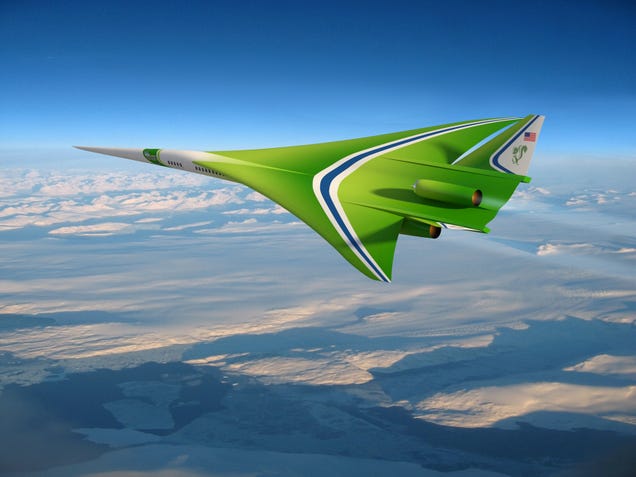
This updated future aircraft design concept from NASA research partner Lockheed Martin shows a few changes from another concept seen eight images earlier in this gallery. It is a good example of how simulations and wind tunnel tests, conducted over time, generate data that tell researchers how to improve a design to achieve goals. The goals for a future supersonic aircraft are to produce a much lower-level sonic boom and to reduce emissions. The ultimate goal is to achieve a low enough boom that a current ruling prohibiting supersonic flight over land might be lifted.
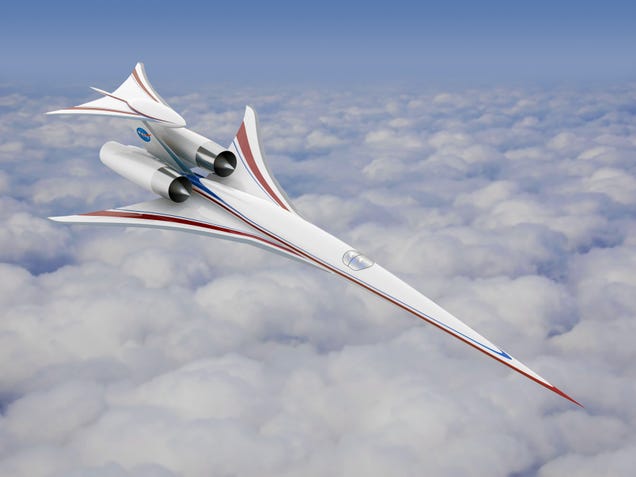
This concept of an aircraft that could fly at supersonic speeds over land is being used by researchers, especially at NASA's Langley Research Center, to continue to test ideas on ways to reduce the level of sonic booms. Its technologies – the F-100-like propulsion system, a tail blister, and the overall shape – are combined to achieve a lower target perceived decibel level.
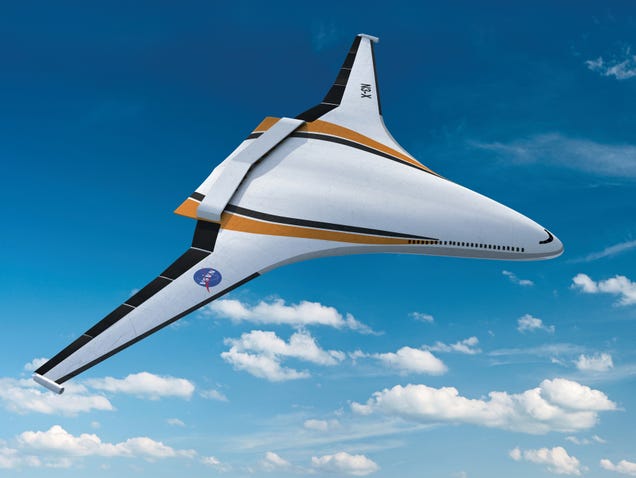
This idea for a possible future aircraft is called a "hybrid wing body" or sometimes a blended wing body. In this design, the wing blends seamlessly into the body of the aircraft, which makes it extremely aerodynamic and holds great promise for dramatic reductions in fuel consumption, noise and emissions.NASA develops concepts like these to test in computer simulations and as models in wind tunnels to prove whether the possible benefits would actually occur.This NASA concept, called the "N3-X," uses a number of superconducting electric motors to drive the distributed fans to lower the fuel burn, emissions, and noise. The power to drive these electric fans is generated by two wing-tip mounted gas-turbine-driven superconducting electric generators.
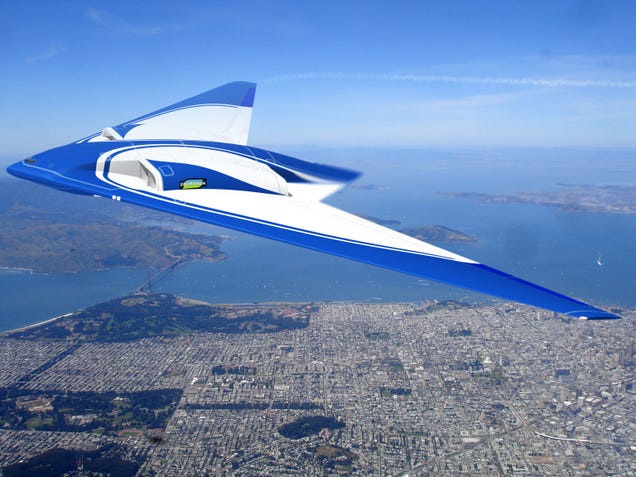
This computer-generated image shows a possible future "flying wing" aircraft, very efficiently and quietly in flight over populated areas. This kind of design, produced by Northrop Grumman, would most likely carry cargo at first and then also carry passengers.
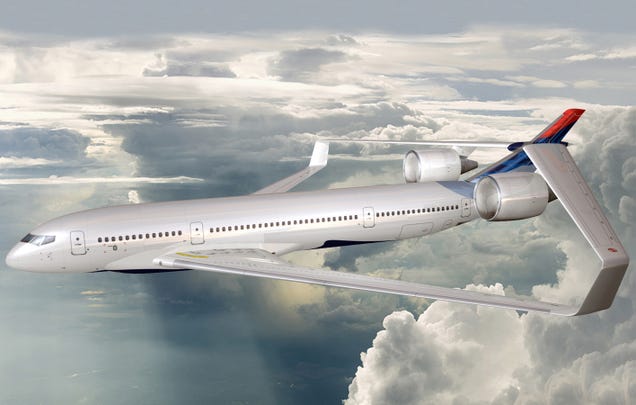
Lockheed Martin's advanced vehicle concept proposes a box wing design, which is now feasible thanks to modern lightweight composite (nonmetallic) materials, landing gear technologies and other advancements. Its Rolls Royce Liberty Works Ultra Fan Engine achieves a bypass ratio (flow of air around engine compared to through the engine) nearly five times greater than current engines, pushing the limits of turbofan technology to maximize efficiency.
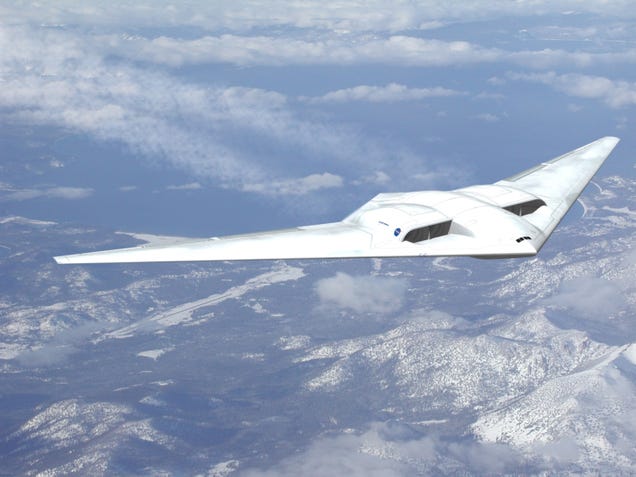
Northrop Grumman's concept is based on the extremely aerodynamic "flying wing" design. The four Rolls Royce engines are embedded in the upper surface of the wing to achieve maximum noise shielding. The company used its expertise in building military planes without a stabilizing tail to propose this design for the commercial aviation market.
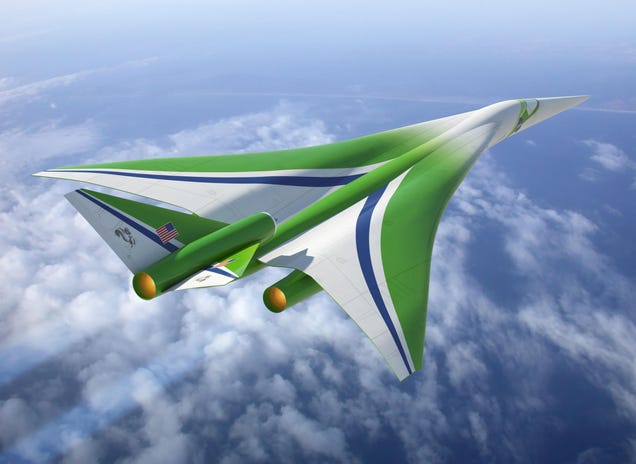
Our ability to fly at supersonic speeds over land in civil aircraft depends on our ability to reduce the level of sonic booms. NASA has been exploring a variety of options for quieting the boom, starting with design concepts and moving through wind tunnel tests to flight tests of new technologies. This rendering of a possible future civil supersonic transport shows a vehicle that is shaped to reduce the sonic shockwave signature and also to reduce drag.
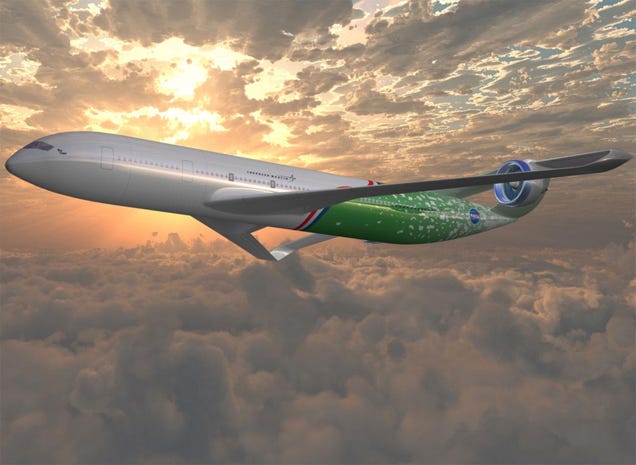
This artist's concept shows a possible future subsonic aircraft using a boxed- or joined-wing configuration to reduce drag and increase fuel efficiency. This design of an aircraft that could enter service in the 2020 timeframe is one of a number of designs being explored by NASA with teams of researchers from industry and universities.
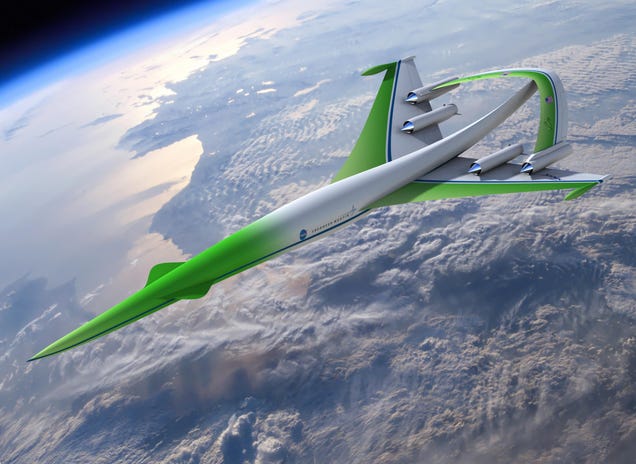
This future aircraft design concept for supersonic flight over land comes from the team led by the Lockheed Martin Corporation.The team used simulation tools to show it was possible to achieve over-land flight by dramatically lowering the level of sonic booms through the use of an "inverted-V" engine-under wing configuration. Other revolutionary technologies help achieve range, payload and environmental goals.This concept is one of two designs presented in April 2010 to the NASA Aeronautics Research Mission Directorate for its NASA Research Announcement-funded studies into advanced supersonic cruise aircraft that could enter service in the 2030-2035 timeframe.
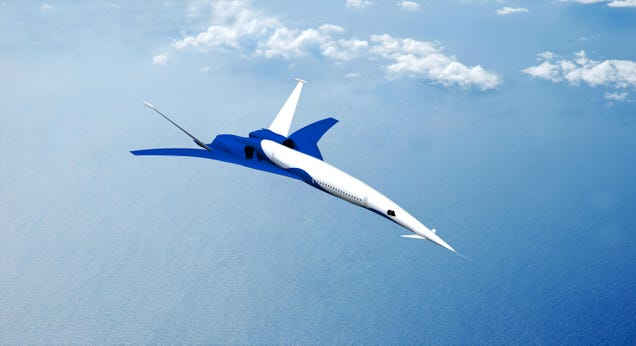
The "Icon-II" future aircraft design concept for supersonic flight over land comes from the team led by The Boeing Company.A design that achieves fuel burn reduction and airport noise goals, it also achieves large reductions in sonic boom noise levels that will meet the target level required to make supersonic flight over land possible.This concept is one of two designs presented in April 2010 to the NASA Aeronautics Research Mission Directorate for its NASA Research Announcement-funded studies into advanced supersonic cruise aircraft that could enter service in the 2030-2035 timeframe
Here comes the Pentagon's newest space plane
Think of it as a tiny, sub-orbital drone version of the Space Shuttle
By Robert Beckhusen, War is Boring | October 24, 2014
One concept for the new space shuttle.
(Northrop Grumman Image)

We're entering a new era of space flight. The result — if all the new toys in development work — will be cheaper, lighter, and more frequent travels into space.
One example is the XS-1, a program to build a space plane led by the Defense Advanced Research Projects Agency. In August, Northrop Grumman — which is competing with Boeing and Masten Space Systems for a final contract — revealed a concept for its version of the craft.
It's designed to be unmanned and capable of lifting small and medium-size satellites into space — like a tiny, sub-orbital drone version of the Space Shuttle — before arching back down to Earth.
"It would be a spacecraft that most resembles what people see in the movies," Brian Weeden, a former officer with the Air Force's Space Command, tells War is Boring.
Right now, in order to launch a satellite, NASA has to spend around $55 million per single-use rocket launch. But DARPA's goal is to develop a reusable space craft that can handle a quick space flight — at $5 million per launch.
Instead of spending months planning to launch a single rocket in a limited window of time, the XS-1 could be ready again in days — or even hours. DARPA's goal is even more radical. The agency wants a plane that can carry out 10 launches in as many days.
"If we could pull it off, it would enable much cheaper and faster access to space," Weeden says. "Something that many people see as the key to opening up space development."
It wouldn't just mean civilian applications. The military is interested in how to deploy cheaper and smaller spy satellites. The Pentagon's National Reconnaissance Office already tests these mini-satellites, designed to help U.S. Special Operations Forces track terrorists.
But Weeden points out that making the dream into reality is "extremely difficult," he adds. "There are a lot of very challenging engineering problems to solve."
There's a reason why the history of space flight largely involved single-use spacecraft. Building a reusable craft means designing for a lot more moving parts, which adds further complexity to an already complex machine.
Another problem is that reusable craft land on surface runways instead of splashing down in the water, requiring shock absorbers in order not to damage sensitive instruments.
The vehicles are subjected to extreme heat upon reentry, which causes wear and tear that must be repaired. They're also really heavy, as they don't shed depleted fuel tanks and rocket boosters when ascending, as multi-stage rockets do.
But Northrop Grumman's design might get around this problem. The XS-1 is not supposed to be 100 percent reusable.
Rather, the XS-1 is a two-stage craft. The reusable part is the space plane itself. Once blasting off from its launch pad, the plane will ascend to a ballistic trajectory, "probably something very similar to Virgin Galactic's SpaceShip Two," Weeden says.
Next, the craft fires a single-use rocket carrying the satellite payload into low-Earth orbit. The space plane itself never enters orbit — though it does enter space.
"That seems to be a very wise trade-off," Weeden says. "It means that your final vehicle is not fully reusable, but it sidesteps a lot of the trickiest engineering problems."
The other advantage XS-1 has is in its materials. Northrop Grumman owns Scaled Composites, the Mojave, California-based company that designed SpaceShip Two's polymer hull. This might just be strong enough to handle sub-orbital flights — while also being much lighter than the metal hull of the now-retired Space Shuttle.
But technology doesn't exist in a vacuum, rhetorically speaking. There's practical and financial reasons for the Pentagon's interest in reusable craft. However, the U.S. also doesn't want to rely on Russia anymore to lift American satellites into orbit, especially after Russia's invasion of Crimea.
The U.S. still cooperates with Russia on the International Space Station — Russia is the only country with manned spacecraft involved with the ISS program — but NASA cut off other ties with the Russian Space Agency in April.
It's all part of the U.S.'s renewed interest in space — and a new space race. The Air Force also has its own space plane, the X-37. The plane's third mission recently ended after 674 days in orbit. NASA is likewise developing a new rocket and manned capsule to once again send astronauts into orbit. Once these systems are built, and if XS-1 works out, there will be drones up there, too.
From drones to AKs, high technology to low politics, War is Boring explores how and why we fight above, on, and below an angry world. Sign up for its daily email update here or subscribe to its RSS Feed here.
America’s Advanced Stealth Jet Flies on 1990s Tech
The
Pentagon is counting on the F-22 Raptor for missions over Syria—and
maybe, one day, against Russia, too. Too bad so much of its hardware is
so retr
Though initially conceived as state-of-the-art technology in the early 1990s, some of the Raptor’s antiquated processors run at 25Mhz. That’s about 56 times slower than the multi-core chips in the iPhone 6.
The Air Force is making upgrades to the F-22 by adding better processors and newer fiber-optic data-buses, but the technology remains hopelessly obsolete compared to current-day consumer devices. Part of the reason for that is it is more difficult to predict how emerging technologies will develop. “Figuring out which technologies pay their way on a commercial product is generally easier than figuring out which technologies offer the best bang for the buck on a military one,” said analyst Richard Aboulafia at the Virginia-based Teal Group.
Not only are tens of billions in Pentagon cash at stake. The F-22, after decades of development, is finally becoming relevant to American security and geopolitics. The Raptor is flying missions over Syria, yes. More importantly, the Raptor—which was designed to be extremely stealthy, fly at very altitudes and at supersonic speeds for extended periods—could play a major role in the faceoff between Russia and the United States. In the case of major conflict, perhaps in Ukraine, the Raptor would be used to clear the air of enemy fighters and to smash enemy air defenses and thereby opening a corridor for friendly conventional warplanes.
The F-22’s archaic processors are just one of the ways that untold billions of taxpayer dollars are wasted by the Pentagon’s ponderously slow development processes. Oftentimes the Defense Department has to special order tiny batches of obsolete parts from questionable sources—which have occasionally been traced to places like China—to sustain these antiquated technologies. That is because those parts are no longer made in the U.S. Further, in most cases a single big contractor that developed the hardware is the only entity that is able to modify or upgrade a system because of its proprietary nature—often at exorbitant cost to the taxpayer. Taken together, billions are squandered every year.
Even the Pentagon’s newest stealth fighter, the nearly $400 billion Lockheed F-35 Joint Strike Fighter, isn’t immune. The F-35 has much better, newer, processors than the F-22, but even before the jet enters service, those electronics are being upgraded. “The F-35 mission systems architecture is far more flexible and upgradable compared to the F-22,” one industry source told The Daily Beast. “That was one of the ‘lessons learned.’ For example, the F-35 will likely get new processors in its mission computers down the road.”Though initially conceived as state-of-the-art technology in the early 1990s, some of the Raptor’s antiquated processors run at 25Mhz. That’s about 56 times slower than the multi-core chips in the iPhone 6.
So why doesn’t the Pentagon have always have state-of-the-art computers operating in all of its supposedly high-tech gear? The answer is that the Defense Department has a painstakingly slow process to write up its requirements before it builds anything. “Systems like the Raptor tend to have ‘dated’ components like processors because technology can advance rapidly after requirements are set,” one senior Air Force official told The Daily Beast. “Requirements must be set at some point in order to integrate with the rest of the pieces of a complex system, among many other reasons.”
The problem is that processor speeds tend to double about every 18 months, thanks to Moore’s Law. The Pentagon’s process for drawing up requirements just can’t keep up. “So [the requirements process] can be a pain but the reason it was created was to increase oversight in order to prevent cost overruns and failure to deliver the desired capabilities on time,” the official said. “Unfortunately, DOD [Department of Defense] probably overreacted and we are slowly correcting our course and coming to a more reasonable balance.”
By contrast, the technology industry in Silicon Valley works in a completely different way from the Pentagon. A company like Apple or Google does some market research, figures out where there might be room to develop a new product and then lets the engineers loose to figure out how best to design a new device that costs a certain amount. It delivers products quickly and efficiently, but it’s not the same as developing a new war machine. “Military products often break new scientific ground and technological ground, which is very different than surveying the world of on-the-shelf technologies and deciding what you want,” Aboulafia said.
Both defense industry and military officials told The Daily Beast that Silicon Valley’s approach would not work for the Pentagon. “I don’t think you can draw an analogy between Google/Apple systems and some complex weapon systems DOD acquires... although I would love it!” said the Air Force official. “While there is certainly room for improvement, the integration of platforms such as today’s aircraft are far more complex than what Google or Apple does… Can you image if we lost two Raptors for every 135 flights?”
Nonetheless, even though it took more than two decades and somewhere close to $70 billion to develop the Raptor, the high-flying supersonic stealth fighter has no equals even with the Pentagon’s sclerotic processes. “When you take into account that even though the Raptor was developed over two decades ago, no other nation or industrial base can come close to matching an integrated system like it,” the Air Force official said. “An iPhone has far fewer subsystems and they don’t have to operate at temperature, acceleration, or reliability extremes.”
That being said, the Pentagon can draw lessons from Silicon Valley even if it can’t adopt the tech industry model wholesale. The sheer amount of redundant bureaucracy needs to be eliminated. “Reduce the number of organizations and people involved with acquisition planning, including requirements and specification formulation, as well as source selection,” one industry official said.
Industry officials said the Pentagon needs to let the engineers come up with solutions or what industry calls “capability-based” requirements or specifications. The requirement might state a general purpose like: This aircraft must be able to hit X target though Y anticipated threat. The Pentagon also needs to develop hardware incrementally and have a long-term plan to modify that equipment over time rather than build something in one “big bang.” Further, the Defense Department should give companies “extra credit” for coming up with innovations, the industry official said.
The Pentagon should also adopt “open architecture” standards so that one contractor does not have a complete monopoly over upgrading a weapon system through its lifetime. “In the case of processors, they could be easily removed and replaced by any company... thus increasing competition, lowering price, and speeding up modernization efforts much more affordably while keeping pace with our potential adversaries,” an Air Force official said. “I think you'll see this trend significantly increase over the coming years. In fact, some future Raptor upgrades could include primes other than Lockheed leading the effort. Breaking the proprietary grip on DOD systems will be a huge leap in the right direction.”
Some industry officials would go further and mandate common interfaces for equipment—similar in concept to how USB ports work on home computers. “[I would] have ‘orchestrated diversity’ in defense systems—share common subsystems and interfaces--to avoid ‘winner take all’ industrial base issues,” an industry official said.
Ultimately though, “figuring out military needs is somewhat harder than figuring out commercial market wants,” Aboulafia said.
Is The F-35's Targeting System Really 10 Years Behind Current Systems?
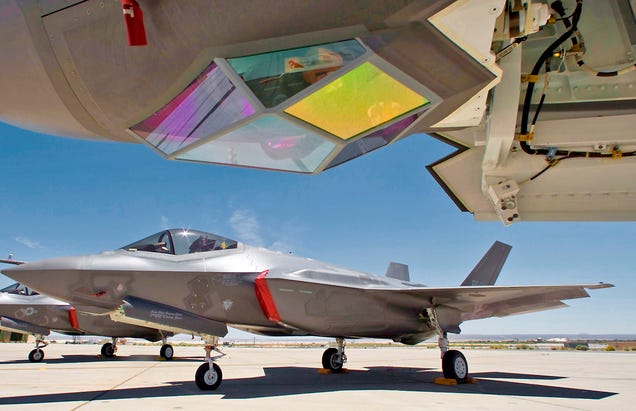
Yesterday, the Daily Beast ran a scathing report on the F-35's Electro-Optical Targeting System (EOTS),
an internal system which serves in the same role as fighter's laser
targeting pod. The article claimed that EOTS is based on old technology
and that it sorely lacks certain key features found on modern targeting
pods. Are they right?
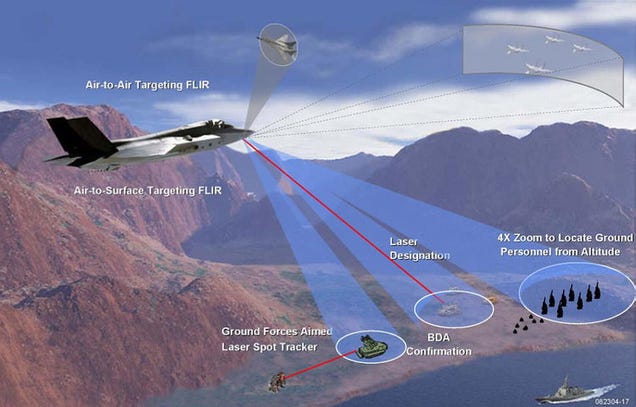
Largely
what the article states is perfectly accurate, but there are caveats.
First off, yes the F-35's EOTS hardware is now dated as it was based on
emerging technology that would be included in the first generation
SNIPER targeting pod, which is now more than 10 years old. Although some
of the internal components of the systems can be upgraded, apparently
it is not a plug-and-play affair. All the systems on the F-35 are
'fused' and many are related to one another. If something requires more
processing power, cooling or power where will that processing power,
cooling or power come from?

There are
also limitations as to just how much EOTS can be upgraded even if it
were replaced in full by a totally new system. This is due to the tight
internal dimensions that the systems is housed in within the F-35's
nose, as well as the field-of-view of the faceted sapphire glass window
that it looks out of.
Bottom
line, the system probably could could be upgraded for higher-resolution
and magnification, but it would not be a cheap or easy affair when
compared with strapping on a new targeting pod and integrating into an
F-16's 'discreet' avionics suite.
Now, what
about the F-35's lack of a infrared pointer, which have become a common
and highly praised tool for identifying and cross-checking targets with
Joint Terminal Air Controllers (JTACS) on the ground and with other
aircraft in the battle-space? There is no getting around it, this is a
tool the F-35 lacks and will continue to lack without any foreseeable
ability to retrofit one.
What about
the F-35 lacking the ability to downlink live video from its targeting
system directly to controllers on the ground? Well, once again, this is a
big void that will be left in the F-35's repertoire, and will increase
its chances of fratricide or hitting the wrong target during close air
support missions.
The Remotely Operated Video Enhanced Receiver (ROVER)
was developed urgently following the attacks of September 11th and the
subsequent invasion of Afghanistan. By the mid 2000s, fighter aircraft
equipped with ROVER were able to dowlink the exact images collected by
their targeting pods to controllers in the fight below. Many have stated
that this single technology has been the most revolutionary since
precision guided munitions when it comes to providing fast and accurate
air support for forces on the ground. Today, video downlinks have only
improved and are a regular part of the CAS equation. Many targeting pods
have this capability built directly into their housings so that the
aircraft itself needs little modification to field it.
The fact
that the world's most advanced jet fighter does not have a simple video
downlink capability along the same lines as ROVER is a testimant as to
just how little the close air support mission has been factored into the
F-35 design. This has not been only since its inception, but over the
last decade and a half of close air support being the primary mission
for US and NATO fighters. You would think that over the last decade
retrofitting this somewhat simple capability into the F-35 would have
been a top priority, but to this day there are no apparent plans to fit
the F-35 with ROVER or anything else like it.
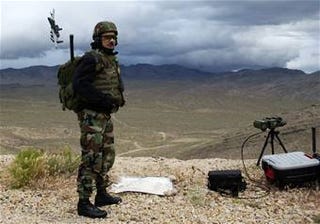
So by and
large The Daily Beast's report on the dismal state of the F-35's EOTS is
accurate, and another reminder that we cannot believe the USAF brass
when it comes to claims that the F-35 can replace existing fighters in
the CAS role on an equal if not superior level. Additionally, this info
makes the idea that the F-35 can take over the A-10's unique mission set
even more laughable.
Even with
these glaring limitations, there may be a somewhat easy, yet crude
solution to the vast majority of the F-35's EOTS issues:
Hang
a modern targeting pod off one of the F-35's wing stations for close
air support missions in non high-threat air combat environments.
I know what
you are thinking: "But won't that totally degrade the F-35's stealth
edge?" The answer to your question is unequivocally yes, but the
likelihood of providing widespread CAS in very non-permissible
environment is doubtful, especially over a long periods of time. Also,
the F-35 will most likely carry some ordinance externally anyway during
missions in lower-threat environments. For missions where forces are
inserted into highly contested territory or for battlefield interdiction
missions, the F-35 will have to do without ROVER, an Infrared Pointer
and a super-high definition infrared and optical targeting system. It is
a reasonable trade-off with no other alternative available. Stealth
always comes with a penalty, this is one of them and tactics can be
worked up to lessen the impact of the F-35's CAS targeting capabilities.
For instance, relying on the JTAC's use of their laser designator to
paint, or 'sparkle' targets for identification more often, as the F-35
has a laser spot tracking capabilities.
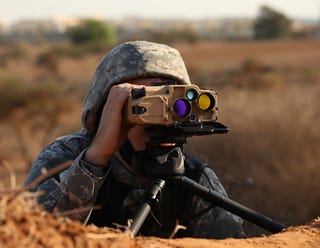
What
is not acceptable is deploying the F-35 to provide precision close air
support in a permissible air combat environment, as we have done for the
last decade and a half, and have it rely on its clearly limited
internal targeting systems. But seeing as the F-35 will replace so many
other aircraft, such as the F-16, supposedly the A-10, not to mention
the Hornet and the Harrier, it will have to be able to provide an equal
or superior capability mix. Thus hanging a state-of-the-art targeting
pod off the jet's wing, and integrating into the 'sensor fuzed' F-35
pilot interface, will be an absolute must if the EOTS system cannot be
upgraded and a video downlink added. Still, just going with the pod
would probably be a much cheaper and future-proof option.
In
all fairness, the F-35 may lack some key close air support capabilities
found on other aircraft, but it also has some capabilities that no other
fighter has that will aid in that mission. The biggest being, once
again, a previously unrealized level of sensor fusion and intuitive
man-machine interface. Whereas an F-16 pilot has to operate his or her
systems and sensors largely as individual devices, the F-35's sensors
and systems work as a team seamlessly.
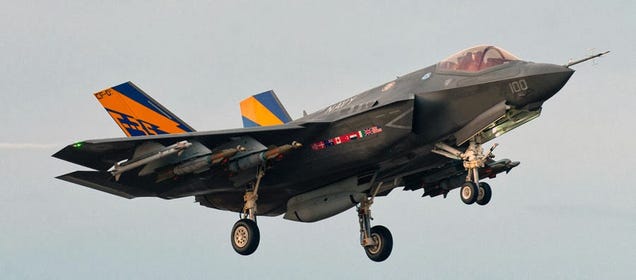
For
instance, the F-35 pilot can simply look at a target and instantly cue
every sensor to that point in space. Radar mapping, EOTS imagery,
data-link contacts, ground moving target indications and everything else
will instantly appear on the pilots Helmet Mounted Display and heads
down 'glass' panel. There is no need to manually 'push' data around the
jet's cockpit as the sensors and systems are all seeing the exact same
thing. This capability can save time and enhance situational awareness.
Additionally, the F-35's Distributed Aperture System (DAS) should be able to detect ground fire and vehicle movement,
alerting the pilot as to where those actions are taking place. Finally,
at night the F-35 pilot will have greater situational awareness than
any fighter aircrew, once again leveraging DAS, their Helmet Mounted
Display, and the jet's sensor fusion. Instead of peering through paper
towel tube-like field of view night vision goggles, the F-35 pilot can
look right through the floor of their jet at the target below in a
panoramic nature.
What I
am getting at here is that although the F-35's EOTS system is dated and
the jet clearly lacks other key close air support features, these
deficiencies can be rectified at the cost of low observability. And
although stating what the F-35 doesn't have raises eyebrows, it is a
little less controversial and headline grabbing stating what it does
have. In fact, with an advanced targeting pod added to all the F-35's
other features, it would allow the EOTS to focus on tracking the next
target to be engaged, locating friendly forces, or scanning the skies
for enemy helicopters and fighter aircraft. Simply put, two EO targeting
systems are better than one, especially when their data is fused
seamlessly together.
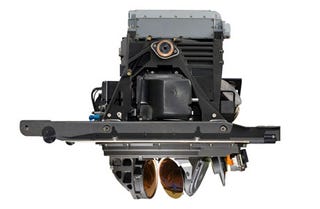
In
the end, one would think that adding an advanced targeting pod to the
F-35's external stores list would be a no-brainer and satisfy many of
these concerns, but I have a feeling that doing so would put Lockheed
and the JSF program into a place of trying to explain why a very
unstealthy targeting pod is now an option on their stealthy and very
expensive jet fighter that supposedly fields this capability internally.
So far the program has a had real challenges being open and honest with
the public about its trials and tribulations, with much of the media
being blacked out on direct access to the program as a whole. So it is
doubtful that admitting their own aircraft's limitations, along with
coming up with novel solutions for those limitations, will happen
anytime soon. In the world of F-35, no news is good news it seems these
days.

In
the meantime, the years will drag on and by the time the F-35 is truly a
combat ready aircraft as it was sold, its EOTS technology will most
likely be close to 20 years old. Just for some perspective, twenty years
ago the first generation LANTIRN targeting pods were finding their way
onto F-14 Tomcats. Also The Sign by Ace of Base was the #1 song and Friends premiered. It was a long time ago.
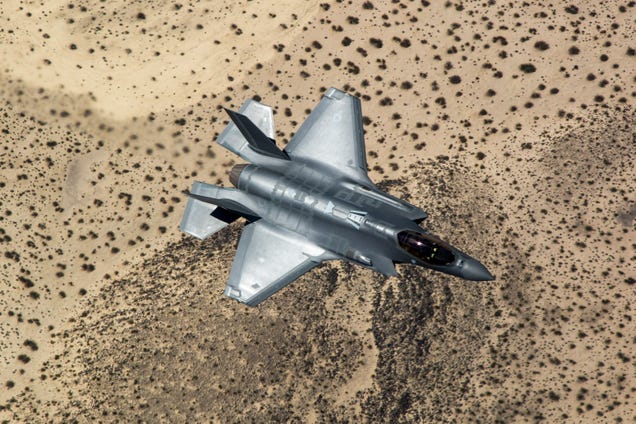
Tyler
Rogoway is a defense journalist and photographer who maintains the
website Foxtrot Alpha for Jalopnik.com You can reach Tyler with story
ideas or direct comments regarding this or any other defense topic via
the email address Tyler@Jalopnik.com
In April 2013, DARPA started a study to try to bridge the USAF and USN concepts.[4]
The Pentagon 2015 budget request has studies to lead to an acquisition program in fiscal year 2018.[5]
Frank Kendall revealed that funding for initial sixth generation fighter development would be requested in the FY 2016 budget. Next-generation fighter efforts will initially be led by DARPA under the "Air Dominance Initiative" to develop prototype X-planes. The agency as well as industry are known to have started internal research on potential sixth generation technologies for several years. Kendall confirmed that Navy and Air Force will each have variants focused on their mission requirements.[6]
The sixth-generation fighters are expected to use advanced engines such as Adaptive Versatile Engine Technology to allow longer ranges and higher performance. Risk reduction began in 2012 so that engine development can start around 2020. An engine is to be ready when fighters are introduced by the Navy in 2028 and the Air Force in 2032.[10]
USAF General Mike Hostage has said that they have yet to decide on which features will define the sixth-generation fighters.[11]
In November 2013, the Air Force Research Laboratory released a request for information (RFI) for a laser weapon that could be mounted on next-generation air dominance fighters by the 2030s. The Air Force is interested in three categories of lasers: low-power for illuminating, tracking, targeting, and defeating enemy sensors; moderate-power for protection to destroy incoming missiles; and high-power to offensively engage enemy aircraft and ground targets. The laser and systems controls are to work at altitudes from sea level to 65,000 ft at speeds from Mach 0.6 to Mach 2.5. Laser submissions are to be at technology readiness level 4 (basic components work in a lab) by October 2014, and the Air Force wants a system to be at technology readiness level 5 (system components work in a simulated environment) or higher by 2022. The RFI requests submissions with detailed descriptions in a militarily useful configuration, potential problems and solutions, and cost estimates.[12]
The RAND Corporation has recommended that the U.S. military services avoid joint programs for the development the design of a sixth-generation fighter. Studies by RAND have found that in previous joint programs, different service-specific requirements for complex programs have led to design compromises that raise costs far more than normal single-service programs. In a comparison between four recent joint service programs (F-35, Joint Strike Fighter, T-6A Texan II Joint Primary Aircraft Training System, E-8 JSTARS, V-22 Osprey) and four recent single-service programs (C-17 Globemaster III, F/A-18E/F Super Hornet, F-22 Raptor, T-45 Goshawk), costs for joint programs rose 65 percent nine years after a Milestone B decision to move into engineering and manufacturing development compared to 24 percent for independent programs during the same timespan.[13]
Engine development for sixth generation fighters is already underway to be more efficient in making jets faster and giving them a longer range. While current engines operate best at a single point in the flight envelope, newer engines could vary their bypass ratios for optimum efficiency at any speed or altitude. That would give an aircraft a much greater range, faster acceleration, and greater subsonic cruise efficiency. A variable-cycle engine could configure itself to act like a turbojet at supersonic speeds, while performing like a high-bypass turbofan for efficient cruising at slower speeds; the ability to supercruise may not be a critical requirement, but it will likely be able to with the engine type. One critical component is the adaptive fan to allow the engine to vary its bypass ratio depending on altitude and speed with a third stream of air to increase or decrease the bypass ratio. A low-bypass configuration would be used for take offs and supersonic flight, and a high-bypass configuration would have high propulsive efficiency for cruising. The U.S. Navy and Air Force have different sixth generation fighter development programs, but both services are working together on engine development. The Air Force is aiming for a Milestone A decision by 2018, with a production version to be ready possibly by 2021. Companies involved with next-generation engine development include General Electric and Pratt & Whitney.[14]
On 30 July 2014, General Mike Hostage spoke about the evolving nature of proposed sixth-generation fighter requirements at an event hosted by the Air Force Association (AFA). Since Air Combat Command released a request for information (RFI) in 2009 for industry feedback on sixth-generation air dominance technologies, teams thinking of requirements have been told not to think in terms of a "platform" like a single-seat fighter with a certain number of engines. Hostage remarked that if next-generation air dominance capabilities came from pressing "a single button on a keyboard that makes all our adversaries fall to the ground" it would be acceptable. Concepts from the Air Force and industry have so far revolved around tailless supersonic air vehicles. One of the key limitations in relying on a single platform is they have a limited weapons load, so the original RFI sought ground-based and non-kinetic solutions, with whatever sixth-generation technology being required to have a larger magazine than current fighter solutions.[15]
There are significant differences between Navy and Air Force visions for their respective next-generation jet concepts, but both agree on some fundamental characteristic aspects they will share. American sixth-generation fighters are to feature artificial intelligence as a decision aid to the pilot, similar in concept to how advanced sensor fusion is used by the F-22 and F-35. They will also have Positioning, Navigation, and Timing (PNT), and communications that allow big data movement between both service's aircraft.[16]
Air Force General Herbert Carlisle said in February 2015 that stealth is "incredibly important" for their next-generation F-X fighter. This contrasts with statements made by Chief of Naval Operations Admiral Jonathan Greenert that their F/A-XX fighter might not be so focused on survivability as to sacrifice speed and payload. Unlike the previous F-22 and F-35 development programs that depended on new technologies that drove up cost and delayed introduction, the Air Force is intending to follow a methodical path of risk reduction to include as much prototyping, technology demonstration, and systems engineering work as possible before creation of an aircraft actually starts. Carlisle describes the sixth-generation strike capability not as just an aircraft, but a system of systems including communications, space capabilities, standoff, and stand-in options.[17]
In March 2015, the Navy revealed they were working with the Air Force to potentially release joint analysis of alternatives (AoA) in 2016 for their next-generation fighters; they are allowed to take a joint AoA, then define a service solution that would be good for each service. The Navy is focusing on replacing the capabilities of the fighter with a wide range of options for the Super Hornet, as well as the EA-18G Growler. The AoA will run parallel to several other design and technology efforts including engine technology, airframe molds, broadband and IR stealth, and new ways to dominate the electromagnetic spectrum. Part of the Navy's calculus will be based on how the F-35C performs as a critical forward sensor node for the carrier air wing. How the fifth-generation F-35C integrates with the rest of the air wing to give greater capabilities than what the platform itself can do may lend itself to the sixth-generation F/A-XX.[18]
In April 2015, the Center for Strategic and Budgetary Assessments (CSBA) released a report concluding that the next-generation U.S. Air Force fighter should be larger and more resembling a bomber than a small, maneuverable traditional fighter. It analyzed over 1,450 air-to-air engagements since 1965 and found that long-range weapons and sensors have dramatically decreased instances of dogfighting. With the increase of air defense systems using electronic and infrared sensors and high-speed weapons, traditional designs relying on small size, high speed, and maneuverability may be less relevant and easier to intercept. As a result, the CSBA suggests building a fighter significantly larger relying on enhanced sensors, signature control, networked situational awareness, and very-long-range weapons to complete engagements before being detected or tracked. Larger planes would have greater range that would enable them to be stationed further from a combat zone, have greater radar and IR detection capabilities, and carry bigger and longer-range missiles. One airframe could be fitted with various attachments to fill several roles. The concept of a small number of large, intercontinental and heavily-armed combat aircraft could link itself to the development of the Long Range Strike Bomber.[19]
Lockheed Martin's Skunk Works division has revealed a conceptual next-generation fighter design that offers the first hints of an ambitious, long-term technology strategy for the new class of tactical aircraft that will emerge after 2030. The concept was published in a 2012 calendar, which was distributed to journalists. Lockheed Martin has called for greater speed, range, stealth and self-healing structures.[21]
In January 2015, Northrop Grumman revealed it had stood up teams dedicated to developing a sixth-generation fighter and that it would compete for the next fighter. Individual teams were created to focus on the specific separate requirements for the Navy and Air Force. The company indicates it is looking at a supersonic tailless jet, something never created before due to complexity; it may also be optionally manned.[22]
On 26 August 2013, Russia revealed it would proceed with development of a sixth-generation jet fighter. They say the aircraft will most likely be pilotless. However, they would not skip completing development of fifth-generation fighter projects, like the Sukhoi T-50.[24]
France has abandoned any attempt to develop an indigenous fifth-generation fighter and have moved resources directly to development of a sixth-generation fighter aircraft.[25]
On the 29th of July 2014, "IHS Jane’s" reported that a House of Commons Defence Select Committee had published a report in late July 2014 about the UK's future, "post-2030 combat aviation force structure". The report highlighted a possibility of the UK committing to a next generation fighter program to potentially replace the Eurofighter Typhoon post-2030.[26]
The Long Range Strike Bomber (LRS-B) is a proposed long-range strategic bomber for the United States Air Force,[1] intended to be a heavy-payload stealth aircraft capable of carrying thermonuclear weapons.[2] Initial capability is expected in the mid-2020s. A request for proposal
to develop the aircraft was issued in July 2014. The Air Force plans to
purchase 80–100 LRS-B aircraft at a cost of $550 million each (2010
dollars). A development contract was awarded to Northrop Grumman in October 2015.
On 11 December 2009, Gates said that the QDR had shown the need for both manned and unmanned long range strike and that the 2011 budget would likely include funding for the future bomber.[9] The USAF plans for the new bomber to be multi-role with intelligence, surveillance, and reconnaissance (ISR) capabilities.[10] As a bomber, the LRS-B will be under Air Force Global Strike Command, while ISR assets are managed by the 25th Air Force of Air Combat Command.[11]
In 2010, Andrew Krepinevich, director of the Center for Strategic and Budgetary Assessments, questioned a reliance on short range aircraft like the F-35 to manage China in a future conflict and promoted reducing the F-35 buy in favor of a longer range platform like the Next-Generation Bomber; then-United States Secretary of the Air Force Michael Wynne rejected this plan in 2007.[12][13][14] During debate on the New START treaty in December 2010, several senators raised the LSR-B as a reason to oppose or delay ratification.[15][16]
On 6 January 2011, Secretary of Defense Gates made a speech on the U.S. defense budget for FY 2012, which announced major investment in developing a long-range, nuclear-capable bomber, also to be optionally remotely piloted. He also said the aircraft "will be designed and developed using proven technologies, an approach that should make it possible to deliver this capability on schedule and in quantity. It is important that we begin this project now to ensure that a new bomber can be ready before the current aging fleet goes out of service. The follow on bomber represents a key component of a joint portfolio of conventional deep-strike capabilities — an area that should be a high priority for future defense investment given the anti-access challenges our military faces."[17] In July 2011, Joint Chief Vice Chairman James Cartwright called for a large UAV instead of a manned aircraft, including for the nuclear mission.[18] Retired Air Force colonel and Center for Strategic and Budgetary Assessments analyst Mark Gunzinger has called for an optionally manned bomber, stating that purely unmanned bombers would be at a disadvantage without direct human pilot awareness and vulnerable to communication disruption.[19]
In March 2011, the USAF decided to purchase 80 to 100 aircraft.[20][21] The Global Strike Command indicated that one requirement for the bomber is to carry a weapon of similar effect to the Massive Ordnance Penetrator.[22][23] In addition to the strategic bombing, tactical bombing, and prompt global strike roles typical for a bomber, the aircraft is to be part of a family of systems responsible for ground surveillance and electronic attack.[24] The Obama Administration in its 2012 budget request asked for $197 million and a total of $3.7 billion over five years to develop the bomber, including modular payloads for intelligence, surveillance, reconnaissance (ISR), electronic attack (EA), and communications.[25][26] It shall be nuclear-capable, but shall not be certified as such until older bombers are set to retire.[27][28]
In 2011, the House Armed Services Committee added language that would require two engine programs for the bomber; Ashton Carter objected that the addition would interfere with plans to reuse an existing engine.[29] Reportedly, the two most likely engines are the Pratt & Whitney PW9000 engine, which uses a combination of Pratt & Whitney F135 and commercial turbofan technology, and a derivative of the General Electric/Rolls-Royce F136.[30][31] In May 2011, Air Force Undersecretary Erin Conaton announced that a program office was being set up for the bomber.[32] The USAF asked for $292 million for the program in its 2013 budget request.[33] The program has also been referred to as "Long-Range Strike-B" (LRS-B).[34] In 2012, former Pentagon weapons tester Thomas P. Christie speculated that the bomber program had been initiated so that the Air Force would have a sacrificial program to offer during anticipated defense budget shortfalls.[35] The USAF seems committed to the program, given a lack of other non-nuclear options to deal with "deeply buried and/or hardened targets,"[36][37] and committed two percent of their investment budget to the project, compared to three percent to sustain existing bombers.[38]
As of August 2013, the USAF believes that the LRS-B can reach Initial Operating Capability (IOC) in 2025. Reportedly, the main risk is funding, in light of the F-35 Lightning II's acquisition difficulties and a lack of an "urgent threat". Prior bomber programs were hindered by a lack of funding, only 21 B-2 Spirits were produced out of 132 planned and fewer B-1 Lancers were built than were envisioned; both programs were scaled down due to spiraling per aircraft costs. Research funding was allocated, as stealthy technologies to counter anti-access/area-denial threats were spared from budget cuts. The USAF stated the LRS-B is a top priority as it is believed that China will overcome the B-2's low-observable features by the 2020s. Where possible, existing technologies and proven subsystems will be used in order to keep it within budget, instead of developing new and riskier ones. Components such as engines and radars may be off-the-shelf or adaptions of existing models, such as derivative technologies of the F-35. The LRS-B is intended to perform any long range mission, rather than one specialized mission, which drove up the cost of the B-2. The USAF expects it to cost $1 billion each with development costs factored in, and aims for a per-aircraft cost of $550 million, considered reasonable for a limited production run military aircraft.[39]
On 25 October 2013, Boeing and Lockheed Martin announced their teaming up for the LRS-B. Boeing will be the prime contractor. The two companies previously joined together for the program in 2008, but the partnership ended in 2010 when requirements shifted. Boeing believes that as the program had evolved, they can readdress their partnership to specifically address requirements. The team has Boeing's bomber experience and Lockheed Martin's stealth experience. At the time of the announcement, official details about the LRS-B were that it will likely be optionally manned and use stealth technology.[40] On 30 January 2014, Northrop Grumman stated their intention to invest in developing needed technology for the bomber, such as stealth designs, mission management systems, and autonomous controls.[41]
In January 2014, General Schwartz said that the Pentagon should abandon plans to outfit the F-35 with nuclear weapons in favor of the LRS-B. A 2010 Nuclear Posture Review stated that replacing the F-16 with the F-35 retains dual conventional and nuclear delivery capabilities for USAF fighters. The Congressional Budget Office determined that upgrading the F-35 for nuclear deployment would cost $350 million over the next decade. Schwartz said that without financial support from NATO, where some nuclear-capable F-35s would be deployed, those funds should be transferred to the LRS-B. At the same time, Congress cut funding for the B61 nuclear bomb, stripping $10 million from F-35 integration and $34.8 million for life extension; Schwartz stated that B61's life extension must proceed.[42]
On 20 February 2014, the USAF reasserted the bomber's need at the annual Air Force Association Air Warfare Symposium in Orlando, Fla. It was stated it will be fielded in the mid-2020s, and between 80 and 100 of the bombers will be procured. Lt. Gen. Burton Field clarified the 80 to 100 range is due to uncertainty over the price rather than a figure representing the minimum number of bombers needed to mitigate risk.[43][44] Some USAF leaders expect the unit cost limit of $550 million per aircraft will be exceeded with additional equipment added to the airframe. The cost goal is to set design constraints to prevent extra requirements for capability growth desires and untested technologies that would increase the price more from being incorporated during development. Though the final cost may be greater than planned, a fixed price objective is expected to keep average procurement costs affordable.[45] Rather than the price ceiling being too low to meet requirements, the USAF sees it as them and the potential contractor being disciplined about the bomber's missions and roles. Research and development expenses are likely to be "significant", but not expected to be double the cost of production aircraft.[46]
The USAF intended to release a full request for proposals (RFP), a final RFP, and begin the competition for the Long-Range Strike Bomber in fall 2014. Two teams, Northrop Grumman and Boeing–Lockheed Martin, were working on pre-proposals for the competition.[47] In June 2014, the USAF revealed that the LRS-B RFP would be released "soon," with proposals to be submitted by fall 2014 and evaluations completed in early 2015, with a contract award after that. Some public information includes that it will be operational in the mid-2020s, based on existing technologies, have a large payload, may possibly be optionally-manned, and is being designed to work with a “family of systems” that includes ISR, electronic attack, and communication systems. Early aircraft will be designed around fixed requirements with mature technologies that will be adaptable through open architecture for future sensor and weapons capabilities.[48] Although the LRS-B request for proposals (RFP) was to be released by the end of June, the USAF hesitated to publicly announce it to keep the process fair and less likely to give sensitive information to "potential adversaries". Public announcements of future acquisition milestones are to be "released as appropriate."[49]
Northrop Grumman could base production in Florida if they won the contract, which would provide tax credits, while California passed a bill offering tax credits to the manufacturer if they build it in their state, which would mainly benefit the Boeing–Lockheed Martin team.[50][51] On 14 August 2014, the California legislature passed a measure to apply tax benefits equally to prime and subcontractors. The previous measure only applied to subcontractors, meaning Lockheed Martin as part of the Boeing–Lockheed Martin team, placing Northrop Grumman at a near half-billion-dollar disadvantage in the bidding; the new measure levels the tax benefit field by also applying them to prime contractors, as Northrop Grumman has no subcontractor and also has operations in Palmdale.[52]
With a target price of $550 million per aircraft, Defense News quoted a source with knowledge of the program predicting that the LRS-B may be smaller than the B-2, perhaps half the size, powered by two engines in the Pratt & Whitney F135 power class.[53] The target unit cost of $550 million is based on 2010 dollars and is $606 million in 2016 dollars.[54] One of the program's main effects will be its impact on the industrial base; three of the country's five largest defense firms are competing. After the LRS-B, the USAF will not have another major attack aircraft program until the 2030s for a new fighter, with a follow-on bomber after that. With that stretch of time in between, the loser may be forced to leave the industry entirely; Northrop Grumman would likely not retain the infrastructure required for the next major undertaking, and Boeing's main aircraft field is now its commercial products.[55][56] Industrial impact may cause any contract to be contested by Congress from representatives that receive campaign donations from a company whose award would create jobs for constituents. In addition to competing with other USAF priorities, budgets may put the LRS-B at odds with other services' priorities such as the Ohio Replacement Submarine.[53]
In April 2015, Pentagon undersecretary for acquisition Frank Kendall revealed that individual technologies for the LRS-B will be competed to enhance flexibility, increase competition, and drive down costs. This means even though one team will build the aircraft, other competitors will have the chance to compete for sustainment and upgrade features.[57] Although a contract was planned to be awarded in early summer 2015, it was pushed back to September 2015 to sure up requirements. Prolonging this part of the process is seen as a time and money-saver later in the acquisition to ensure the resulting bomber can be useful over a 50-year lifespan.[58]
In September 2015, the USAF revealed that the LRS-B's development was much further along than had been publicly acknowledged, and more than usual before a contract award. Final requirements had been finalized since May 2013. Both competitors had mature proposals with prototyping activities and wind tunnel tests along with subsystems, although no demonstrator had been built. The designs are "very different" from each other with different teams on subsystems such as engines, electronic warfare suites, and communications systems; subcontractors will likely not be announced when the winner is picked. The bomber seems similar to the B-2, but more advanced using improved materials for superior low observability, similar to or smaller in size, and will operate alone or as part of a strike package with other airborne assets. Conducting of tests and risk reduction this early in the acquisition process is in part because the program has been handled by the Air Force Rapid Capabilities Office since 2011, which has more freedom in how it procures technologies. To reduce risk, the aircraft's production rate will probably remain steady and fairly modest over the course of the aircraft's production.[59][60] In late September 2015, the contract award was again delayed.[61]
On 27 October 2015, the Defense Department awarded the development contract to Northrop Grumman.[62] The initial value of the contract is $21.4 billion, but the deal could eventually be worth up to $80 billion.[63][64][65] On 6 November 2015, Boeing and Lockheed Martin protested the decision to the Government Accountability Office. Development costs have been estimated to be from US$10 to $23 billion.[66][67]
The ADaptive Versatile ENgine Technology (or ADVENT) program is an aircraft engine development program run by the United States Air Force with the goal of developing an efficient variable cycle engine for next generation military aircraft in the 20,000 lbf (89 kN) thrust class.
In October 2009, Rolls-Royce was awarded the Phase II contract to continue component testing and integrate the developed technologies into a technology demonstrator engine.[2] GE Aviation was also awarded funds to continue development of their technology demonstration core, which was unexpected as the ADVENT program had originally called for a single contractor to be selected for Phase II.[5]
USAF officials have denied that the program is an attempt to create a backup engine program for the F-35.[6]
With the threat of the GE/RR F136, Pratt & Whitney has funded an adaptive fan variant of its F135, that may qualify for the follow-on Adaptive Engine Technology Development (AETD) program under the US Air Force Research Laboratory.[7]
In 2012, GE was chosen to continue its ADVENT work into the AETD program.[8] Pratt & Whitney was selected over Rolls Royce and GE to continue the AETD program to mature fuel-efficient, high-thrust powerplants.[9]
Operational testing of the engine is expected to begin in 2013.[2]
In 2014, Chuck Hagel requested a $1 billion investment in the engine technology.[10] A government official has warned that sequestration risks ending the program.[11]
F/A-XX is a development and acquisition program for a future sixth-generation air superiority fighter to replace the United States Navy's F/A-18E/F Super Hornet beginning in 2025. A requirement was first identified in June 2008.[1]
The F/A-XX is being pursued as F/A-18 Super Hornets will reach the end of their 9,000 hours of service life by the early 2030s. Aside from the option of buying more F-35Cs, the F/A-XX is seeking to create a new aircraft to replace the Super Hornet's capability and mission set. An open architecture design is desired, so different sensors, payloads, and weapons can be plugged in for a specific mission, and be able to be moved around for multiple different missions on different days or different sorties. The resulting open architecture design is likely to take shape depending on which style of new propulsion system is presented by the aircraft industry. Unmanned, manned, and optionally manned systems are being considered. An Analysis of Alternatives (AOA) was expected to begin in 2014, with a fighter to be introduced around 2030. Just as the F-35C will replace aging F/A-18 Hornets and complement Super Hornets, the F/A-XX will replace aging Super Hornets in the 2030s and complement the F-35C.[3]
On 9 September 2014, the Navy announced that an AoA for the F/A-XX aircraft would begin in 2015. Meetings with industry will be held focusing on building new aircraft to meet the requirement, developing a family of systems (FoS) approach, and discussing mission systems, avionics, and new next-generation weapons systems. One approach could create a minimum cost F/A-XX that uses high cost, high performance weapons to defeat threats; according to the Navy's Naval Integrated Fire Control-Counter Air (NIFC-CA) battle network concept, an individual platform would not need to have a full suite of sensors and rely on off-board data-linked information from other platforms to provide targeting information and guide weapons launched from the platform. The F/A-XX platforms will be made to carry missiles, have power and cooling systems for directed energy weapons, and have sensors that can target small radar cross-section targets; cyber warfare platforms at a tactical level as part of a FoS are being explored. While the Navy is working with the U.S. Air Force on a next-generation tactical fighter, there is significant disagreement over the Air Force's claims that adaptive-cycle jet engine technology, where the ratios of bypass and compression airflow can be made variable to improve efficiency, can be scaled to benefit a carrier-based fighter.[4][5]
Although the F/A-XX platform will be a sixth-generation fighter aircraft, the Navy is reluctant to talk about a new aircraft because the project is still in the very early stages of development. A range of next-generation technologies may be explored including maximum sensor connectivity, super cruise ability, and electronically configured "smart skins." Maximum connectivity refers to massively increased communications and sensor technology, such as having the ability to connect with satellites, other aircraft, and anything providing real-time battlefield information. Engine technologies like scramjets would enable an aircraft to cruise at supersonic speeds without needing an afterburner. Smart skins would have sensors and electronics integrated into the fuselage of the aircraft itself to increase the technological ability of the sensors while reducing drag and increasing speed and maneuverability.[6]
Chief of Naval Operations Jonathan Greenert speculated in February 2015 that the F/A-XX would not rely on speed or stealth as much as previous generation jet fighters due to better signature detection and proliferating high-speed anti-aircraft weapons. Instead, the fighter would carry a new spectrum of weapons to overwhelm or suppress enemy air defenses. Greenert favors an optionally manned aircraft for a modular section that can either hold a pilot or more sensors. The payload of the F/A-XX will likely match or exceed the Super Hornet's payload.[7]
In May 2015, Secretary of the Navy Ray Mabus stated that the F/A-XX should be unmanned.[8]
In July 2009, Boeing unveiled a sixth-generation fighter concept the F/A-XX requirement. It was a two-seat, twin-engined tailless jet
with a blended wing. Although it has a tandem cockpit, Boeing said it
can be manned or unmanned depending on the mission. The fighter concept
is in the 40,000 lb (18,000 kg) weight class. The Northrop Grumman X-47B that was chosen for the UCAS-D program has also been proposed for the F/A-XX effort.[1][9]
In a 31 May 2011 disclosure to Congress, the Department of Defense revealed that they were considering buying more F-35C fighters to replace 556 Super Hornets. The DOD plans to replace the older F/A-18C/D Hornets with 220 Lightning IIs. In March 2011, a Navy analysis of alternatives showed that they may buy more F-35C aircraft, develop a new platform, or do both for their NGAD fighter program.[10]
Boeing unveiled an updated F/A-XX sixth-generation fighter concept in April 2013. The concept is a tailless twin-engine stealth fighter available in manned and unmanned configurations. It has canards, which usually compromises the frontal radar cross-section, but the lack of a tail shows an emphasis on all-aspect stealth. It also has diverterless supersonic inlets similar to the F-35. The manned version seems to have restricted rearward visibility without the aid of a sensor.[11]
Sixth-generation jet fighter
From Wikipedia, the free encyclopedia
A sixth-generation jet fighter is a conceptualized class of fighter aircraft design more advanced than the fifth-generation jet fighters which are currently in service in the United States and in development in other countries. The United States Air Force and United States Navy are anticipated to field their first sixth-generation fighters in the 2025–30 time frame.[1] The USAF is pursuing development and acquisition of a sixth-generation fighter through the F-X program to replace the F-22 Raptor, and the U.S. Navy is pursuing a similar program called the Next Generation Air Dominance to replace the F/A-18E/F Super Hornet.[2]
Contents
History
On October 10, 2012, Under Secretary of Defense for Acquisition, Technology and Logistics Frank Kendall justified the need to start the program.[3]In April 2013, DARPA started a study to try to bridge the USAF and USN concepts.[4]
The Pentagon 2015 budget request has studies to lead to an acquisition program in fiscal year 2018.[5]
Frank Kendall revealed that funding for initial sixth generation fighter development would be requested in the FY 2016 budget. Next-generation fighter efforts will initially be led by DARPA under the "Air Dominance Initiative" to develop prototype X-planes. The agency as well as industry are known to have started internal research on potential sixth generation technologies for several years. Kendall confirmed that Navy and Air Force will each have variants focused on their mission requirements.[6]
Design concepts
Dubbed the "Next Generation Tactical Aircraft"/"Next Gen TACAIR",[7] the USAF seeks a fighter with "enhanced capabilities in areas such as reach, persistence, survivability, net-centricity, situational awareness, human-system integration and weapons effects," a November 4, 2010 presolicitation notice states. “The future system will have to counter adversaries equipped with next generation advanced electronic attack, sophisticated integrated air defense systems, passive detection, integrated self-protection, directed energy weapons, and cyber attack capabilities. It must be able to operate in the anti-access/area-denial environment that will exist in the 2030–50 timeframe.”[8][9]The sixth-generation fighters are expected to use advanced engines such as Adaptive Versatile Engine Technology to allow longer ranges and higher performance. Risk reduction began in 2012 so that engine development can start around 2020. An engine is to be ready when fighters are introduced by the Navy in 2028 and the Air Force in 2032.[10]
USAF General Mike Hostage has said that they have yet to decide on which features will define the sixth-generation fighters.[11]
In November 2013, the Air Force Research Laboratory released a request for information (RFI) for a laser weapon that could be mounted on next-generation air dominance fighters by the 2030s. The Air Force is interested in three categories of lasers: low-power for illuminating, tracking, targeting, and defeating enemy sensors; moderate-power for protection to destroy incoming missiles; and high-power to offensively engage enemy aircraft and ground targets. The laser and systems controls are to work at altitudes from sea level to 65,000 ft at speeds from Mach 0.6 to Mach 2.5. Laser submissions are to be at technology readiness level 4 (basic components work in a lab) by October 2014, and the Air Force wants a system to be at technology readiness level 5 (system components work in a simulated environment) or higher by 2022. The RFI requests submissions with detailed descriptions in a militarily useful configuration, potential problems and solutions, and cost estimates.[12]
The RAND Corporation has recommended that the U.S. military services avoid joint programs for the development the design of a sixth-generation fighter. Studies by RAND have found that in previous joint programs, different service-specific requirements for complex programs have led to design compromises that raise costs far more than normal single-service programs. In a comparison between four recent joint service programs (F-35, Joint Strike Fighter, T-6A Texan II Joint Primary Aircraft Training System, E-8 JSTARS, V-22 Osprey) and four recent single-service programs (C-17 Globemaster III, F/A-18E/F Super Hornet, F-22 Raptor, T-45 Goshawk), costs for joint programs rose 65 percent nine years after a Milestone B decision to move into engineering and manufacturing development compared to 24 percent for independent programs during the same timespan.[13]
Engine development for sixth generation fighters is already underway to be more efficient in making jets faster and giving them a longer range. While current engines operate best at a single point in the flight envelope, newer engines could vary their bypass ratios for optimum efficiency at any speed or altitude. That would give an aircraft a much greater range, faster acceleration, and greater subsonic cruise efficiency. A variable-cycle engine could configure itself to act like a turbojet at supersonic speeds, while performing like a high-bypass turbofan for efficient cruising at slower speeds; the ability to supercruise may not be a critical requirement, but it will likely be able to with the engine type. One critical component is the adaptive fan to allow the engine to vary its bypass ratio depending on altitude and speed with a third stream of air to increase or decrease the bypass ratio. A low-bypass configuration would be used for take offs and supersonic flight, and a high-bypass configuration would have high propulsive efficiency for cruising. The U.S. Navy and Air Force have different sixth generation fighter development programs, but both services are working together on engine development. The Air Force is aiming for a Milestone A decision by 2018, with a production version to be ready possibly by 2021. Companies involved with next-generation engine development include General Electric and Pratt & Whitney.[14]
On 30 July 2014, General Mike Hostage spoke about the evolving nature of proposed sixth-generation fighter requirements at an event hosted by the Air Force Association (AFA). Since Air Combat Command released a request for information (RFI) in 2009 for industry feedback on sixth-generation air dominance technologies, teams thinking of requirements have been told not to think in terms of a "platform" like a single-seat fighter with a certain number of engines. Hostage remarked that if next-generation air dominance capabilities came from pressing "a single button on a keyboard that makes all our adversaries fall to the ground" it would be acceptable. Concepts from the Air Force and industry have so far revolved around tailless supersonic air vehicles. One of the key limitations in relying on a single platform is they have a limited weapons load, so the original RFI sought ground-based and non-kinetic solutions, with whatever sixth-generation technology being required to have a larger magazine than current fighter solutions.[15]
There are significant differences between Navy and Air Force visions for their respective next-generation jet concepts, but both agree on some fundamental characteristic aspects they will share. American sixth-generation fighters are to feature artificial intelligence as a decision aid to the pilot, similar in concept to how advanced sensor fusion is used by the F-22 and F-35. They will also have Positioning, Navigation, and Timing (PNT), and communications that allow big data movement between both service's aircraft.[16]
Air Force General Herbert Carlisle said in February 2015 that stealth is "incredibly important" for their next-generation F-X fighter. This contrasts with statements made by Chief of Naval Operations Admiral Jonathan Greenert that their F/A-XX fighter might not be so focused on survivability as to sacrifice speed and payload. Unlike the previous F-22 and F-35 development programs that depended on new technologies that drove up cost and delayed introduction, the Air Force is intending to follow a methodical path of risk reduction to include as much prototyping, technology demonstration, and systems engineering work as possible before creation of an aircraft actually starts. Carlisle describes the sixth-generation strike capability not as just an aircraft, but a system of systems including communications, space capabilities, standoff, and stand-in options.[17]
In March 2015, the Navy revealed they were working with the Air Force to potentially release joint analysis of alternatives (AoA) in 2016 for their next-generation fighters; they are allowed to take a joint AoA, then define a service solution that would be good for each service. The Navy is focusing on replacing the capabilities of the fighter with a wide range of options for the Super Hornet, as well as the EA-18G Growler. The AoA will run parallel to several other design and technology efforts including engine technology, airframe molds, broadband and IR stealth, and new ways to dominate the electromagnetic spectrum. Part of the Navy's calculus will be based on how the F-35C performs as a critical forward sensor node for the carrier air wing. How the fifth-generation F-35C integrates with the rest of the air wing to give greater capabilities than what the platform itself can do may lend itself to the sixth-generation F/A-XX.[18]
In April 2015, the Center for Strategic and Budgetary Assessments (CSBA) released a report concluding that the next-generation U.S. Air Force fighter should be larger and more resembling a bomber than a small, maneuverable traditional fighter. It analyzed over 1,450 air-to-air engagements since 1965 and found that long-range weapons and sensors have dramatically decreased instances of dogfighting. With the increase of air defense systems using electronic and infrared sensors and high-speed weapons, traditional designs relying on small size, high speed, and maneuverability may be less relevant and easier to intercept. As a result, the CSBA suggests building a fighter significantly larger relying on enhanced sensors, signature control, networked situational awareness, and very-long-range weapons to complete engagements before being detected or tracked. Larger planes would have greater range that would enable them to be stationed further from a combat zone, have greater radar and IR detection capabilities, and carry bigger and longer-range missiles. One airframe could be fitted with various attachments to fill several roles. The concept of a small number of large, intercontinental and heavily-armed combat aircraft could link itself to the development of the Long Range Strike Bomber.[19]
Examples
In September 2011, Boeing unveiled a sixth-generation fighter concept for the U.S. Navy and Air Force. It is planned to have supercruise and fly faster and further than the F-35 Lightning II. Boeing is self-funding the project until an official fighter program starts to have a design ready.[20]Lockheed Martin's Skunk Works division has revealed a conceptual next-generation fighter design that offers the first hints of an ambitious, long-term technology strategy for the new class of tactical aircraft that will emerge after 2030. The concept was published in a 2012 calendar, which was distributed to journalists. Lockheed Martin has called for greater speed, range, stealth and self-healing structures.[21]
In January 2015, Northrop Grumman revealed it had stood up teams dedicated to developing a sixth-generation fighter and that it would compete for the next fighter. Individual teams were created to focus on the specific separate requirements for the Navy and Air Force. The company indicates it is looking at a supersonic tailless jet, something never created before due to complexity; it may also be optionally manned.[22]
International development
In 2010, the Japanese Ministry of Defence exposed the concept of sixth-generation national product jet fighter.[23]On 26 August 2013, Russia revealed it would proceed with development of a sixth-generation jet fighter. They say the aircraft will most likely be pilotless. However, they would not skip completing development of fifth-generation fighter projects, like the Sukhoi T-50.[24]
France has abandoned any attempt to develop an indigenous fifth-generation fighter and have moved resources directly to development of a sixth-generation fighter aircraft.[25]
On the 29th of July 2014, "IHS Jane’s" reported that a House of Commons Defence Select Committee had published a report in late July 2014 about the UK's future, "post-2030 combat aviation force structure". The report highlighted a possibility of the UK committing to a next generation fighter program to potentially replace the Eurofighter Typhoon post-2030.[26]
See also
Long Range Strike Bomber
From Wikipedia, the free encyclopedia
| Long Range Strike Bomber | |
|---|---|
| Project for | Strategic stealth bomber |
| Issued by | United States Air Force |
| Proposals | • Boeing/Lockheed Martin • Northrop Grumman |
| Date concluded | 27 October 2015 |
| Outcome | Northrop Grumman entry selected |
| Predecessor programs | Next-Generation Bomber |
Contents
History
Origins
On 19 May 2009, Air Force Chief of Staff General Norton Schwartz said that the USAF's focus in the 2010 budget was on "Long-range strike, not next-generation bomber" and will push for this in the Quadrennial Defense Review.[3] In June 2009, the two teams working on next-generation bomber proposals were told to "close up shop".[4] On 16 September 2009, Secretary of Defense Robert Gates endorsed the concept of a new bomber but insisted that it must be affordable,[5] stating: "What we must not do is repeat what happened with our last manned bomber. By the time the research, development, and requirements processes ran their course, the aircraft, despite its great capability, turned out to be so expensive – $2 billion each in the case of the B-2 – that less than one-sixth of the planned fleet of 132 was ever built."[6] On 5 October 2009, Gates' successor Ashton Carter said that the DoD was still deciding if the USAF needed a new bomber and that, if approved, the aircraft would need to handle reconnaissance as well as strike missions.[7] In July 2010, Carter said he intended to "make affordability a requirement" for the next-generation intelligence and strike platform.[8]On 11 December 2009, Gates said that the QDR had shown the need for both manned and unmanned long range strike and that the 2011 budget would likely include funding for the future bomber.[9] The USAF plans for the new bomber to be multi-role with intelligence, surveillance, and reconnaissance (ISR) capabilities.[10] As a bomber, the LRS-B will be under Air Force Global Strike Command, while ISR assets are managed by the 25th Air Force of Air Combat Command.[11]
In 2010, Andrew Krepinevich, director of the Center for Strategic and Budgetary Assessments, questioned a reliance on short range aircraft like the F-35 to manage China in a future conflict and promoted reducing the F-35 buy in favor of a longer range platform like the Next-Generation Bomber; then-United States Secretary of the Air Force Michael Wynne rejected this plan in 2007.[12][13][14] During debate on the New START treaty in December 2010, several senators raised the LSR-B as a reason to oppose or delay ratification.[15][16]
On 6 January 2011, Secretary of Defense Gates made a speech on the U.S. defense budget for FY 2012, which announced major investment in developing a long-range, nuclear-capable bomber, also to be optionally remotely piloted. He also said the aircraft "will be designed and developed using proven technologies, an approach that should make it possible to deliver this capability on schedule and in quantity. It is important that we begin this project now to ensure that a new bomber can be ready before the current aging fleet goes out of service. The follow on bomber represents a key component of a joint portfolio of conventional deep-strike capabilities — an area that should be a high priority for future defense investment given the anti-access challenges our military faces."[17] In July 2011, Joint Chief Vice Chairman James Cartwright called for a large UAV instead of a manned aircraft, including for the nuclear mission.[18] Retired Air Force colonel and Center for Strategic and Budgetary Assessments analyst Mark Gunzinger has called for an optionally manned bomber, stating that purely unmanned bombers would be at a disadvantage without direct human pilot awareness and vulnerable to communication disruption.[19]
In March 2011, the USAF decided to purchase 80 to 100 aircraft.[20][21] The Global Strike Command indicated that one requirement for the bomber is to carry a weapon of similar effect to the Massive Ordnance Penetrator.[22][23] In addition to the strategic bombing, tactical bombing, and prompt global strike roles typical for a bomber, the aircraft is to be part of a family of systems responsible for ground surveillance and electronic attack.[24] The Obama Administration in its 2012 budget request asked for $197 million and a total of $3.7 billion over five years to develop the bomber, including modular payloads for intelligence, surveillance, reconnaissance (ISR), electronic attack (EA), and communications.[25][26] It shall be nuclear-capable, but shall not be certified as such until older bombers are set to retire.[27][28]
In 2011, the House Armed Services Committee added language that would require two engine programs for the bomber; Ashton Carter objected that the addition would interfere with plans to reuse an existing engine.[29] Reportedly, the two most likely engines are the Pratt & Whitney PW9000 engine, which uses a combination of Pratt & Whitney F135 and commercial turbofan technology, and a derivative of the General Electric/Rolls-Royce F136.[30][31] In May 2011, Air Force Undersecretary Erin Conaton announced that a program office was being set up for the bomber.[32] The USAF asked for $292 million for the program in its 2013 budget request.[33] The program has also been referred to as "Long-Range Strike-B" (LRS-B).[34] In 2012, former Pentagon weapons tester Thomas P. Christie speculated that the bomber program had been initiated so that the Air Force would have a sacrificial program to offer during anticipated defense budget shortfalls.[35] The USAF seems committed to the program, given a lack of other non-nuclear options to deal with "deeply buried and/or hardened targets,"[36][37] and committed two percent of their investment budget to the project, compared to three percent to sustain existing bombers.[38]
As of August 2013, the USAF believes that the LRS-B can reach Initial Operating Capability (IOC) in 2025. Reportedly, the main risk is funding, in light of the F-35 Lightning II's acquisition difficulties and a lack of an "urgent threat". Prior bomber programs were hindered by a lack of funding, only 21 B-2 Spirits were produced out of 132 planned and fewer B-1 Lancers were built than were envisioned; both programs were scaled down due to spiraling per aircraft costs. Research funding was allocated, as stealthy technologies to counter anti-access/area-denial threats were spared from budget cuts. The USAF stated the LRS-B is a top priority as it is believed that China will overcome the B-2's low-observable features by the 2020s. Where possible, existing technologies and proven subsystems will be used in order to keep it within budget, instead of developing new and riskier ones. Components such as engines and radars may be off-the-shelf or adaptions of existing models, such as derivative technologies of the F-35. The LRS-B is intended to perform any long range mission, rather than one specialized mission, which drove up the cost of the B-2. The USAF expects it to cost $1 billion each with development costs factored in, and aims for a per-aircraft cost of $550 million, considered reasonable for a limited production run military aircraft.[39]
On 25 October 2013, Boeing and Lockheed Martin announced their teaming up for the LRS-B. Boeing will be the prime contractor. The two companies previously joined together for the program in 2008, but the partnership ended in 2010 when requirements shifted. Boeing believes that as the program had evolved, they can readdress their partnership to specifically address requirements. The team has Boeing's bomber experience and Lockheed Martin's stealth experience. At the time of the announcement, official details about the LRS-B were that it will likely be optionally manned and use stealth technology.[40] On 30 January 2014, Northrop Grumman stated their intention to invest in developing needed technology for the bomber, such as stealth designs, mission management systems, and autonomous controls.[41]
In January 2014, General Schwartz said that the Pentagon should abandon plans to outfit the F-35 with nuclear weapons in favor of the LRS-B. A 2010 Nuclear Posture Review stated that replacing the F-16 with the F-35 retains dual conventional and nuclear delivery capabilities for USAF fighters. The Congressional Budget Office determined that upgrading the F-35 for nuclear deployment would cost $350 million over the next decade. Schwartz said that without financial support from NATO, where some nuclear-capable F-35s would be deployed, those funds should be transferred to the LRS-B. At the same time, Congress cut funding for the B61 nuclear bomb, stripping $10 million from F-35 integration and $34.8 million for life extension; Schwartz stated that B61's life extension must proceed.[42]
On 20 February 2014, the USAF reasserted the bomber's need at the annual Air Force Association Air Warfare Symposium in Orlando, Fla. It was stated it will be fielded in the mid-2020s, and between 80 and 100 of the bombers will be procured. Lt. Gen. Burton Field clarified the 80 to 100 range is due to uncertainty over the price rather than a figure representing the minimum number of bombers needed to mitigate risk.[43][44] Some USAF leaders expect the unit cost limit of $550 million per aircraft will be exceeded with additional equipment added to the airframe. The cost goal is to set design constraints to prevent extra requirements for capability growth desires and untested technologies that would increase the price more from being incorporated during development. Though the final cost may be greater than planned, a fixed price objective is expected to keep average procurement costs affordable.[45] Rather than the price ceiling being too low to meet requirements, the USAF sees it as them and the potential contractor being disciplined about the bomber's missions and roles. Research and development expenses are likely to be "significant", but not expected to be double the cost of production aircraft.[46]
The USAF intended to release a full request for proposals (RFP), a final RFP, and begin the competition for the Long-Range Strike Bomber in fall 2014. Two teams, Northrop Grumman and Boeing–Lockheed Martin, were working on pre-proposals for the competition.[47] In June 2014, the USAF revealed that the LRS-B RFP would be released "soon," with proposals to be submitted by fall 2014 and evaluations completed in early 2015, with a contract award after that. Some public information includes that it will be operational in the mid-2020s, based on existing technologies, have a large payload, may possibly be optionally-manned, and is being designed to work with a “family of systems” that includes ISR, electronic attack, and communication systems. Early aircraft will be designed around fixed requirements with mature technologies that will be adaptable through open architecture for future sensor and weapons capabilities.[48] Although the LRS-B request for proposals (RFP) was to be released by the end of June, the USAF hesitated to publicly announce it to keep the process fair and less likely to give sensitive information to "potential adversaries". Public announcements of future acquisition milestones are to be "released as appropriate."[49]
Competitive phase
The USAF released its RFP for the LRS-B on 9 July 2014. By entering the competitive phase of acquisition, the USAF is limited with what it is able to release, and few details were expected to be made public until the contract is awarded in the second quarter of 2015. The LRS-B is expected to replace the B-52 fleet, possibly replace a portion of the B-1 fleet, and complement the B-2 fleet.Northrop Grumman could base production in Florida if they won the contract, which would provide tax credits, while California passed a bill offering tax credits to the manufacturer if they build it in their state, which would mainly benefit the Boeing–Lockheed Martin team.[50][51] On 14 August 2014, the California legislature passed a measure to apply tax benefits equally to prime and subcontractors. The previous measure only applied to subcontractors, meaning Lockheed Martin as part of the Boeing–Lockheed Martin team, placing Northrop Grumman at a near half-billion-dollar disadvantage in the bidding; the new measure levels the tax benefit field by also applying them to prime contractors, as Northrop Grumman has no subcontractor and also has operations in Palmdale.[52]
With a target price of $550 million per aircraft, Defense News quoted a source with knowledge of the program predicting that the LRS-B may be smaller than the B-2, perhaps half the size, powered by two engines in the Pratt & Whitney F135 power class.[53] The target unit cost of $550 million is based on 2010 dollars and is $606 million in 2016 dollars.[54] One of the program's main effects will be its impact on the industrial base; three of the country's five largest defense firms are competing. After the LRS-B, the USAF will not have another major attack aircraft program until the 2030s for a new fighter, with a follow-on bomber after that. With that stretch of time in between, the loser may be forced to leave the industry entirely; Northrop Grumman would likely not retain the infrastructure required for the next major undertaking, and Boeing's main aircraft field is now its commercial products.[55][56] Industrial impact may cause any contract to be contested by Congress from representatives that receive campaign donations from a company whose award would create jobs for constituents. In addition to competing with other USAF priorities, budgets may put the LRS-B at odds with other services' priorities such as the Ohio Replacement Submarine.[53]
In April 2015, Pentagon undersecretary for acquisition Frank Kendall revealed that individual technologies for the LRS-B will be competed to enhance flexibility, increase competition, and drive down costs. This means even though one team will build the aircraft, other competitors will have the chance to compete for sustainment and upgrade features.[57] Although a contract was planned to be awarded in early summer 2015, it was pushed back to September 2015 to sure up requirements. Prolonging this part of the process is seen as a time and money-saver later in the acquisition to ensure the resulting bomber can be useful over a 50-year lifespan.[58]
In September 2015, the USAF revealed that the LRS-B's development was much further along than had been publicly acknowledged, and more than usual before a contract award. Final requirements had been finalized since May 2013. Both competitors had mature proposals with prototyping activities and wind tunnel tests along with subsystems, although no demonstrator had been built. The designs are "very different" from each other with different teams on subsystems such as engines, electronic warfare suites, and communications systems; subcontractors will likely not be announced when the winner is picked. The bomber seems similar to the B-2, but more advanced using improved materials for superior low observability, similar to or smaller in size, and will operate alone or as part of a strike package with other airborne assets. Conducting of tests and risk reduction this early in the acquisition process is in part because the program has been handled by the Air Force Rapid Capabilities Office since 2011, which has more freedom in how it procures technologies. To reduce risk, the aircraft's production rate will probably remain steady and fairly modest over the course of the aircraft's production.[59][60] In late September 2015, the contract award was again delayed.[61]
On 27 October 2015, the Defense Department awarded the development contract to Northrop Grumman.[62] The initial value of the contract is $21.4 billion, but the deal could eventually be worth up to $80 billion.[63][64][65] On 6 November 2015, Boeing and Lockheed Martin protested the decision to the Government Accountability Office. Development costs have been estimated to be from US$10 to $23 billion.[66][67]
See also
Adaptive Versatile Engine Technology
From Wikipedia, the free encyclopedia
Cut-away view of a prospective ADVENT engine
Contents
Objective
The objective of ADVENT is to develop an engine that is optimized for several design points, rather than the traditional single point. Instead of having an engine that is designed solely for high speed (like many current fighter engines are) or for high fuel efficiency (like many current commercial engines are), the final ADVENT engine would be designed to operate at both those conditions.[1] Specific goals include reducing average fuel consumption by 25% and reducing the temperature of cooling air produced by the engine.[2]Applications
The ADVENT engine was originally targeted at the Air Force's 2018 Next-Generation Bomber, but uncertainty in that program has led Rolls-Royce (RR), one of the primary developers involved with the project, to predict that the ADVENT engine will be better suited for a potential 2020 engine upgrade for the F-35 Lightning II. RR, who is partnered with GE Aviation on the embattled F136 alternate engine for the F-35, has suggested that the ADVENT development contracts are all the more reason to continue the F136, as any engine upgrade from Pratt & Whitney (makers of the F135 engine currently used in the F-35) would have to be separately funded, either internally or to additional government cost.[3]History
The ADVENT program is one of several related development projects being pursued under the Air Force's Versatile Affordable Advanced Turbine Engines (VAATE) program. After being announced in April 2007, Rolls-Royce and GE Aviation were awarded Phase I contracts in August 2007 to explore concepts, develop and test critical components, and begin preliminary designs of an engine.[1][4]In October 2009, Rolls-Royce was awarded the Phase II contract to continue component testing and integrate the developed technologies into a technology demonstrator engine.[2] GE Aviation was also awarded funds to continue development of their technology demonstration core, which was unexpected as the ADVENT program had originally called for a single contractor to be selected for Phase II.[5]
USAF officials have denied that the program is an attempt to create a backup engine program for the F-35.[6]
With the threat of the GE/RR F136, Pratt & Whitney has funded an adaptive fan variant of its F135, that may qualify for the follow-on Adaptive Engine Technology Development (AETD) program under the US Air Force Research Laboratory.[7]
In 2012, GE was chosen to continue its ADVENT work into the AETD program.[8] Pratt & Whitney was selected over Rolls Royce and GE to continue the AETD program to mature fuel-efficient, high-thrust powerplants.[9]
Operational testing of the engine is expected to begin in 2013.[2]
In 2014, Chuck Hagel requested a $1 billion investment in the engine technology.[10] A government official has warned that sequestration risks ending the program.[11]
See also
- Related development
F/A-XX Program
From Wikipedia, the free encyclopedia
(Redirected from Next Generation Air Dominance)
An early design concept of the Boeing F/A-XX.
Requirements
In April 2012, the Navy issued a formal request for information for the F/A-XX. It calls for an air superiority fighter with multi-role capabilities to replace the F/A-18E/F Super Hornet and EA-18G Growler aircraft in the 2030s, while complementing the F-35C Lightning II and UCLASS unmanned aircraft, that can operate in anti-access/area-denial environments. The aircraft must be capable of operating from Navy Nimitz-class and Gerald R. Ford-class aircraft carriers. Primary missions include air combat, ground attack, surface warfare, and close air support. Other missions can include air-to-air refueling, reconnaissance, surveillance, and target acquisition (RSTA), and electronic attack. There is consideration for manned, unmanned, and optionally manned platforms.[2]The F/A-XX is being pursued as F/A-18 Super Hornets will reach the end of their 9,000 hours of service life by the early 2030s. Aside from the option of buying more F-35Cs, the F/A-XX is seeking to create a new aircraft to replace the Super Hornet's capability and mission set. An open architecture design is desired, so different sensors, payloads, and weapons can be plugged in for a specific mission, and be able to be moved around for multiple different missions on different days or different sorties. The resulting open architecture design is likely to take shape depending on which style of new propulsion system is presented by the aircraft industry. Unmanned, manned, and optionally manned systems are being considered. An Analysis of Alternatives (AOA) was expected to begin in 2014, with a fighter to be introduced around 2030. Just as the F-35C will replace aging F/A-18 Hornets and complement Super Hornets, the F/A-XX will replace aging Super Hornets in the 2030s and complement the F-35C.[3]
On 9 September 2014, the Navy announced that an AoA for the F/A-XX aircraft would begin in 2015. Meetings with industry will be held focusing on building new aircraft to meet the requirement, developing a family of systems (FoS) approach, and discussing mission systems, avionics, and new next-generation weapons systems. One approach could create a minimum cost F/A-XX that uses high cost, high performance weapons to defeat threats; according to the Navy's Naval Integrated Fire Control-Counter Air (NIFC-CA) battle network concept, an individual platform would not need to have a full suite of sensors and rely on off-board data-linked information from other platforms to provide targeting information and guide weapons launched from the platform. The F/A-XX platforms will be made to carry missiles, have power and cooling systems for directed energy weapons, and have sensors that can target small radar cross-section targets; cyber warfare platforms at a tactical level as part of a FoS are being explored. While the Navy is working with the U.S. Air Force on a next-generation tactical fighter, there is significant disagreement over the Air Force's claims that adaptive-cycle jet engine technology, where the ratios of bypass and compression airflow can be made variable to improve efficiency, can be scaled to benefit a carrier-based fighter.[4][5]
Although the F/A-XX platform will be a sixth-generation fighter aircraft, the Navy is reluctant to talk about a new aircraft because the project is still in the very early stages of development. A range of next-generation technologies may be explored including maximum sensor connectivity, super cruise ability, and electronically configured "smart skins." Maximum connectivity refers to massively increased communications and sensor technology, such as having the ability to connect with satellites, other aircraft, and anything providing real-time battlefield information. Engine technologies like scramjets would enable an aircraft to cruise at supersonic speeds without needing an afterburner. Smart skins would have sensors and electronics integrated into the fuselage of the aircraft itself to increase the technological ability of the sensors while reducing drag and increasing speed and maneuverability.[6]
Chief of Naval Operations Jonathan Greenert speculated in February 2015 that the F/A-XX would not rely on speed or stealth as much as previous generation jet fighters due to better signature detection and proliferating high-speed anti-aircraft weapons. Instead, the fighter would carry a new spectrum of weapons to overwhelm or suppress enemy air defenses. Greenert favors an optionally manned aircraft for a modular section that can either hold a pilot or more sensors. The payload of the F/A-XX will likely match or exceed the Super Hornet's payload.[7]
In May 2015, Secretary of the Navy Ray Mabus stated that the F/A-XX should be unmanned.[8]
Entries
The Boeing F/A-XX concept design as of 2013.
In a 31 May 2011 disclosure to Congress, the Department of Defense revealed that they were considering buying more F-35C fighters to replace 556 Super Hornets. The DOD plans to replace the older F/A-18C/D Hornets with 220 Lightning IIs. In March 2011, a Navy analysis of alternatives showed that they may buy more F-35C aircraft, develop a new platform, or do both for their NGAD fighter program.[10]
Boeing unveiled an updated F/A-XX sixth-generation fighter concept in April 2013. The concept is a tailless twin-engine stealth fighter available in manned and unmanned configurations. It has canards, which usually compromises the frontal radar cross-section, but the lack of a tail shows an emphasis on all-aspect stealth. It also has diverterless supersonic inlets similar to the F-35. The manned version seems to have restricted rearward visibility without the aid of a sensor.[11]

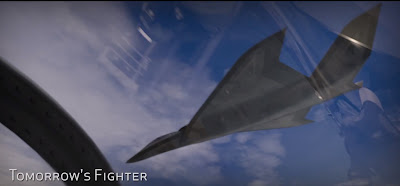
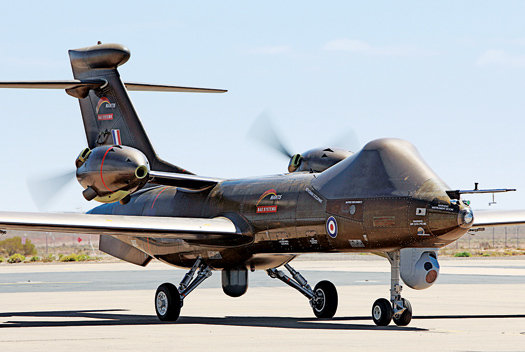


 Air Force Magazine – Different Generation of Fighters
Air Force Magazine – Different Generation of Fighters

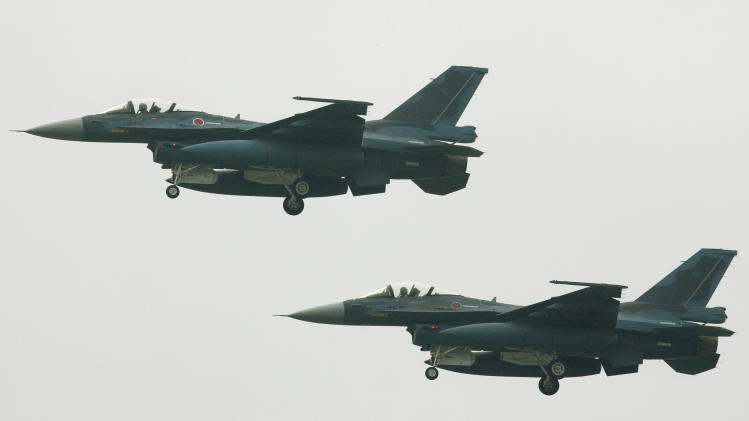
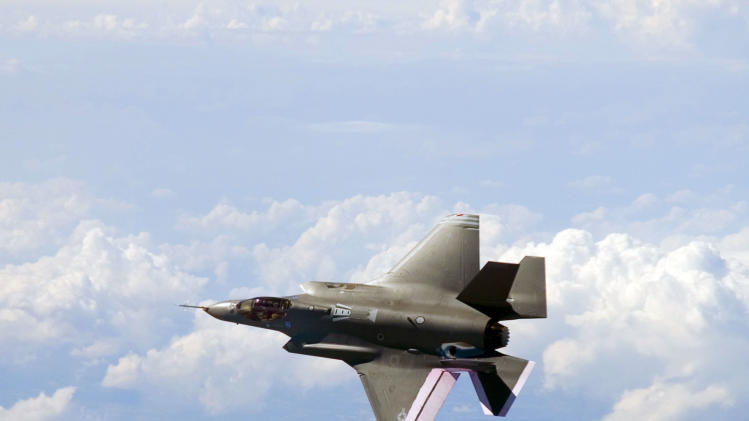



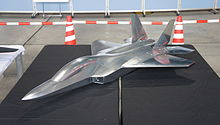

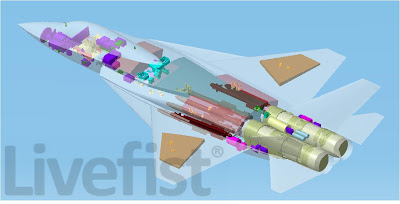














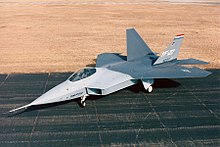




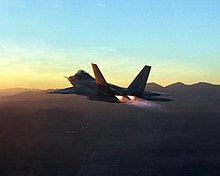

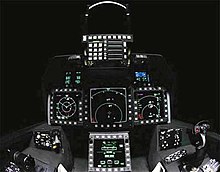



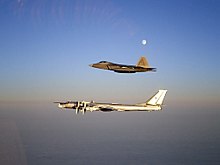



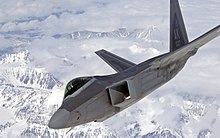




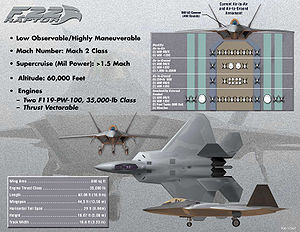




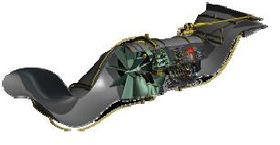

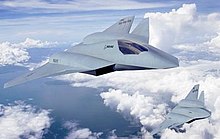
No comments:
Post a Comment